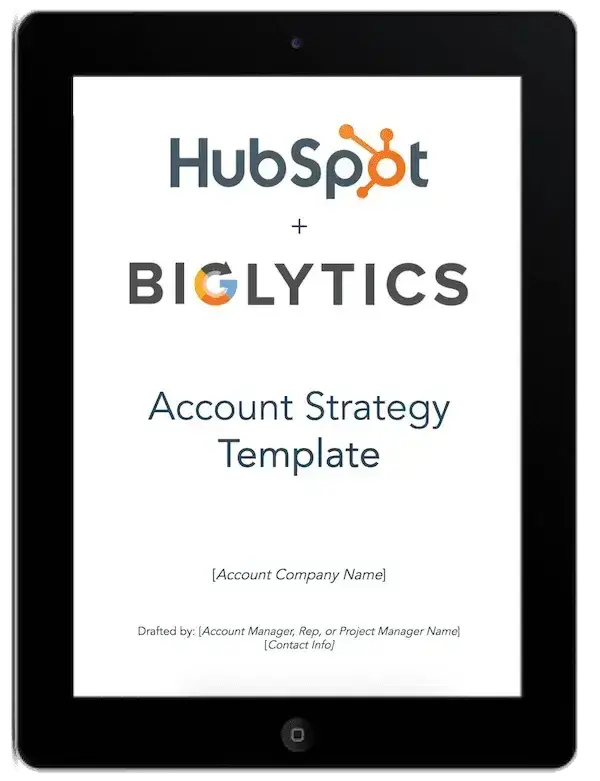5 best CRMs for private equity businesses in 2025
The CRM needs of private equity firms are fundamentally different from those of traditional sales-driven organizations. In an industry where deal flow, relationship intelligence, and portfolio performance are critical, private equity professionals require a CRM beyond simple contact management. They need a centralized system that […]
Marketing
7 best CRMs for fitness businesses in 2025
The fitness industry is growing fast, but managing member relationships is getting harder. The global fitness industry is estimated to be worth $257 billion in 2025 and continues to expand at a rapid pace. With this growth comes fierce competition, making it essential for fitness […]
Marketing
7 best CRMs for logistics businesses in 2025
Running a logistics business is far from easy. From juggling multiple shipments to coordinating with carriers, tracking deliveries, and keeping customers informed, you have your hands full with responsibilities. Therefore, a Customer Relationship Management (CRM) system is a must-have to keep yourself and your organization […]
Marketing



This behavioral science principle can make your billboard go viral, here’s how
Is billboard advertising still relevant today? Yes, all because of costly signaling. This behavioral science principle states that expensive signals indicate higher quality or status. Although a broader concept about human behavior, costly signaling absolutely applies to advertising. What, after all, is the value of […]
MarketingIs billboard advertising still relevant today? Yes, all because of costly signaling. This behavioral science principle states that expensive signals indicate higher quality or status.
Although a broader concept about human behavior, costly signaling absolutely applies to advertising. What, after all, is the value of a social media ad? While highly effective, social ads are cheap, so everyone can buy them and crowd the space. But a billboard? That takes some real money.
So, let’s dive into how the costly signaling applies specifically to billboard advertising. Then, I’ll share some top viral billboard examples.
What is costly signaling?
Costly signaling theory is the idea that the higher cost you put into something, the more other people will value it.
Sounds simple right? Well, I do have two caveats. The first is that costly signaling reflects perceived cost. People still need to interpret and assign value to signaled information. Secondly, the signal of cost in these cases is reliable because only individuals who can afford to send the signal possess the signaled quality.
To put it in marketing terms, costly signaling means that the more resources you put into sharing your message, the higher people will rate it. Goes beyond money and includes time, effort, pain, or any sort of expense spent to make the message more persuasive.
I think advertising executive Rory Sutherland puts it perfectly: “The meaning and significance attached to something is in direct proportion to the expense with which it is communicated.”

Costly Signaling Example
Costly signaling goes beyond textbooks and can be seen in the real world. A 2013 study titled “Extreme Rituals Promote Prosocially” analyzed how expenses can increase religious donations.
The study took place in Mauritius during the Hindu festival of Thaipusam. The researchers wanted to see if the effort and pain the worshipers put into their ritual affected the amount they donated to the local temple.
Researchers studied two types of rituals:
- A low-ordeal ritual. This consisted of a group that only sang and prayed.
- High-ordeal ritual (Kavadi). This ritual was very intense. Participants pierced their skin with needles and hooks, carried heavy structures, and walked barefoot uphill for over 4 hours.
Those who watched the low-ordeal singing group gave just 80 rupees as a donation, while those who watched the high-ordeal rituals gave 65% more, 132 rupees on average. In this case, observing pain made people value the ritual more.
I like to visualize costly signaling as a positive vector in which the two elements are directly proportional: higher cost = greater meaning.
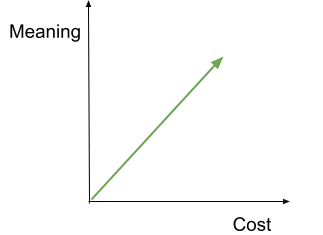
This is why asking your partner to marry you at a McDonald’s drive-thru is unlikely to succeed. Asking them after a 10-course tasting menu at a 3-star restaurant will have a higher chance of success.
Although you’re the same person asking the same question, the latter situation is likely to go better for you because of the higher perceived cost and effort. In other words, it’s more meaningful.
Billboards and Costly Signaling
I believe advertisers can take the finding from behavioral science and apply it to their billboards. That’s especially true for costly signaling. So, I conducted a silly yet simple experiment to find out.
I showed 200 British people a fake ad for my podcast, Nudge. Half of the participants in my experiment saw just the ad. The remaining 50% saw the same ad superimposed onto a billboard.
Now, a billboard signals expense. To some less than attentive viewers, they may believe I paid to display that billboard myself. Or perhaps they thought that this survey was the prerequisite to creating the billboard. Either way, the billboard signaled more expense than the ad alone.
Did the billboard variant make people more likely to listen to my podcast? Yes. It made Brits 61% more likely to tune in.

Now, rather than just creating a billboard, marketers can sink more expense into the billboard with novel designs. That novelty will showcase a higher expense, boosting perceived value even more. I’ll share a few standout examples below.
Viral Billboard Examples
1. Netflix
How should Netflix advertise 1,000 new shows? Netflix could communicate the message on a simple building-side billboard, but that would miss the chance to highlight the effort.
So, instead, they created a sprawling, oversized billboard on a giant mural. It listed dozens of shows, which should make viewers value the ad and Netflix more highly.
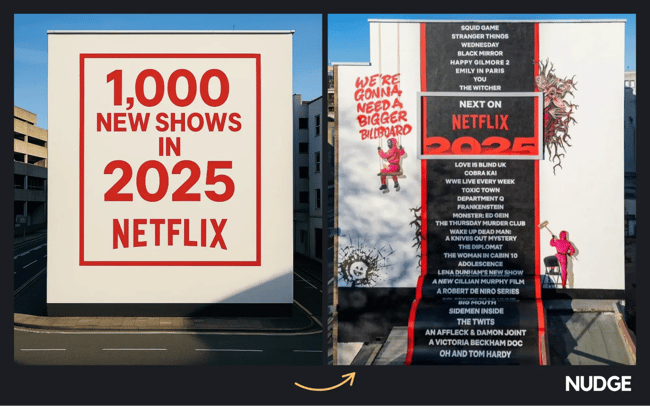
Why This Works
Simply buying billboard space is not enough. You need to capitalize on that space (and your spend) to revolutionize it. I find the list of shows a powerful way of showing — not telling — what Netflix has to offer. In my opinion, they did a phenomenal job of demonstrating value through their expense.
2. Dracula
Back in 2021, I attended a New Year’s Eve party in South London. Across the road, I saw an ad for a new BBC show. The billboard had dozens of knives stabbed into the poster. A light lit the knives at night, casting a Dracula-shaped shadow across the ad.
The billboard was an incredible piece of art, visible only at night, and must have taken a great deal of effort to create. This expense stuck with me, and I’ve never forgotten this ad, even after a booze-filled evening.
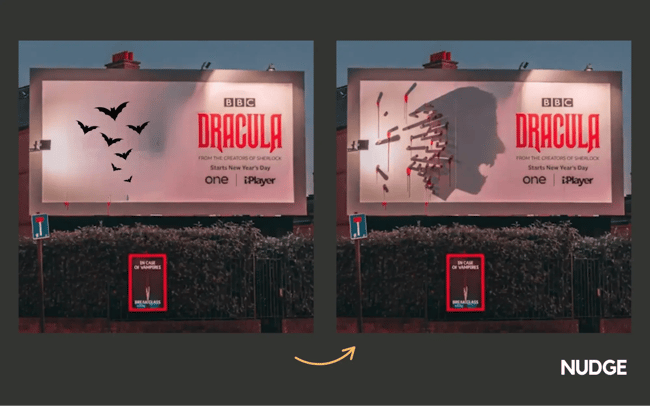
Why This Works
This billboard is unique, clever, and artistic. It is absolutely arresting and communicates the effort of the creative designer behind it. How can a viewer’s curiosity not be piqued?
Going viral entails being unforgettable, so taking billboard design to the next level is a sure way to succeed.
3. Specsavers
“Should have gone to Specsavers” is the humorous slogan for this well-known optician.
All of Specsavers’ ads play on the idea that those with dodgy eyesight need a checkup. But, rather than simply stating their slogan, they use costly, mistake-ridden billboards to emphasize their slogan.
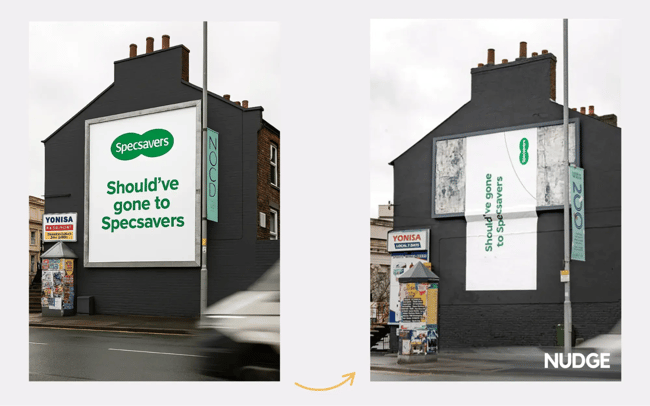
Why This Works
This billboard is eye-catching because it looks wrong. Then, you read it and have a good laugh. Its humor cleverly captures the reason why someone might need a new pair of glasses. I think that makes it unforgettable.
If you can “embody” what you’re selling through your billboard, your message will stick better, and people will value your effort more.
Science Tells Us the Cost Is Worth It
We value billboards more when we see the expense taken to create them. Don’t get me wrong, creating a viral billboard involves a lot of creativity, but behavioral science reveals a common thread behind many of them. The higher the expense, the greater the chance of virality.
My biggest takeaway is that the cost is worth it. When people perceive the cost of an ad, they will not only value it more but also be more likely to spend more in response. If they perceive something as cheap and low-effort, they will respond in kind.
So, invest in creative design and go big with your billboard spend, and you will see a higher return on your investment.
![]()
30 creative lead generation ideas to try (& why marketers recommend them)
Coming up with strong lead generation ideas isn’t always easy. I’ve found myself putting it off more than once — not because it’s not important, but because it often feels like a hit-or-miss. And I’m not alone. In the last year, 45% of businesses reported […]
MarketingComing up with strong lead generation ideas isn’t always easy. I’ve found myself putting it off more than once — not because it’s not important, but because it often feels like a hit-or-miss. And I’m not alone. In the last year, 45% of businesses reported struggling to generate enough leads.
Cold outreach, building lists, trying to cut through the noise — it’s a lot, especially when people are busy and hesitant to engage.
But I’ve also learned that lead generation doesn’t have to feel like a grind. The most effective strategies I’ve seen are the ones that offer something valuable upfront. They don’t just push a product; they solve a real problem, answer a question, or make someone’s job easier.
In this article, I’ve pulled together a list of creative lead generation ideas that do exactly that. I’ve spoken with marketers who’ve tested these methods, so if you’re looking for lead gen tactics that feel more relevant, and more human, these are a solid place to start.
Table of Contents
- Social Media Lead Generation
- Networking Lead Generation
- Content Marketing Lead Generation
- B2B Lead Generation
- Video Marketing Lead Generation
- Email Marketing Lead Generation
- Event-Based Lead Generation
- Referral and Partnership Lead Generation
- Freemium and Trial-Based Lead Generation
Social Media Lead Generation
1. Partner with influencers.
One of the quickest ways to gain traction and drum up new leads is to partner with influencers within your niche.
Influencers have a special way of connecting with their audiences, and when they showcase your brand, you expand your reach to a larger audience.
Pro tip: Nicole Rossi, Marketing Coordinator at Custom Neon, shared that the key to an effective influencer partnership is to create landing pages relevant to your campaign.
Rossi said, “Partnering with influencers has also been an incredibly successful lead-generation tool for us. Influencers who share our brand values partner with us, and together we develop giveaway campaigns or offer special discount codes to their audience. With this approach, we can reach unexplored markets and produce leads through forms or landing sites made specifically for the campaign.”
2. DM-first lead magnets.
Instead of asking people to click a link in bio or fill out a form, one smart play I recommend is delivering your lead magnet directly via DMs.
Here’s how it works: post something interesting, like a results breakdown, framework, or hot take, and say “Comment ‘Guide’ and I’ll send you the PDF.”
This turns a passive scroll into an active opt-in. Algorithms love the engagement boost, and you get warmer leads because people are raising their hand before you ever message them. I’ve seen this blow up on Instagram, especially when paired with helpful, non-salesy follow-up messages. It feels natural, like a conversation, not a funnel.
3. Social polls that lead to a CTA.
Polls are a great way to segment your audience and spark lead gen. When you create a poll around a key pain point (e.g., “What’s your biggest challenge with scaling sales?”), you get two things: insights and intent signals.
After the poll, follow up in the comments or via DM with a resource that matches each answer. For instance, “Voted for onboarding issues? Here’s our free onboarding playbook.” It’s a smooth transition from interaction to opt-in, and people appreciate the relevance.
Networking Lead Generation Ideas
4. Do a LinkedIn audit.
If LinkedIn is your jam, you could be sitting on an untapped market — your connections.
Melissa Lohrer, Founder at Waverly Ave Consulting, said, “Sometimes, your next best opportunity is already in front of you. Audit your existing LinkedIn connections — there are likely untapped opportunities sitting directly in your network. Growth isn’t always about bringing in new people but nurturing who’s already in your corner and leveraging those relationships to create momentum. This is your fastest path to conversion.”
5. Schedule coffee chats.
When it comes down to it, gaining a qualified lead starts with connecting on a human level. No-strings-attached networking is a great way to connect with members of your audience, build meaningful relationships, and begin a slow (but warm!) conversion.
Erin Pennings, a copywriter and marketing strategist, told me coffee chats are her favorite way to connect with your target audience.
Pennings said, “In my experience, the number one lead gen strategy is building relationships with other people. It‘s not networking in the traditional sense of the word, but simply about making connections. It’s not usually a fast-burn strategy because human connections take time, but it’s a great way to create an effective referral network.
“I love reaching out to people to schedule no-pitch coffee chats where the primary goal is getting to know people, and I always ask them who I can connect them with or who would be a good referral for them, and they generally reciprocate. Often I can make connections right away to support them, and then when I need to get contracts or work at the door, I know I can reach out to see if they know anyone I know.”
6. Use customer reviews in your pop-ups.
Want to build trust and brag about your clout? Consider showing off your customer reviews. Visitors lurking on your website want to know what real customers think of your product or service before they, too, take the plunge.
That’s why Johannes Karjula, CEO at Trustmary.com, uses a customer review pop-up to drive conversions.
Karjula said, “The best strategy to generate leads is to use an exit-intent popup that features customer reviews and an offer or discount code. These work especially well if someone is very close to converting: either buying or booking a meeting. If they’re about to leave, throwing social proof in their faces is great in proving that they actually need the product or service in question.”
Content Marketing Lead Generation
7. Create valuable content (blog posts, podcasts).
Your audience wants content, whether that’s a blog post, a podcast, or a video. That’s why I think content marketing remains one of the most effective and recognizable ideas for lead generation strategies.
Roland Jakob, Managing Partner of BlazeKin Media, says, “The most effective lead generation idea I‘ve encountered is the strategic use of personalized content marketing. In my experience, creating tailored content that speaks directly to your target audience’s pain points and interests is incredibly powerful. I‘ve found that when we develop in-depth blog posts, engaging videos, or insightful podcasts that genuinely address our audience’s needs, we not only attract potential leads but also establish ourselves as trusted authorities in our field, which is what you ultimately want.”
8. Share success secrets from thought leaders.
Want to provide unique value in your content? Reach out to a thought leader in your industry or even your company. By interviewing an expert to uncover their secrets, you prove to potential customers that you’re dedicated to delivering the best advice and insight out there.
And it works!
- Edelman’s 2024 report shows that 52% of decision-makers and 54% of C-suite executives spend an hour or more on average per week reading thought-leadership content.
- Four in five marketers believe thought leadership has made a positive contribution to their organization’s reputation, relationships, and revenue over the past 12 months.
- 50% of leaders say they can link thought leadership to revenue.
Below is an interview Groove conducted with Josh Pather, a wedding DJ-turned-ecommerce entrepreneur. In this article, Groove had Josh break down how he started his ecommerce business, which is one of the fastest-growing businesses in Texas.
The folks at Groove frequently interview successful founders and ask very specific questions from which everyone can learn something. Then, Groove shares those interviews with audience members on its blog.
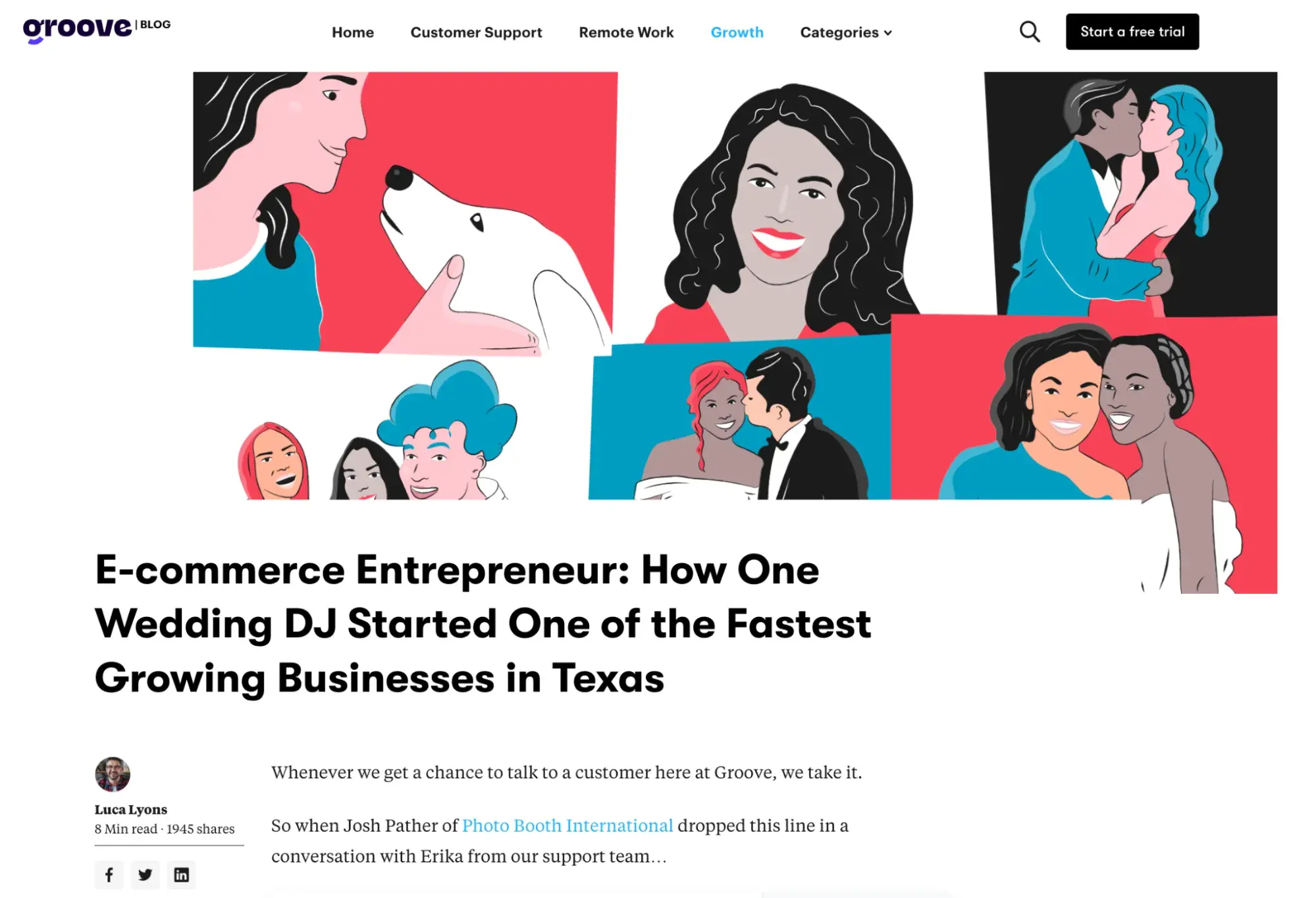
The interview with Josh is chock-full of quotes, lessons, and actionable takeaways for entrepreneurs. This touch helps further Groove’s reputation as a resource for expert information among its audience.
9. Compile real-life examples with actionable takeaways.
Finding effective examples to learn from can be equally as valuable and difficult. A list of best practices, current trends, or real-life examples in your industry is an excellent way to drive prospects to a guide or offer where they can opt in.
The Content Marketing Institute knows this and makes a point to share current content marketing trends every year in a blog post.
This blog post serves as a resource to inspire site visitors to achieve success with their marketing strategies, and ultimately, to search the website for guides and opt-in offers to improve their content game.
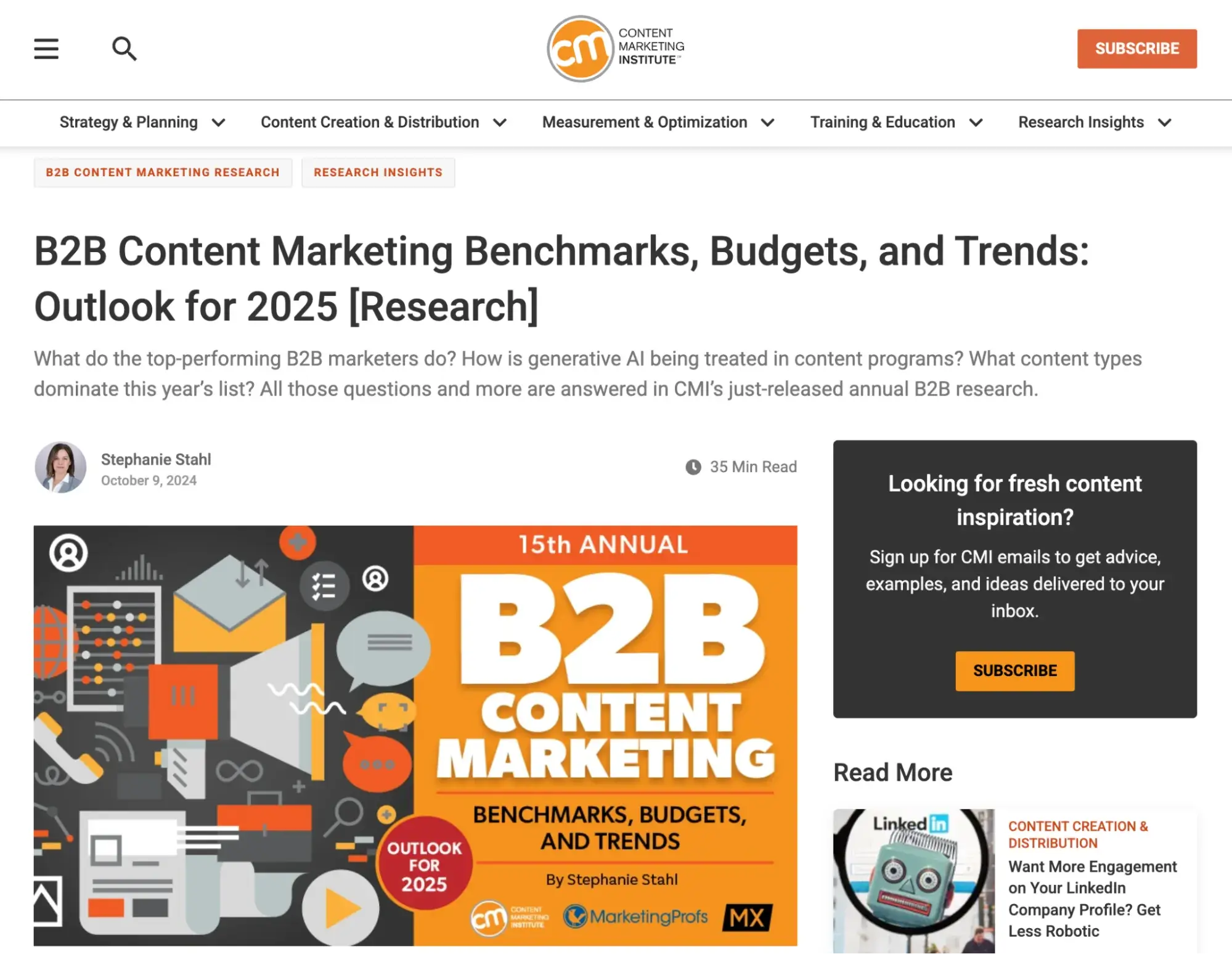
10. Show what’s working for your company.
I can’t be the only marketer who’s nosey, right?
It’s why I find sharing a transparent post that pulls back the curtain on something with which you’ve seen success (or failure) interesting. And I know your potential leads find it interesting, too.
Other companies going through a similar stage of growth — or approaching your size — can gain a lot of inspiration from transparency posts and ultimately avoid making the same mistakes.
So, consider sharing how you’ve built your platform or a lesson you’ve learned along the way. You can share your insights in a blog post or a downloadable guide.
Just don’t forget to include a final call-to-action to encourage readers to join your email list.
11. Create a handy checklist.
Who doesn‘t have a running to-do list that sometimes gets a little bit too long? If you’re planning an upcoming webinar, you can be sure there’s a lot that goes into it.
HubSpot created a 19-page webinar planning kit that marketers can download and learn how to pick a stellar webinar idea, pick great guest speakers, and host the webinar.
Pro tip: HubSpot uses the gated offer to prove its brand’s expertise on the subject and encourage kit downloads.
12. Offer insightful, downloadable case studies.
One of the best ways to gain new leads and spark interest in your products or services is to show how your brand is an asset to your clients. Case studies help get your message across while doubling as a lead magnet.
Krissy Selda, a digital marketing specialist at Array Marketing Agency, is a huge fan of case studies. Selda told me, “From experience, publishing case studies has been the most powerful lead generation tactic because they demonstrate how your business consistently meets customer expectations.
“By showcasing the value of your products or services, case studies allow potential clients to envision themselves benefiting from your success. When customers see tangible results from businesses or individuals similar to themselves, they are more inclined to engage with your product or service. This makes them one of the most effective content marketing tools for driving leads.”
13. Create an interactive quiz or tool.
Consider offering a quiz to your website visitors as a creative way to learn more about them and obtain their contact information.
The goal is to “bargain” the result of the quiz in return for a new lead, which can be very effective when done right.
Cassandra Gucwa, Founder of Menerva Digital, says tools and quizzes are “a great way to offer something that is valuable to your potential target audience and gather their email or information. Some examples of free tools would include a cost calculator, savings calculator, or a tool that checks how secure your email address is.”
A similar method is offering an interactive tool, such as the HubSpot Website Grader. The Website Grader is a free online tool that visitors can use to grade their websites against key metrics and discover ways to improve them.
To use the tool, visitors must submit their email, which provides HubSpot with new leads interested in improving their web presence.
B2B Lead Generation Ideas
14. Build interactive ROI calculators (with a personalized follow-up).
One of the smartest lead gen ideas I’ve seen in the B2B space is offering a live, interactive ROI calculator — not just a gated spreadsheet. The idea is to help your prospect visualize the value you bring using their own numbers. It’s consultative without needing a salesperson.
What really moves the needle is combining the tool with a follow-up offer. For example, after the user completes the calculator, they get a custom PDF summary and an invitation to a deeper assessment or strategy call. It’s low-pressure, but still guided.
I’ve seen companies collect qualified leads at scale this way, especially when the tool ties into a specific pain point, like cost savings, revenue growth, or time reduction.
15. Create private Slack or Discord communities.
I always recommend creating private, niche communities where your ideal B2B buyers can talk shop without distractions. Whether it’s a curated Slack group for heads of IT or a Discord server for RevOps leaders, these spaces become lead gen engines — just not in the traditional sense.
What works well is keeping the group valuable and focused: regular expert drop-ins, exclusive templates or benchmarks, even low-key AMAs. When the space is genuinely helpful, people start engaging, and over time, that trust spills over into business conversations. I’ve seen brands become the go-to solution within their own communities without ever pitching. The key is to show up as a peer, not a promoter.
16. Do micro-podcasts featuring your ideal buyers as guests.
If there’s one underrated B2B tactic that I keep seeing deliver results, it’s this: invite prospects to speak as experts on a short-form podcast or video series. Even a 10-minute “trends and tactics” conversation works. You’re giving them a platform, building a relationship, and creating content all at once.
Once that conversation happens, the door’s open to follow up. I’ve seen this get recommended to clients who struggle to get meetings through cold outreach, and they’ve reported higher conversion rates simply because the podcast invite felt like a genuine opportunity, not a sales trap. Plus, you walk away with content you can repurpose for months.
Video Marketing Lead Generation
17. Personalize video content.
89% of businesses use video as a marketing tool. And for good reason: it’s a great way to connect with qualified leads and convert them to paying clients.
Whether you use short- or long-form video, the key to video marketing lead generation is to personalize your content.
For Mike Vannelli, Creative Director of Envy Creative, personalizing video starts with understanding the unique perspectives of your audience.
Vannelli told me, “One of my favorite lead generation tactics is leveraging personalized video content. We create tailored video messages based on specific pain points or challenges a prospect is facing. It‘s not just about sending a generic promo — it’s about showing that we understand their unique needs.
“These personalized videos are then embedded in emails or used as landing page content. Adding a clickable call-to-action at the end, like scheduling a demo or downloading a valuable resource, boosts engagement like nothing else. The human touch combined with targeted messaging has consistently driven better conversion rates for us.”
18. Use mid-video CTAs in YouTube or Loom-style explainers.
Here’s a mistake I see all the time: people wait until the end of their video to add a call to action when most viewers are already gone. Instead, I suggest inserting the CTA around the 30–60% mark. This could be a button, a pop-up form, or even a voice prompt like “Want the full checklist I’m using? Grab it below.”
I’ve seen this work especially well with product explainer videos or walkthroughs. The viewer’s already invested, and that’s the perfect moment to offer a lead magnet or booking link.
Pro tip: A/B test your mid-video CTAs — small tweaks can lead to big lifts in conversion.
19. Turn webinars into a lead gen flywheel.
Webinars are a classic for a reason, but here’s the upgrade: instead of just hosting them live and moving on, chop them up into snackable video clips. Each clip should zero in on one key insight or objection, and end with a CTA to download the full version or a related resource.
This way, your one webinar becomes 10+ mini lead gen assets that work across YouTube, LinkedIn, and your email list. I’ve seen brands repurpose webinars this way and build an evergreen funnel that runs for months.
The trick is to lead with value in the clip, and only then introduce the opt-in. That makes it feel more like help, less like a pitch.
Email Marketing Lead Generation
20. Create a valuable course or guide.
A well-developed course or guide is like gaining access to a real class — for free. For busy marketers, this type of offer can prove to be incredibly valuable.
Pro tip: This approach tends to work well for in-depth topics. You can create an email course, host a course on your platform, or create a downloadable guide for visitors to read. HubSpot offers tons of free courses and downloadable guides like Introduction to Lead Generation.
These courses and guides help people with different content consumption styles get the same valuable information that’s on the blog, and it helps HubSpot generate new leads to engage with over email.
21. Provide gated offers with best practices.
When I explore a marketing tactic in a blog post or e-book, I find it helpful to know what others are doing to have success with the same method.
Compiling those best practices into a list is incredibly useful to a marketer looking to get started in a particular arena.
For example, HubSpot offers a comprehensive list of SEO best practices from a variety of experts, which aims to help its target audience achieve a greater return on investment from content marketing.
The ebook provides value for readers trying to crack a complicated marketing strategy — and in exchange for their contact information, they get insider tips from a variety of expert sources.
Event-Based Lead Generation
22. Offer webinars and live demonstrations.
If you’re looking for another lead generation idea, consider hosting seminars or live events. Webinars and live events are perfect opportunities to mingle with your audience while also providing them with useful information and new skills (and upselling your products and services!).
Cache Merrill, Founder of Zibtek, told me, “Webinars are an excellent tool for presenting one’s expertise and building trust. We try to cover the ‘correct’ topics relevant to what we do. Finally, we expect to have a very good number of conversions at the end where audiences are eager to have a closer interaction request for a consultation or a demo.”
Referral and Partnership Lead Generation
23. Create a referral ecosystem.
Lead generation doesn’t have to be a solo endeavor. I’ve mentioned working with influencers as an example of how to make conversions a team sport.
However, influencers aren’t the only people you can recruit for your lead generation efforts. Instead, ask your network for referrals.
Lohrer calls this “creating a referral ecosystem.”
Lohrer explained it to me like this: “Choose your top three clients and tell them you’re looking for more like them. Ask for introductions to their peers or advice on where to find similar high-value clients. Better yet, ask them to introduce you to someone you want to meet to make it easy for them.
“On top of that, partnering with complimentary service providers—those who work with the same client base in different ways—or those who influence your clients (think advisors or coaches) can help create a steady, mutual referral stream.”
24. Solicit brand partnerships.
Like influencer partnerships, connecting with other brands is a great way to tap into other markets and connect with a larger audience. You’ll want to ensure the brands you connect with are relevant to your niche. The more relevant the niche, the more likely their audience aligns with your own.
Roland Jakob, Managing Partner of BlazeKin Media, agrees that brand partnerships are an effective form of lead generation.
Jakob told me, “At BlazeKin Media, I’ve connected creators with major brands like Coca-Cola, Sephora, and others, driving high-quality leads by expanding reach and boosting credibility. The key is ensuring these collaborations provide real value to the brands, creators, and audience, leading to engaged prospects who are more likely to convert into loyal customers.”
Freemium and Trial-Based Lead Generation
25. Offer a free trial or a freemium product.
Is there anyone else out there who hates a free trial or product? I am pretty sure there isn’t. Everyone loves free stuff. It’s the reason offering a free trial or a freemium product works so well as a lead generation tactic.
Yevhenii Tymoshenko, Chief Marketing Officer at Skylum, understands that free trials lead to qualified leads, which is why a free trial paired with personalized marketing are their go-to lead generation ideas.
Tymoshenko told me, “Once a user is signed up for a free trial, we make use of personalized marketing to ultimately convert them.”
Free trials of a brand‘s services help get a prospect’s foot halfway through the door. If the free trial helps them and provides great value, they’re more likely to purchase the full product and become a customer.
Another similar strategy is to offer a freemium product, similar to how HubSpot offers the free forever HubSpot CRM. By offering a portion of your product or service line for free, you give users a taste of your brand and build trust and awareness among your user base.
Tymoshenko also incorporates freemium products into Skylum’s marketing operations.
He said, “We‘ve also been testing giving limited free access to certain new features of our products … This is a good way to generate qualified leads that would purchase your product in the end. And if, for some reason, that doesn’t happen, we can offer custom discounts to some users.”
SEO Lead Generation
26. Leverage the SEO power of customer reviews.
Review platforms generally have a strong presence in organic search, making them a great opportunity to expand your brand presence and get noticed by the right people.
When you encourage users to leave reviews on a third-party platform with strong SEO — like Yelp or Google — you increase the chances of being found by qualified prospects in search, without paying a dime.
Google recognizes the independent role of these sites in helping people find what they’re looking for and seems to favor review sites in search engine results.
Imagine your company on this list. There’s a high chance your product would be included in what McKinsey calls the “initial consideration set,” leading to the “moment of purchase” during the consumer decision journey.
You also outmaneuver competitors in high-value keyword searches. This is crucial considering that many B2B searches start with a generic keyword phrase.
27. Optimize your website.
Here’s a hot tip for lead generation: Don’t overlook your website. Ensuring your website is optimized and ready for the search engines is a quick way to turn it into a lead generating machine.
Colton De Vos, Marketing and Communications Specialist at Resolute Technology Solutions, told me that if your website generates lots of traffic, but only converts a few leads, then you should consider making changes to your site to encourage conversions.
De Vos said, “Invest the time to tweak your website content and design to persuade visitors to make the leap and contact your business. Make it easy for prospects to reach out. Include many easy options for them to engage, and facilitate their research of your company. Feature trust factors such as reviews, case studies, and the value your company has brought others.”
Pro tip: Consider connecting your marketing software to your website to make it easier for leads to get in contact with you.
Paid Lead Generation
28. Paid advertising.
My last lead generation idea to share is paid advertising. Think of paid ads as billboards in the online space. A great billboard catches attention and encourages the potential customer to take action of some kind.
Online paid advertising does the same thing. Plus, with the right landing page and forms, you can easily convert visitors to leads.
Sophie Musumeci, CEO and Founder of Real Entrepreneur Women, uses paid advertising as part of her lead generation efforts. But she told me there has to be a well-thought-out strategy for it to work well and convert leads.
Musumeci said, “I’m a fan of strategic paid advertising. It amplifies your reach, but it’s critical that the ads are targeted, clear, and focused on the results your audience is craving.”
You can launch paid ads on nearly every social media platform, including setting up ads on Facebook and Pinterest. You can also set up ads on Google and other search engines.
Pro tip: Wherever you decide to spend your marketing dollars, take the time to understand your audience and learn the places they hang out online. This can help you determine the best places for your ads.
29. Run a limited-time challenge with VIP perks.
Instead of promoting a static discount or product, I suggest running a time-bound challenge that taps into your audience’s goals. For example: “Join our 5-Day Glow-Up Challenge — daily skincare tips + a chance to win our bestsellers!” Or “Reset your space in 7 days — declutter tips, exclusive deals, and VIP-only surprises.”
The ad invites people to opt in via email to join the challenge, and once they do, they get daily content (dripped via email or text), sneak peeks at products, and early access to sales. The challenge creates a sense of community and momentum, while the VIP perks keep them engaged and primed to buy.
I’ve seen B2C brands build massive email lists this way in just a few weeks, and those leads often convert better than coupon chasers. Why? Because people already built a habit with your brand.
30. Run UGC-style testimonial ads.
Instead of polished brand videos, use raw, selfie-style clips from real customers talking about how your product solved a specific problem. Pair that with a lead offer like a free sample, $1 trial, or exclusive first-time bundle. The ad doesn’t push the product — it tells a story. It’s “I tried this and here’s what surprised me,” not “Here’s why you should buy.”
The magic is in how real it feels. I’ve seen these ads outperform heavily produced campaigns, especially in the beauty, wellness, and food industries, because they mimic organic content.
According to Billo, 93% of marketers who use UGC in marketing campaigns say that it performs significantly better than traditional branded content. This method works best on platforms like Facebook, Instagram, and TikTok, where people are in consumption mode but will jump at a no-brainer offer from someone relatable.
Effective Lead Generation Ideas for You
I’ve found creating an effective lead generation strategy to be an art and a science. For me, the best strategy combines several lead generation ideas, like cultivating connections with my network and offering high-value content.
You might find, however, that paid advertising or partnering with brands and influencers works better for your niche.
Whichever lead generation strategy you experiment with next, make sure the content is useful to your audience so they’ll return to your website again and again.
Editor’s note: This post was originally published in February 2017 and has been updated for comprehensiveness.
![]()
I tested 2025's most realistic AI voice tools — here’s what blew me away
AI voice technology has been moving fast for a while now. But recently, it feels like we‘ve shifted into a completely different gear. We’re not just talking about smoother narration or cleaner text-to-speech anymore. These tools are starting to sound like actual people, with emotions, […]
MarketingAI voice technology has been moving fast for a while now. But recently, it feels like we‘ve shifted into a completely different gear. We’re not just talking about smoother narration or cleaner text-to-speech anymore. These tools are starting to sound like actual people, with emotions, personalities, and conversational quirks that can genuinely fool you.
I wanted to see how far things had come, so I spent the last few weeks testing six of the most advanced AI voice tools available. Not just to see which one’s “best,” but to understand what they can actually do — where they’re useful now, and where they’re clearly heading next.
Here’s what I learned and what it means for anyone creating content, building creative campaigns, or just trying to stay ahead of the marketing curve.
The Top 6 AI Voice Tools That Actually Matter for Marketers Right Now
There are a ton of AI voice tools out there, but most don’t move the needle. These six did. Some are surprisingly usable right now. Others just made me rethink what’s possible. I tested all of them hands-on and tried to break them a little — here’s what stood out.
1. Sesame: The Emotionally Intelligent Conversationalist
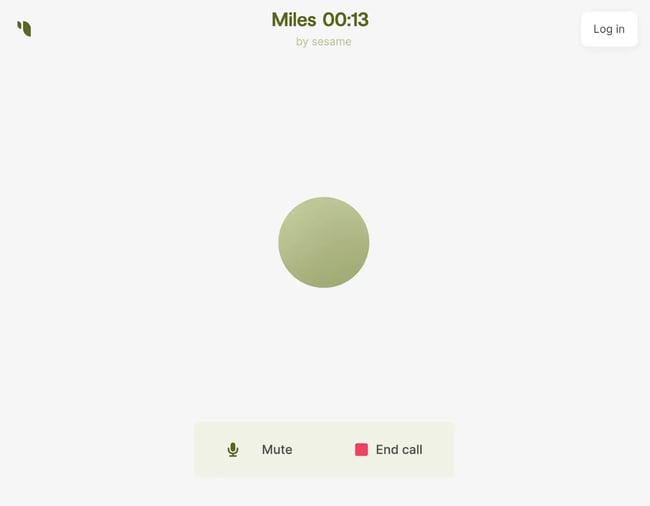
Sesame is a conversational AI voice platform backed by Andreessen Horowitz, Spark Capital, and Matrix Founders. It focuses on emotionally intelligent dialogue, and it’s one of the few tools that actually delivers on that promise.
The default female voice genuinely impressed me with its realism. You can hear her breathe in before responding, natural pauses where she‘s “thinking,” and the emotion in her voice changes based on how you’re responding. It‘s not perfect, but you can tell it’s actively adapting to your conversational style and mood in ways that feel genuinely human.
That level of “emotional intelligence” is remarkable and represents a significant leap forward in conversational AI.
Practical application: Sesame shines in scenarios where emotional nuance matters. Think training simulations, roleplay-based coaching, or user research where tone sensitivity changes the dynamic.
My verdict: This is what I show people when I want to demonstrate where AI voice is actually heading.
2. Grok: The Unhinged Creative Partner

Grok by xAI has a voice mode with multiple personality settings, including an “unhinged” mode that removes most content restrictions. It’s designed to be more conversational and less filtered than traditional AI assistants — and it shows.
For example, I told Grok to pretend to be Andrew Dice Clay (probably a mistake). Within seconds, it was doing horrible jokes in character. Some of the stuff it said, I couldn’t believe was coming from an AI. The tool also adapts to different personalities and sometimes even tries to mimic the actual voice of characters you ask it to roleplay.
It’s not perfect. Sometimes it gets stuck in a character, and you have to reset it. But when it works, it’s genuinely entertaining and feels way more alive than most AI voice tools.
Practical application: Grok is great for creative ideation, especially when you need personality-driven takes, alternate voice styles, or unexpected angles. I’ve used it for rapid content drafting and even tone testing for social posts.
My verdict: This is the most entertaining AI voice available, but you (really) need to be prepared for anything.
3. ElevenLabs: The Voice Cloning Specialist
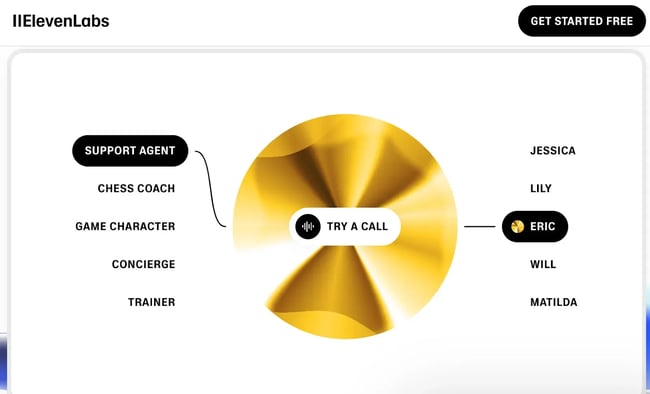
ElevenLabs has established itself as the gold standard for voice cloning technology. I trained it on my own voice and was impressed by how well it captured my cadence and tone. However, I did notice it tends to deliver slightly more monotone results compared to natural speech.
Its biggest strength is consistency. It can maintain the same voice across long-form content and different formats, and the APIs make it easy to integrate into production workflows. The recent addition of sound effects is also a nice touch if you’re building immersive content.
Practical application: ElevenLabs is ideal for scaling your personal or brand voice across lots of content. CEO memos, training videos, online courses—anything where you want to “be present” without recording every line.
My verdict: This is the most practical tool for creators who need to efficiently scale their voice.
4. ChatGPT Voice Mode: The Reliable Assistant
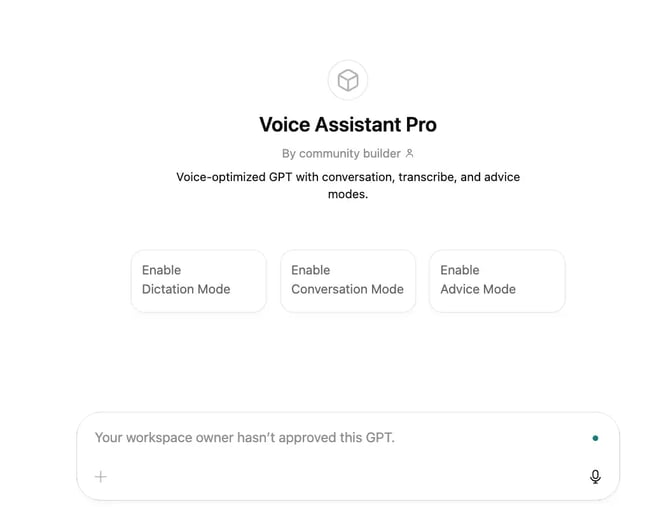
ChatGPT’s Advanced Voice Mode is OpenAI‘s real-time conversational AI that can understand tone and respond naturally in voice conversations. It’s currently available to ChatGPT Plus subscribers and represents OpenAI’s most polished voice offering.
The voice mode is good, but it feels like they deliberately toned down some of the more human-like qualities from their original demo. Probably smart from a “people need to know this is AI” perspective, but it makes the experience feel less natural than Sesame.
That said, it’s reliable and easy to access, which makes it a solid option for day-to-day use, especially in business settings.
Practical application: ChatGPT Voice is ideal for professional communications where consistency matters more than personality. Think executive presentations, training modules, or any content where you need reliable, polished delivery.
My verdict: ChatGPT Voice is a reliable workhorse that gets the job done, but it’s not the most exciting option.
5. Wispr Flow: The Productivity Multiplier
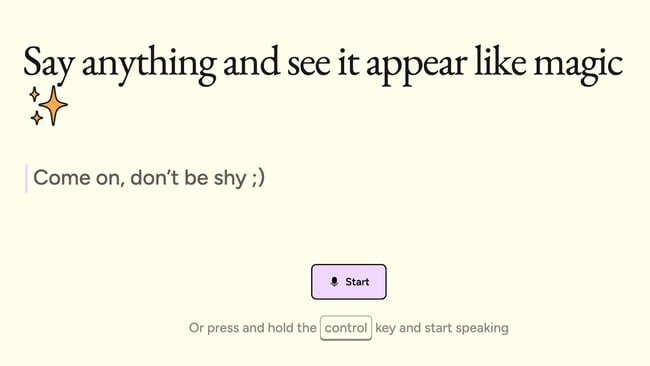
Whispr Flow is a system-wide voice-to-text tool built on OpenAI’s Whispr speech recognition model.
I started using it after injuring my hand (a reminder of spending 80% of my day typing for over 40 years), and it immediately changed how I work. You hit a hotkey, talk, release, and your words appear as text. That’s it.
Even at fast speeds, it’s surprisingly accurate. Occasionally it gets a word wrong, which can lead to some funny misunderstandings with AI assistants, but overall it’s become part of my daily workflow.
This is definitely what people mean when they talk about “vibe coding,” just talking, and having your ideas turn directly into content or code.
Practical application: Whispr Flow is perfect for anyone who writes or builds all day. Developers can code by voice, content teams can dictate outlines while walking, and it’s a huge unlock for accessibility and fatigue management.
My verdict: Whispr Flow is a genuine productivity game-changer that I can’t imagine working without now.
6. Octave (by Hume AI): The Emotionally Convincing Friend
Hume AI has been working on emotion detection in voices for a while, and Octave is their text-to-speech flip side. You describe the voice tone you want, like “chillingly intense like a horror voice actor” or “angry but professional.” From there, it generates speech to match.
It’s an ambitious idea, and when it works, it really works. But it’s also a little fragile, especially if the emotional prompt doesn’t match the script content. For example, if you ask it to sound terrified while reading a grocery list, it gets confused, and the results feel mismatched or flat. But when the emotion aligns with the script, it delivers a surprisingly convincing voice performance.
Practical application: Octave is best for emotion-driven creative work. Think brand ads, video narration, podcast intros, or any project where tone matters just as much as the words themselves.
My verdict: This is fascinating technology and good to experiment with, but it still feels early-stage.
Start Exploring AI Voice Tools
AI voice tools are already changing how we create, deliver, and scale content. The best ones don’t just sound human — they help you move faster, stay consistent, and open up new creative possibilities.
If clarity, access, or experience design matter to your brand, this is worth paying attention to. The real question isn’t whether the tech is ready. It’s whether you are.
And if you’re looking to stay on-top of the AI space, check out Lore — a weekly newsletter that helps 40,000+ operators from OpenAI, NVIDIA, and Amazon master AI in five minutes or less.”
To learn more about the AI voice tools I tested, check out the full episode of The Next Wave below:
![]()
From third-party cookies to zero-party data: The new rules of email engagement
A few days ago, Jane was browsing for new sunglasses. Before she knew it, every site she visited was showing her relevant ads. It wasn’t magic. Just algorithms working with behavioral data. But data collection is no longer something we can do in the background. […]
MarketingA few days ago, Jane was browsing for new sunglasses. Before she knew it, every site she visited was showing her relevant ads.
It wasn’t magic. Just algorithms working with behavioral data.
But data collection is no longer something we can do in the background. With rising privacy concerns, businesses must now lean on zero-party data.
And what better channel to invest in privacy-first communication than email? A channel where users opt in to get personalized customer experiences.
I’ll walk you through the new rules of data collection, how well-established brands are adapting, and what you can do to stay ahead.
Table of Contents
- Why Marketers Are Prioritizing Zero-Party Data
- How to Collect Zero-Party Data
- Things to Consider During Zero-Party Data Collection
Why Marketers Are Prioritizing Zero-Party Data
Apple‘s Mail Privacy Protection and GDPR have accelerated the shift to zero-party data. The same goes for Google’s update, although it’s been postponed.
Privacy laws aside, there are more reasons why you should turn to zero-party data.
Accessing High-quality Data
Research shows that 25% of marketers mention poor-quality data as a main reason why they fall short of customer expectations. But your audience chooses to share zero-party data. This means you get more reliable insights than any data collected passively.
Building Trust
With phishing attempts on the rise, users worry about where their sensitive information ends up. As a result, business executives find it challenging to establish trust:
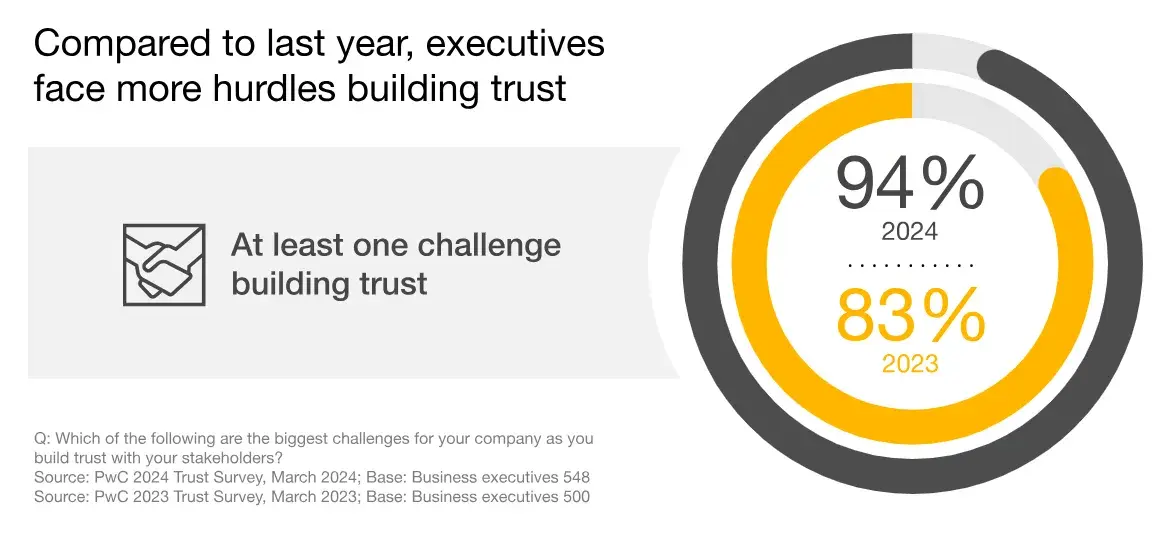
With zero-party data, customers know exactly what they’re sharing. And according to Salesforce, 71% of them are more likely to do so if a brand clearly explains how they’ll use the information.
Creating More Personalized (Cross-channel) Experiences
Accurate data means you can deliver meaningful experiences on every channel. For example, a user takes a quiz on a cosmetics site to find their perfect lipstick. At the end, they opt in to receive email and SMS updates. Now the brand can personalize every touchpoint, from emails with blush recommendations to texts with discounts on lip liners.
Boosting Email Deliverability and Interactions
If your emails live up to subscribers’ expectations, they’re more likely to interact and less likely to unsubscribe or mark emails as spam. And this is how you keep email deliverability and sender reputation intact.
How to Collect Zero-Party Data
Below are the most effective ways to gather zero-party data from your audience, along with successful use cases for each.
1. Signup Forms
Tailor your signup form to collect more than a name and email address.
For example, Sephora uses back-in-stock alerts to learn about customers’ preferred communication channels:
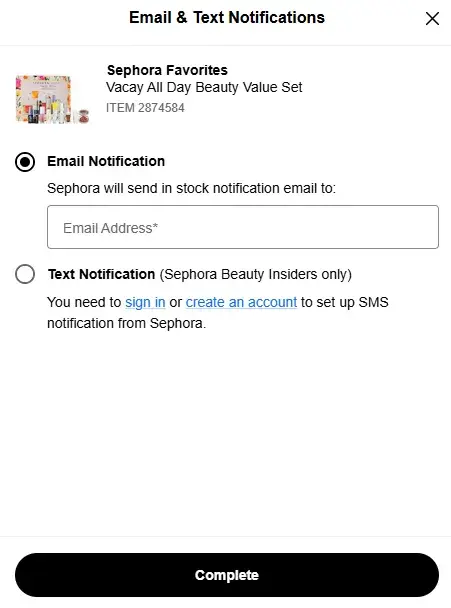
Another approach is to include an email preference field and ask users:
- How often they’d like to receive emails
- What kind of content they prefer
- What products/services they’re interested in
With this tweak, you transform a simple signup form into a lightweight email preference center.
Let’s say you want to give your audience the option to choose how often they’ll hear from you — monthly, bi-weekly, or weekly.
With an email tool like Moosend, you can create a preference center so subscribers set their own frequency. What you get is three segments (that update automatically as users change their preferences):
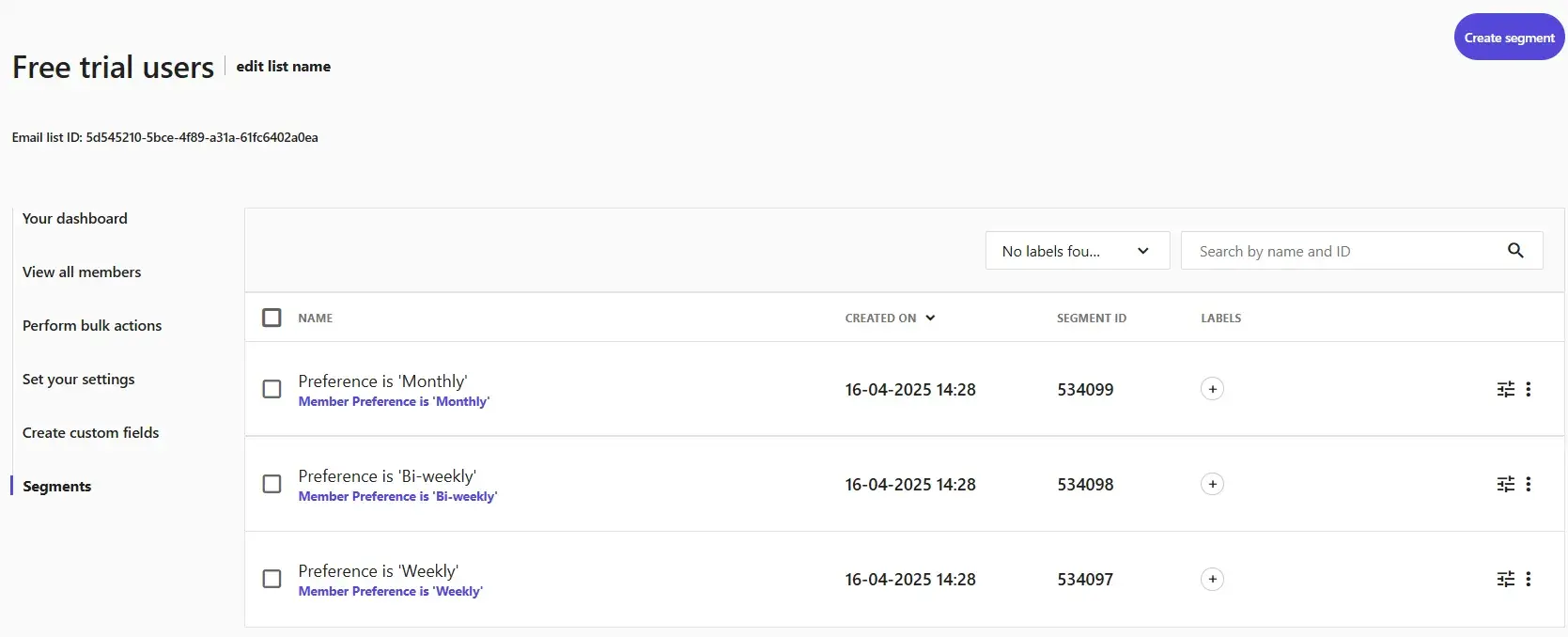
Next time you send an email, you’ll select the relevant group and the campaign will reach the right inboxes.
The more you understand people’s preferences, the more personalized their experience feels. As Georgia Riga, Moosend’s Customer Success Manager, puts it:
“Collecting zero-party data through an email preference center is just the start. The real impact comes from respecting customer preferences in future communications and delivering with consistency.”
2. Account Creation
It’s common to ask new users for information such as their job title, company name, and pain points.
However, asking too much upfront could overwhelm them. A better approach? Break the process into a multi-step onboarding to keep users engaged without causing friction.
Start with the essentials and then, depending on your industry, ask a few additional questions. For example, an eCommerce business could ask for the user’s birthday to send timely discounts.
Make sure to tie every question to a clear benefit. Canva does an excellent job at this by clarifying how they’ll use the info required:
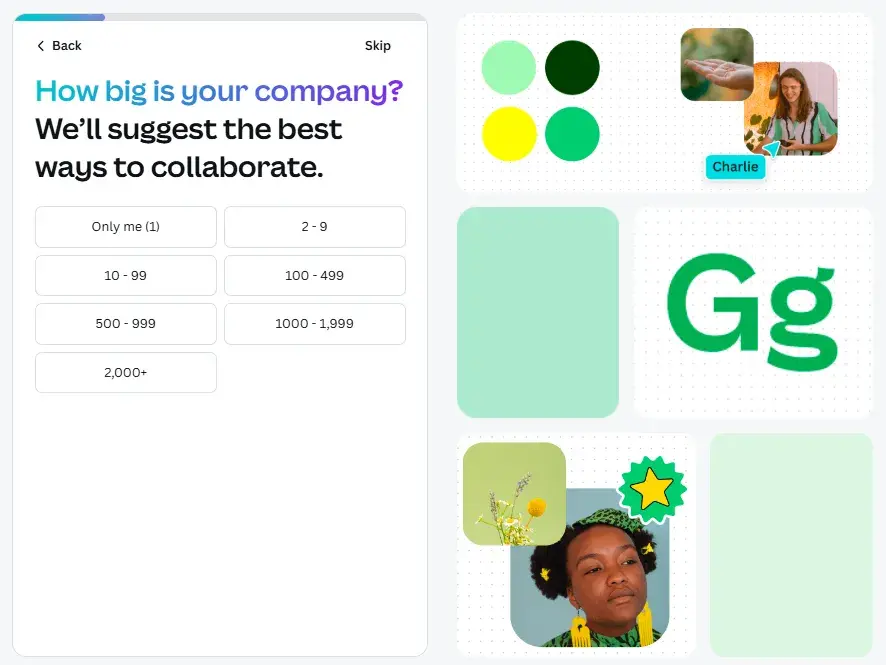
3. Interactive Tools
People love polls and quizzes because they discover new things while having fun.
Think of a quiz that users take and then fill in their email to get personalized results.
There you have it: real-time zero-party data collection, plus a new subscriber (who didn’t feel forced).
Fun aside, the average user won’t appreciate going through a tiring process just to get a personalized recommendation.
Stick to 3-5 questions and avoid dropdown menus or open-ended questions. Some brands even let users skip a question or two and still get the results.
Frank Body embeds a skin quiz on its website as part of the signup process and offers an extra incentive.

After clicking the CTA, visitors answer a few quick questions, such as:

4. Reviews, Ratings, and Testimonials
Customer reviews are not just good social proof for potential customers — they also give you insights about your current customers.
Time matters when asking for feedback, though. You want to reach out while their experience is still fresh — ideally, within 1-3 days. That’s when customers are more likely to provide honest, accurate input.
Here’s how and where you can make the request:
- Build an automated post-purchase email that leads users to your website or a review platform.
- Use customer support chatbots that trigger a review request after an issue is resolved.
- Send a short SMS message using a branded link. Text messages work particularly well for mobile apps.
- Reach out to people who mention or tag your brand on social media to see if they’re open to sharing their experience.
Consider offering a small incentive, such as a freebie, downloadable resource, or a discount. Also, keep the process short and, if possible, mention how long it will take to complete.
In this email, Virgin Atlantic starts with a heartwarming thank-you note. Moving on, they explain why they need this Net Promoter Score (NPS) survey and the time it takes.
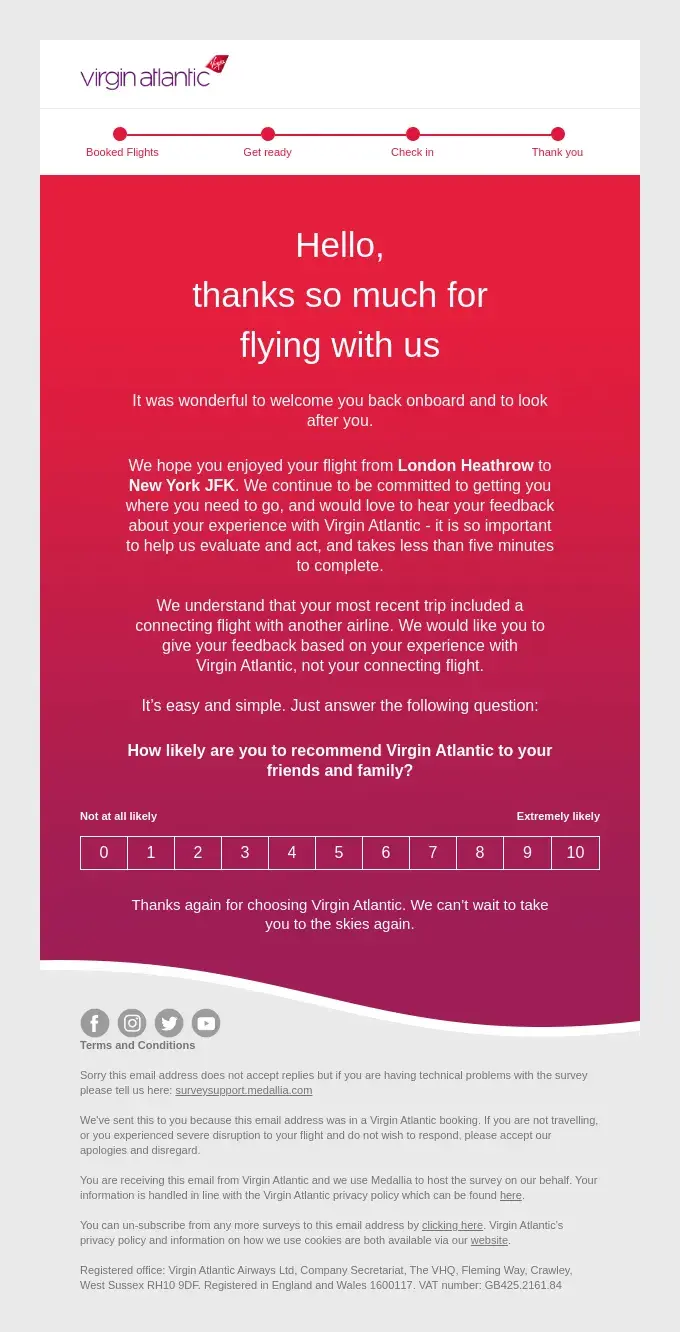
5. Webinar Registrations
Besides being an excellent lead generation tool, webinar registrations help you learn more about your audience, especially in the B2B industry.
What kind of audience insights should you ask for? Try these:
- Name and email address
- Company name, industry, job title
- Custom questions based on the webinar topic
Custom questions may include specific interests and levels of expertise. Want to dig deeper into attendees’ goals? Add an open-ended question to understand why they decided to register.
To remove barriers, make some fields optional. Alternatively, collect more information in a follow-up email after registration.
You can even continue the conversation once the webinar wraps up. Send an email to attendees to collect feedback and find out what else they’d like to learn.
Digital Marketing Institute uses this simple form for lead generation, only asking for basic information to build a professional attendee profile.
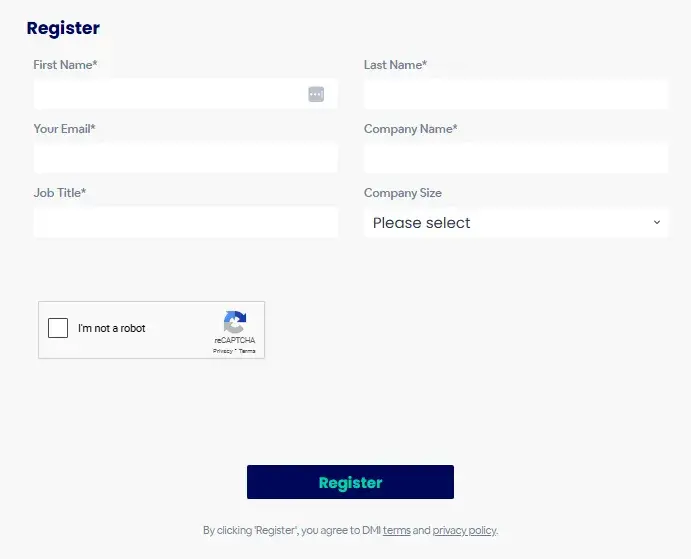
6. Customer Support and Chatbots
When it comes to customer service, chatbots are the first choice both for brands and consumers, according to HubSpot’s State of Service Trends Report:
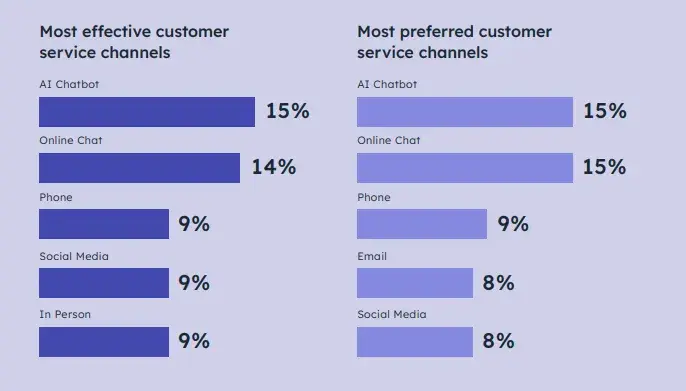
Whether it’s on your website, app, or social media channels, chatbots analyze data throughout the conversation to deliver tailored support. To make sure this data is useful, consider these factors:
- Build chatbot conversations with short and simple questions to identify the user’s intent.
- Use clickable buttons for replies instead of asking users to type the entire answer.
- Avoid asking for sensitive information upfront. Instead, wait until the user is engaged or once the problem is resolved.
- Follow up with optional feedback requests, like: “Was the issue resolved as expected? If yes, would you care to leave a quick review?”
Attentive keeps things simple by offering links to valuable resources. For specific actions like getting a demo, the visitor has to fill in their email address.
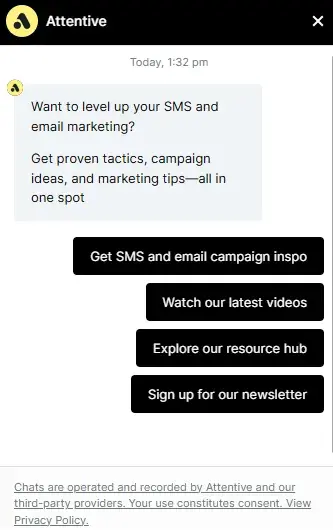
Things to Consider During Zero-Party Data Collection
Users might trust you with their data. But this trust is fragile — send a generic message, and it disappears. To build on that trust, here’s what you must keep in mind.
Remember the cause-and-effect pattern.
Subscribers don’t passively consume content. They ask questions: “If I tell you X, will you give me Y?” So, when gathering zero-party data, make sure the outcome justifies the sacrifice.
Take this example: A user signs up for an employee management platform. They fill in “HR manager” as their job title and flag employee retention as a challenge. A few hours later, they receive an email series offering actionable employee retention strategies.
When the cause-and-effect relationship feels consistent, subscribers see the relationship as mutual.
Prioritize the data you need.
Zero-party data isn’t about bombarding your audience with random questions.
Ask too much — or the wrong things — and you risk raising red flags.
Identify the exact information you need to create tailored emails. Then, separate the must-haves from the nice-to-haves based on your industry and goals.
For example:
- A SaaS company might ask for the user’s job role to provide personalized onboarding.
- For a travel agency, it’d be more helpful to know subscribers’ dream destinations.
- A retailer, on the other hand, could ask for customers’ birthdays to send timely offers.
Consider your audience’s level of engagement.
When you adjust your approach based on the customer journey, data collection feels natural.
Let’s say you run a fitness app.
Instead of sending new subscribers a lengthy survey, include a short in-app form to learn more about what content they’re interested in and how often they want to hear from you.
When a user reaches a milestone, trigger a push notification that leads to a short survey. Ask about their workout habits to further tailor their fitness plan.
What about members of your loyalty program? This is where you can take zero-party data collection further. These are the people who see the value of your products, so they’re more likely to respond.
Collect new data regularly.
When asking for zero-party data, there are types that you‘ll only ask for once (e.g., your subscriber’s birthday).
Almost any other data, like their family status, could become outdated. User preferences are also subject to change.
That’s why zero-party data collection is not a one-off request, according to Natalia Georgiadou, Moosend’s Product Owner:
“You should treat the preference center as a conversation starter instead of a settings page. Build your email preference center with the goal of encouraging that dialogue. And unlock zero-party data that drives real personalization across the entire customer journey.”
So, how can you keep the lines of communication open?
- Set up regular check-ins. Once or twice a year, ask users to update their preferences.
- Build customer profiles gradually. Start with the basics with tools like HubSpot’s progressive profiling. Then, collect more specific insights over time.
Making the Shift to Zero-Party Data
Zero-party data goes hand in hand with trust, transparency, and privacy-first marketing. When consumers voluntarily share insights, they’re giving you permission to connect on their terms.
But you’re not just sending emails. You’re engaging in meaningful conversations. Ones that feel like messages from a thoughtful friend who remembers what you love and shows up with the right thing — at the perfect time.
![]()
How I localized AI-generated emails for international markets without losing the human touch
Earlier this year, I was handed an AI-generated content project with a deceptively simple goal: adapt email messages for international audiences. This wasn’t my first time navigating global nuance. With an MBA in International Business and experience working on a global consulting project in Portugal, […]
MarketingEarlier this year, I was handed an AI-generated content project with a deceptively simple goal: adapt email messages for international audiences.
This wasn’t my first time navigating global nuance. With an MBA in International Business and experience working on a global consulting project in Portugal, I’d already seen how messages land differently depending on culture, tone, and language. But this was my first time applying that lens to AI content generation in my MarTech AI role at HubSpot — and it was more complex than expected.
We already had an AI-generated email prompt that worked well in English—conversational, friendly, and context-aware. The challenge? Making it work in Spanish and French without sounding robotic, clumsy, or culturally off-base.
Sounds easy. It wasn’t.
The Hidden Complexity of “Just Localizing”
What we were really doing was asking an AI model — trained predominantly in English — to speak other languages as naturally as a native marketer would.
Our first attempts fell flat.
Example (original AI output in Spanish):
Here’s what we aimed for in English:
“I saw you were scoping around the platform and that you were interested in speaking with us. Would you like to meet on one of the following days?”
This is the original output in Spanish:
“Estuve revisando tus interacciones en nuestra plataforma y quería ofrecerme como tu punto de contacto.”
In English, it translates to:
“I reviewed your activity and wanted to become your point of contact.”
While grammatically correct, this sounded invasive in Spanish — like we were watching the user too closely. It didn’t feel natural. One reviewer called it “creepy.”
Here’s another example:
- Original English intent: “I noticed you’ve been exploring our platform and expressed interest in connecting with us.”
- Original Spanish output: “Me pareció interesante tu interés en nuestros servicios.”
- Translation in English: “I found your interest in our services interesting.”
Again, it’s technically accurate, but it’s redundant and robotic. It’s the kind of phrasing that makes a reader stop and go, “Did a bot write this?”
The takeaway: Even when the translation is accurate, the tone can be off. And tone is everything in marketing.
The Shift from Translation to Language-aware Prompt Design
At this point, I realized we needed more than AI outputs — we needed a system for guiding the AI to think like a multilingual marketer.
I built a language-portable prompt framework — a structured prompt that could adapt across languages while respecting each one’s unique grammar, tone, and cultural context.
Here’s What Changed
Instead of one static prompt, I broke the logic into variables:
- : Target language (e.g., Spanish, French, German)
- : Pronoun and tone level (“tu” vs. “usted”, “vous” vs. “tu”)
- : Inbox-friendly, conversational, professional
- : Direct vs. suggestive phrasing
- : Enforced where grammar allowed
We also added clear, language-specific rules.
Example (Spanish):
- Use tú consistently, never usted (too formal for our brand)
- Avoid gendered adjectives like interesado/interesada when possible
✅ “Mostraste interés en … ”
❌ “Estuviste interesado en … ”
Example (French):
- Always use vous, not tu, in B2B messages
- Avoid ambiguous endings like intéressé(e)
✅ “Vous avez montré de l’intérêt … ”
❌ “Tu t’étais intéressé(e) … ”
Why This Shift Mattered
In English, a friendly CTA might look like:
“Would you be available for a brief conversation on one of the following days?”
We tried directly translating it into Spanish:
“¿Quieres agendar 15 minutos para hablar sobre lo que estás buscando?”
It was grammatically correct, but it sounded too casual and unprofessional in a B2B context. Not pushy, just slightly off-tone.
So, we reworded it to be friendly but formal:
“Si te parece bien, podemos agendar una conversación breve esta semana.”
This translates to:
“If it works for you, we can schedule a short chat this week.”
Here’s another example in French:
- Original output: “Souhaitez-vous prendre rendez-vous pour en discuter ?”
(“Would you like to schedule a meeting to discuss this?”) - New version: “Auriez-vous 20 minutes pour voir comment HubSpot pourrait concrètement vous aider?” (“Would you have 20 minutes to see how HubSpot could practically support you?”)
The second version adds value to the CTA. Not just time — but purpose.
Backing It Up With a Stakeholder Questionnaire
Localization isn’t just a linguistic issue — it’s a business alignment issue.
To get it right, I created a simple stakeholder intake doc and shared it with marketing ops, regional marketers, and content leads. The goal was to align early on tone, content boundaries, and regional sensitivities.
These are some of the questions I asked:
- What level of formality is appropriate in your market?
- Should we avoid gendered terms?
- Can we reference the user’s company or product usage?
- How direct should we be in asking for action?
- Are there idioms, cultural references, or phrasings we should avoid?
We got some pretty interesting insights.
For example, in some regions, stakeholders preferred not to reference the recipient’s company type in the copy, even though that was common in English (e.g., “I saw that you help startups with HR”).
The localized alternative became more general:
“Entiendo que están buscando formas de mejorar sus procesos internos.” (“I understand you’re looking to improve internal processes.”)
The results of this survey helped create clarity between content, ops, and regional marketing teams — and dramatically reduced our revision cycles.
The Final Product: Human-sounding Emails at Scale
With the updated prompt and intake framework, the new outputs were instantly better.
Before:
- Original output: “Hola [FirstName], soy María de HubSpot. He visto que has navegado nuestra plataforma y parece que te interesa nuestro producto.”
- English translation: “Hi [FirstName], I’m María from HubSpot. I saw you’ve browsed our platform and it seems you’re interested in our product.”
After:
- Original output: “Soy María de HubSpot. Vi que estuviste explorando la plataforma y que querías saber más sobre cómo podemos apoyar tu negocio.”
- English translation: “I’m María from HubSpot. I saw you were exploring the platform and wanted to learn more about how we can support your business.”
And stakeholders responded positively:
- “This finally sounds like someone from our team wrote it.”
- “Perfect tone — natural and local.”
- “No gender errors or weird formalities. We can actually use this.”
Even better, we didn’t need to write separate prompts for every campaign. The same core framework now powers AI-generated messages in multiple languages — with consistent quality.
Takeaways for Marketers
Whether you’re working on AI copy, global ads, or multilingual content, here’s what I learned:
1. Don’t just translate — localize for intent.
Literal translations will get you “technically correct” content. But only localization will make it land.
2. Use prompts like creative briefs.
Include tone, formality, CTA style, gender neutrality, and other language rules as variables. Don’t leave nuance to chance.
3. Build language-aware templates.
Languages behave differently. Plan for things like verb conjugations, pluralization, and sentence rhythm upfront.
4. Get feedback early.
Use a stakeholder intake doc before generation, not after. You’ll avoid rework and misalignment later on.
5. Aim for a real, human tone.
If your AI output doesn’t feel like something you would write to a customer, it won’t convert. Read it aloud. Would you hit send?
AI localization is a marketing skill now.
This project taught me something that has stuck with me since: The future of global marketing isn’t just about scaling content — it’s about scaling context.
The companies that succeed with AI won’t be the ones who generate the most content. They’ll be the ones who generate the most resonant content because they know how to prompt for it. And that starts with understanding the languages your customers speak — in more ways than one.
![]()
How to get more followers on Instagram: 17 ways to your first (or next) 1000
With over 2 billion monthly active users and features like shoppable posts, Instagram is a powerful channel for businesses. But here’s what I’ve experienced firsthand: Unless you’re a household name, growing an Instagram following is hard work. Standing out requires more than just posting pictures […]
MarketingWith over 2 billion monthly active users and features like shoppable posts, Instagram is a powerful channel for businesses. But here’s what I’ve experienced firsthand: Unless you’re a household name, growing an Instagram following is hard work.
Standing out requires more than just posting pictures or Reels every now and then. You need to have a deep understanding of your audience and consistently engage with them. Don‘t worry, I’m here to help.
Let’s discuss some proven, actionable strategies to help you get more followers on Instagram, whether they be your first 1000 or next.
Table of Contents
Types of Instagram Followers
Before I get into the nitty-gritty, it’s important to know what the Instagram landscape looks like today. In your growth journey, you’ll likely encounter these three main types of followers:
1. Fake Followers
Fake followers are usually bots or dummy accounts that inflate a follower count.
You can typically spot them by their lack of profile pictures, posts, followers, or spammy alpha-numeric usernames.
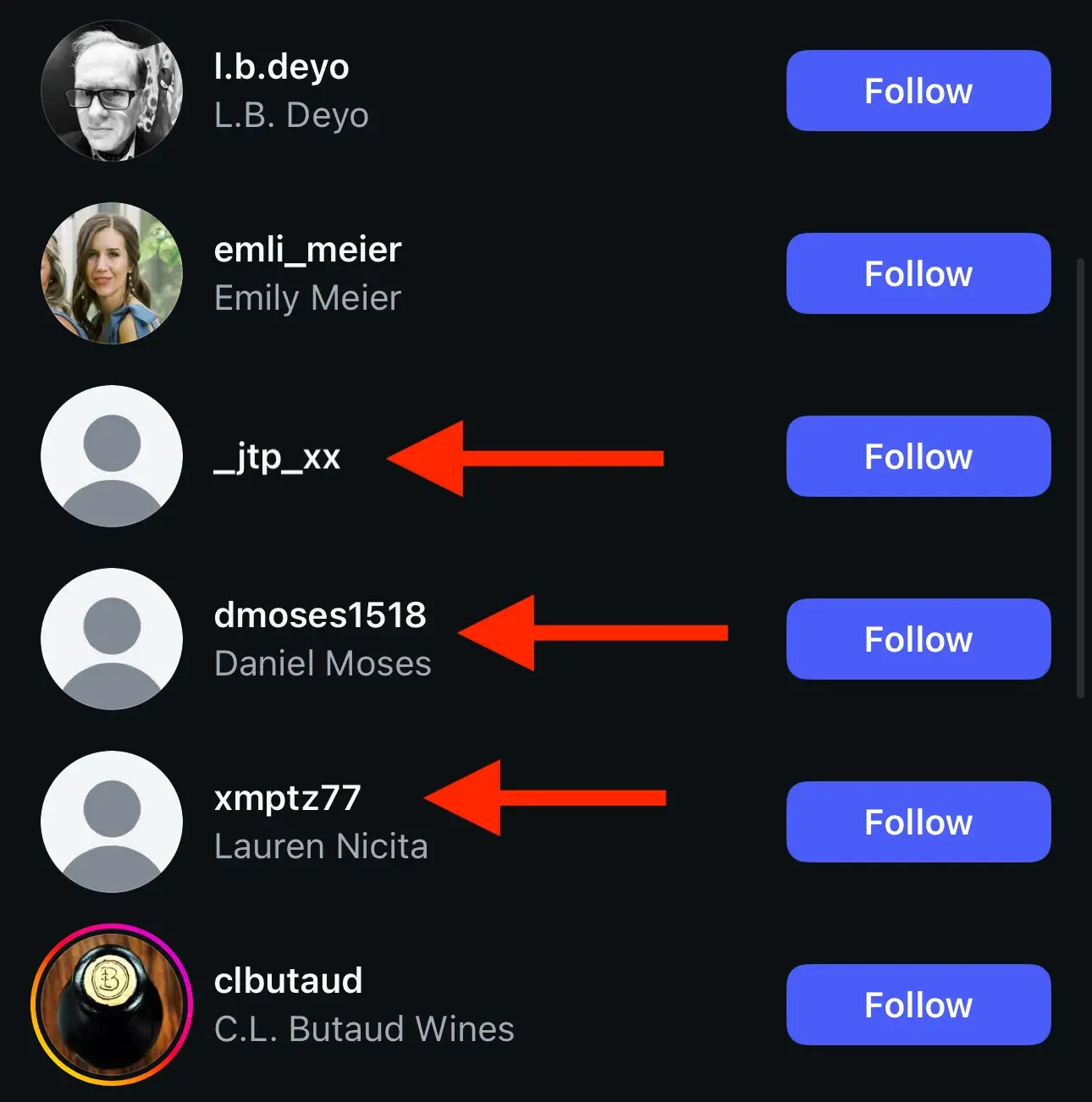
Fake followers may make the follower count on your profile look good, but they don‘t engage. Engagement is a huge factor in Instagram’s algorithm (i.e., getting on the Explore feed and in “suggested posts”) and getting brand collaborations as a creator.
Having a high follower count but low engagement won’t do your account any favors with the algorithm, so it’s better to have real followers who are more likely to engage with your content.
2. Ghost Followers
“Ghost” followers on Instagram are inactive users.
They’re like disengaged contacts on an email list. They‘re real, but again, they don’t interact with your content, so they do little more than skew your metrics.
3. Organic Followers
Lastly, we have organic followers. Organic followers are your real, active audience; those who visit your profile, engage with your content, and are potential customers.
Organic followers can cross many demographics, but pay close attention to the following:
- Customers. These are people who have made a purchase. They already know and like your brand so you want to know when you’re talking to one.
- Competitors. These are followers who are in the same industry or line of business as you. They’re likely following to keep an eye on what you’re doing.
- Influencers. Specifically, look out for micro/nano influencers or creators with 10-75K followers. If relevant, these niche influencers can lead to useful partnerships and increased sales for your business.
Out of these three types of followers, organic followers are really the only ones you want. So, how can you get more of them?
How to Get More Followers on Instagram
In 2022, I did the impossible — I had an Instagram Reel go viral. So far, it’s generated over 5.5 million views, 173K shares, 99.5k likes, and 14.6 bookmarks, but the number of new followers? Minimal.
Though it wasn’t my goal, the experience got me thinking about how to get more followers on Instagram. (I mean, if a meme that got the attention of Instagram exec Adam Mosseri won’t do it, what will?)
Even if you’ve never tried your hand at Instagram marketing or you don’t have a team of content creators, you can grow your Instagram account by focusing on a few key areas:
- Instagram Strategy
- Instagram Content Creation
- Engaging Instagram Followers
- Promoting Your Instagram Account
Let’s get started.
Instagram Strategy Tips for Getting More Followers
1. Have a dedicated content creator/personality.
Yes, people may follow some brands on Instagram, but they are more likely to follow and engage with other people. (Why do you think influencer marketing is so effective?)
While you can certainly collaborate with influencers (more on that later), a smart way to get more followers without the extra cost is to have a dedicated creator or creators in your Instagram content.
Think of these personalities as your spokespeople. Having one or a small handful of spokespeople in your Instagram content gives followers someone human to recognize and connect with rather than simply a cold, faceless brand.
“For brands, putting a face to the business is no longer optional — it’s essential,” says Sarah Schmidt, President of Interdependence, a PR and strategic communications firm that manages Instagram accounts for celebrities, CEOs, and brands.
Schmidt suggests that the face of the brand doesn’t always have to be the company founder. “We’ve had the most success when someone from the team becomes a consistent presence — a personality followers can connect with,” she says. “When that person shows up with opinions, behind-the-scenes context, and a sense of humor, the brand becomes more than a logo, it becomes a point of view.”
Take Auberth and Javi on HubSpot’s Instagram, for example:
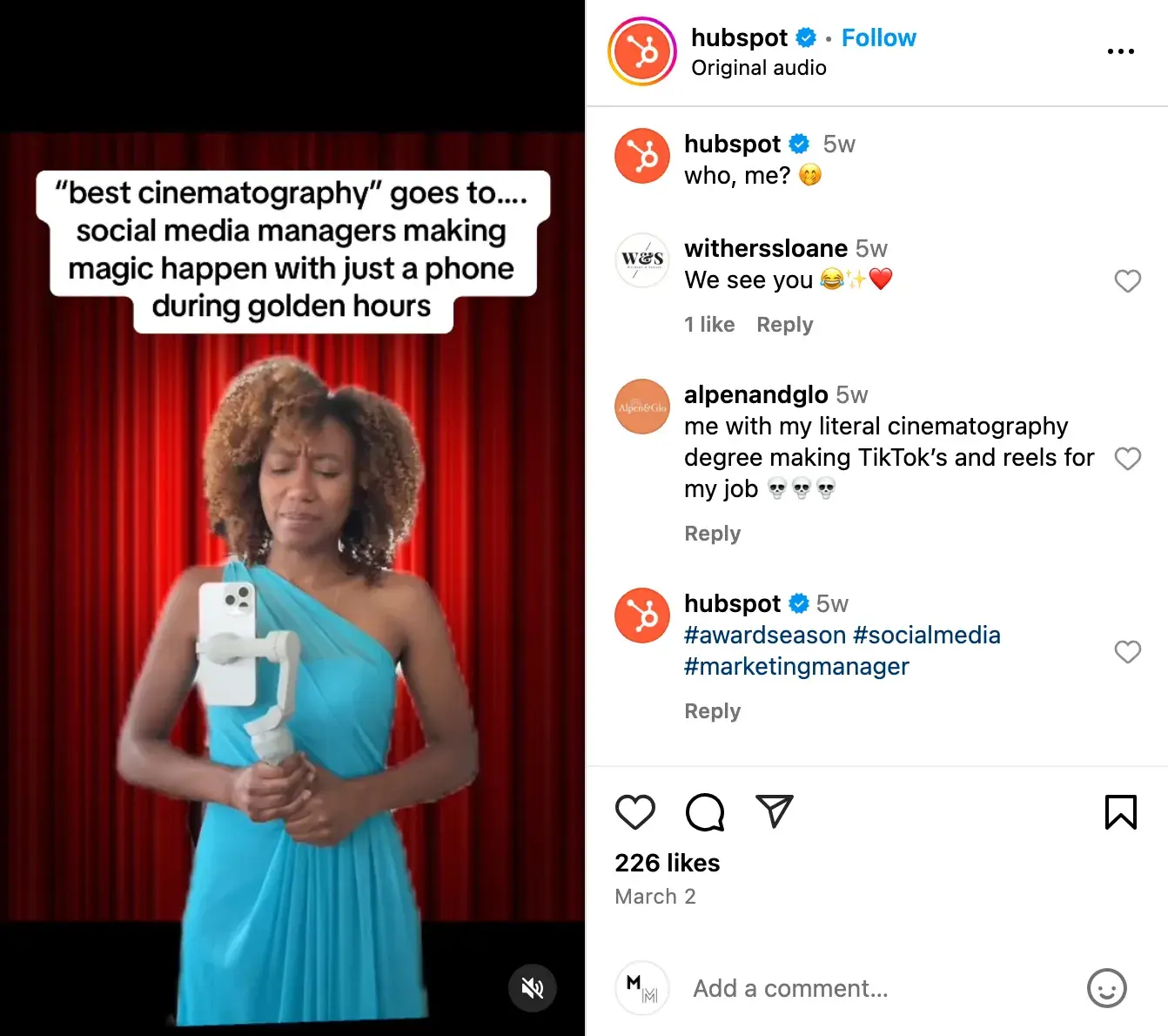
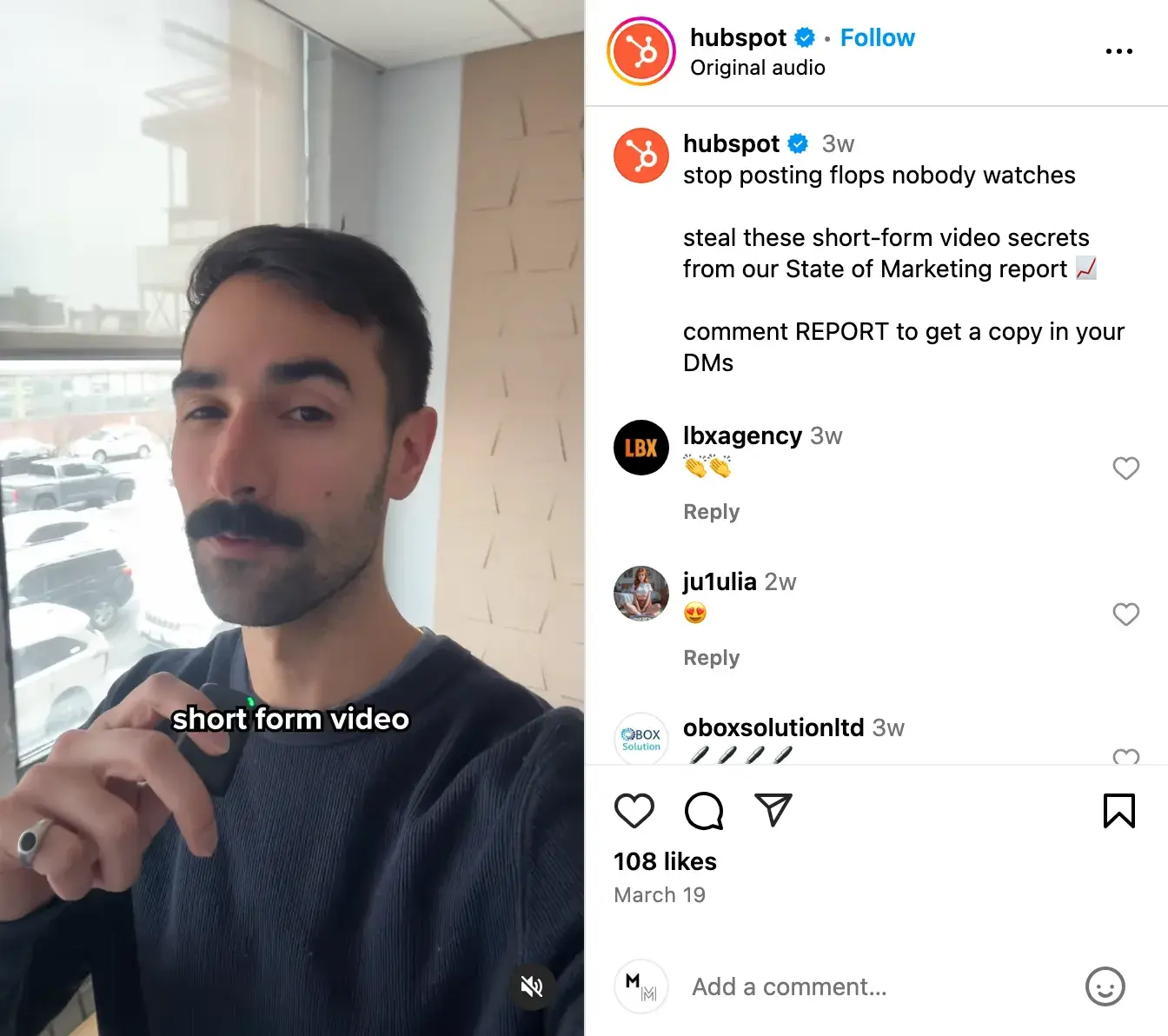
They both regularly appear in HubSpot’s Instagram content, delivering our messages and representing the brand. They also give followers a face to connect with when they see HubSpot in their feeds.
Find someone with experience and passion for Instagram to appear in your content. Someone who understands user behavior and will stay current on trends, new features, and updates to Reels and Instagram Shopping.
Do you have someone inexperienced who’s interested? Have them dip their toes into becoming a digital creator by getting an Instagram Marketing certification and experimenting with content creation templates.
Learn How to Increase Followers with HubSpot’s Free Instagram Marketing Course
Pro tip: Mine your existing team for creators.
No one knows your brand, product, or service better than your team members. If they are willing, ask them to appear in your Instagram content, whether it be in images, videos, or even audio.
Consider creating a system for curating content from your team.
For instance, establish a specific email address for folks to submit photos, short videos, and memes. Alternately, if your team shares a Box or Dropbox account, create a shared folder where people can upload their content.
Think about how your team communicates and make it easy for them to get involved.
2. Share educational content with Instagram carousels.
The best way to get more followers on Instagram is to offer value. In this case, education.
Data from Sprout Social found that Instagram carousel posts were the second most engaging content format after Reels.
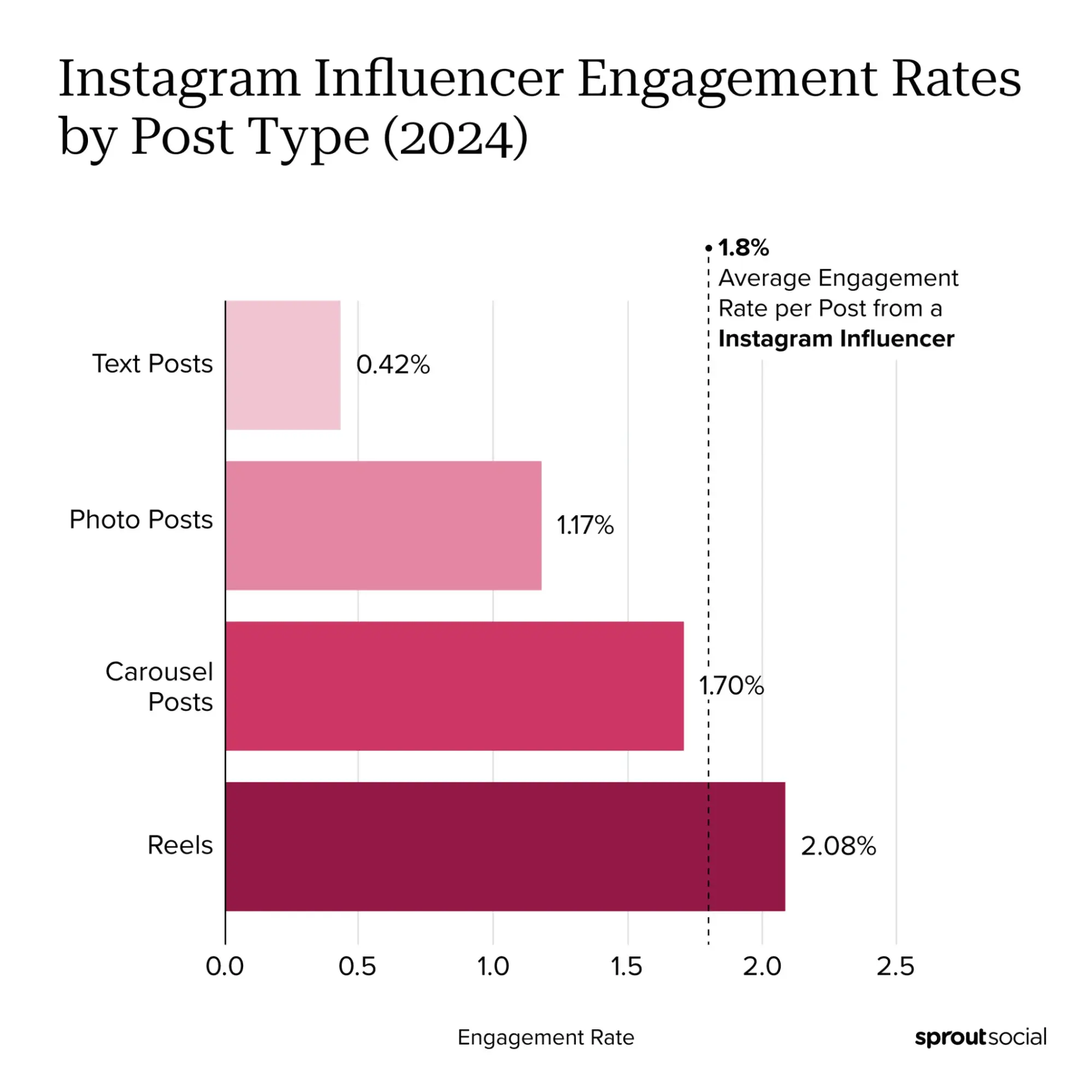
Adam Mosseri, the Head of Instagram, said himself that carousels get more reach than photo posts.
Think about what you can educate your audience on. Then, create a simple Instagram carousel post with an engaging title enticing users to click through to the next slide.
Grammarly does a great job of sharing educational carousels on its Instagram:
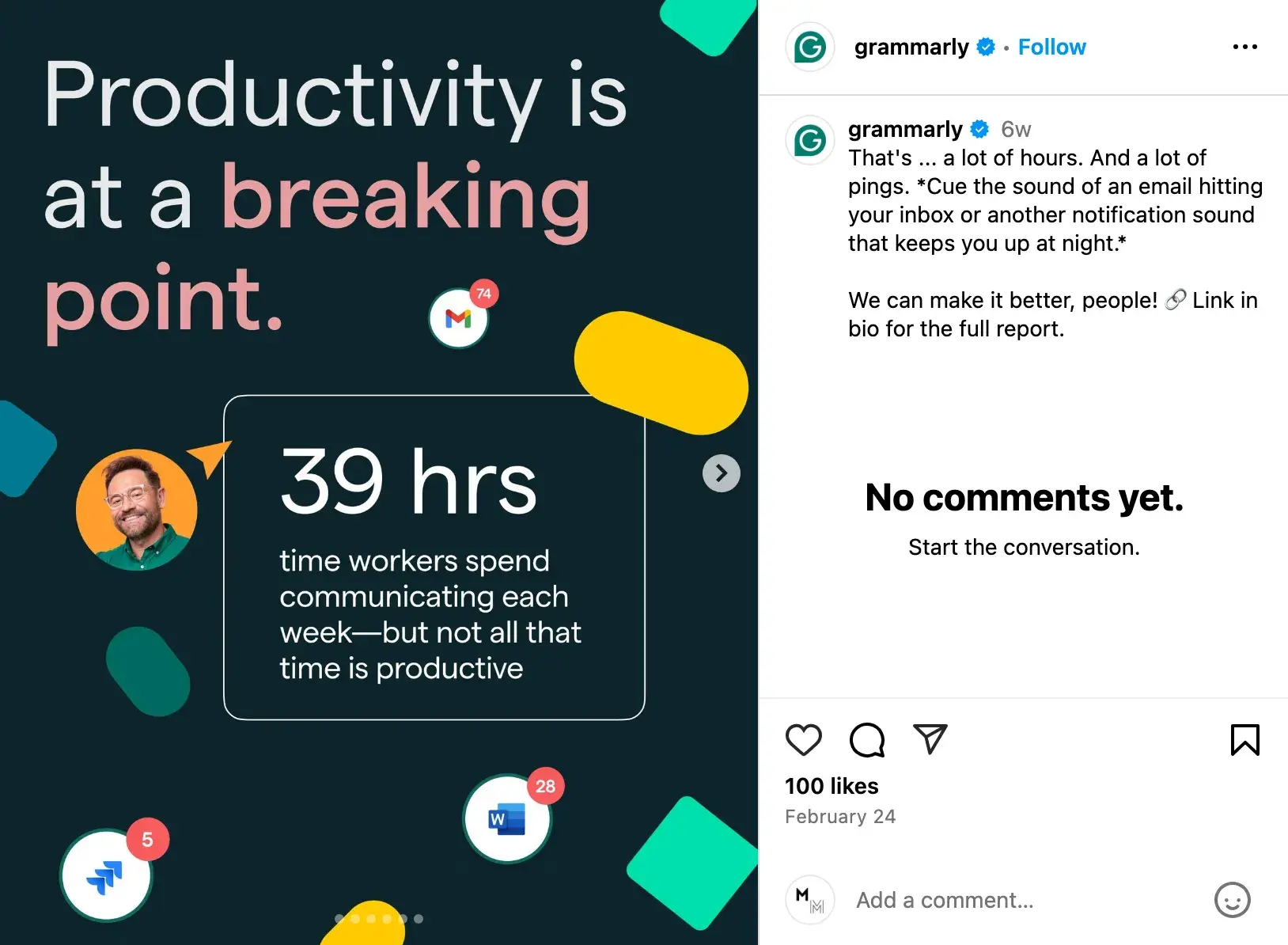
3. Be mindful of diversity and inclusion.
Instagram is a global platform that reaches people from all walks of life.
Thinking about diversity and inclusivity can help reach more of these people by looking past preconceived notions of gender, age, race, income, and sexuality to highlight how your product or service can offer value.
How do you do this? It comes back to focusing on common pain points and experiences, which are often universal regardless of topical traits.
Inclusive marketing challenges rigid ideas of who a brand’s buyers are and how their product is used to cast a wider net — one that may include demographics they may have never considered before.
Recently, I’ve been impressed by Urban Decay Cosmetics’ inclusive content on Instagram. This recent post highlights the brand’s commitment to diversity, equity, and inclusion.
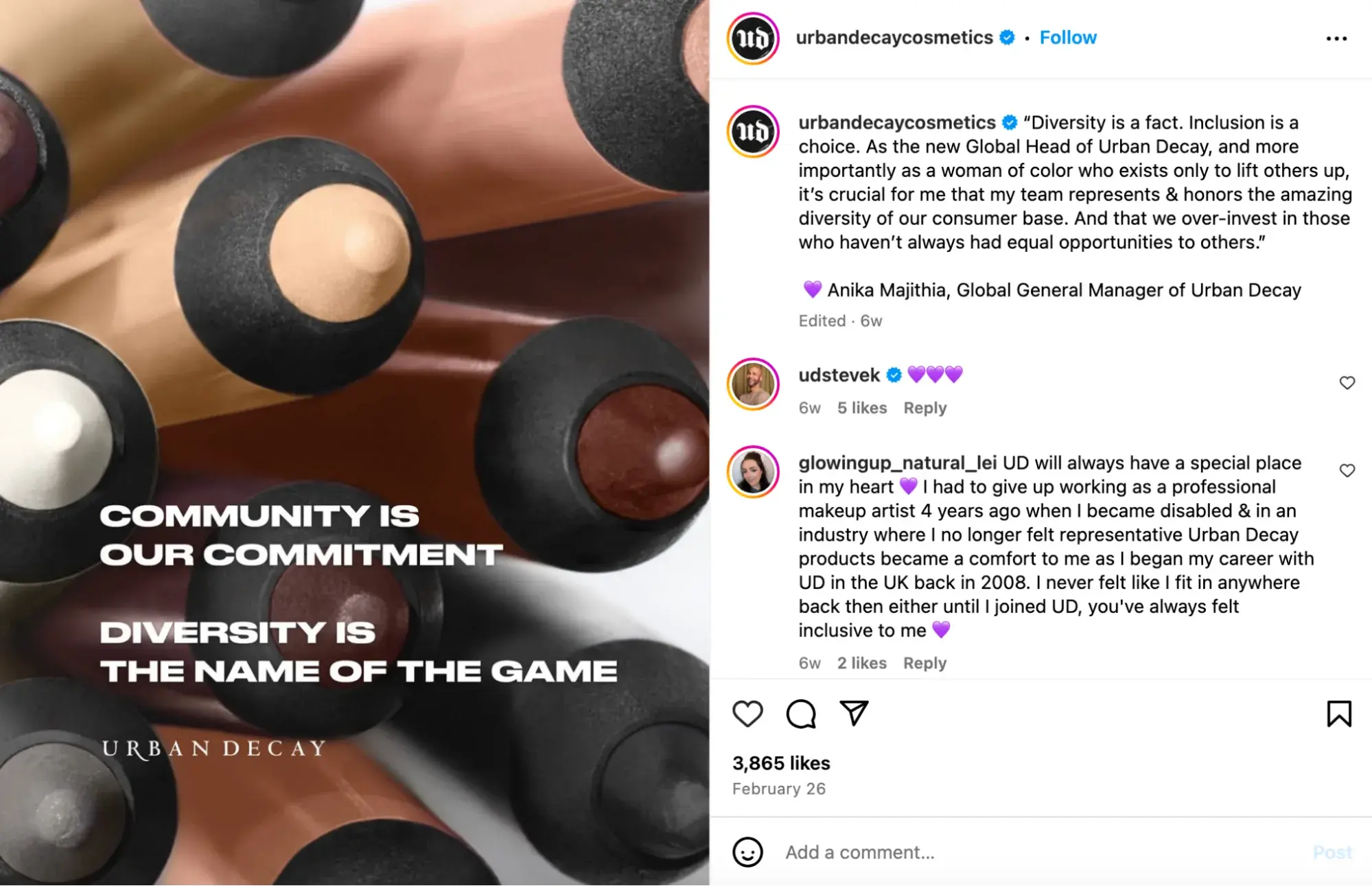
Historically, many makeup brands have primarily targeted women and showcased conventional Western beauty standards, Urban Decay’s content features a wide range of individuals using their products.
This opens them up to many other markets (and followers) that may currently be ignored by their competitors.
4. Post consistently.
If you want people to follow you on Instagram, you have to give them something to follow. This means posting high-quality, relevant content regularly.
Schmidt suggests posting with a purpose if you want to increase your publishing frequency. “The best way to earn followers is through consistency with meaning,” she says. “Don’t just post for the algorithm. Build a storyline that makes people want to stick around. Series-based content, progress updates, thematic arcs all outperform isolated one-offs.”
Another easy way to get into this habit is to commit to a posting schedule.
Having a set time on your calendar to post content on Instagram gives you a deadline to abide by, and it gives your audience a specific time to anticipate hearing from you.
Heck, they may even plan for it like I clear my schedule for new episodes of The White Lotus at 9 PM ET on Sundays.
Ok, maybe your posts won’t ignite this kind of commitment, but having an Instagram schedule does set expectations. And expectations build a sense of reliability, community, and trust with your followers. But what time should you post?
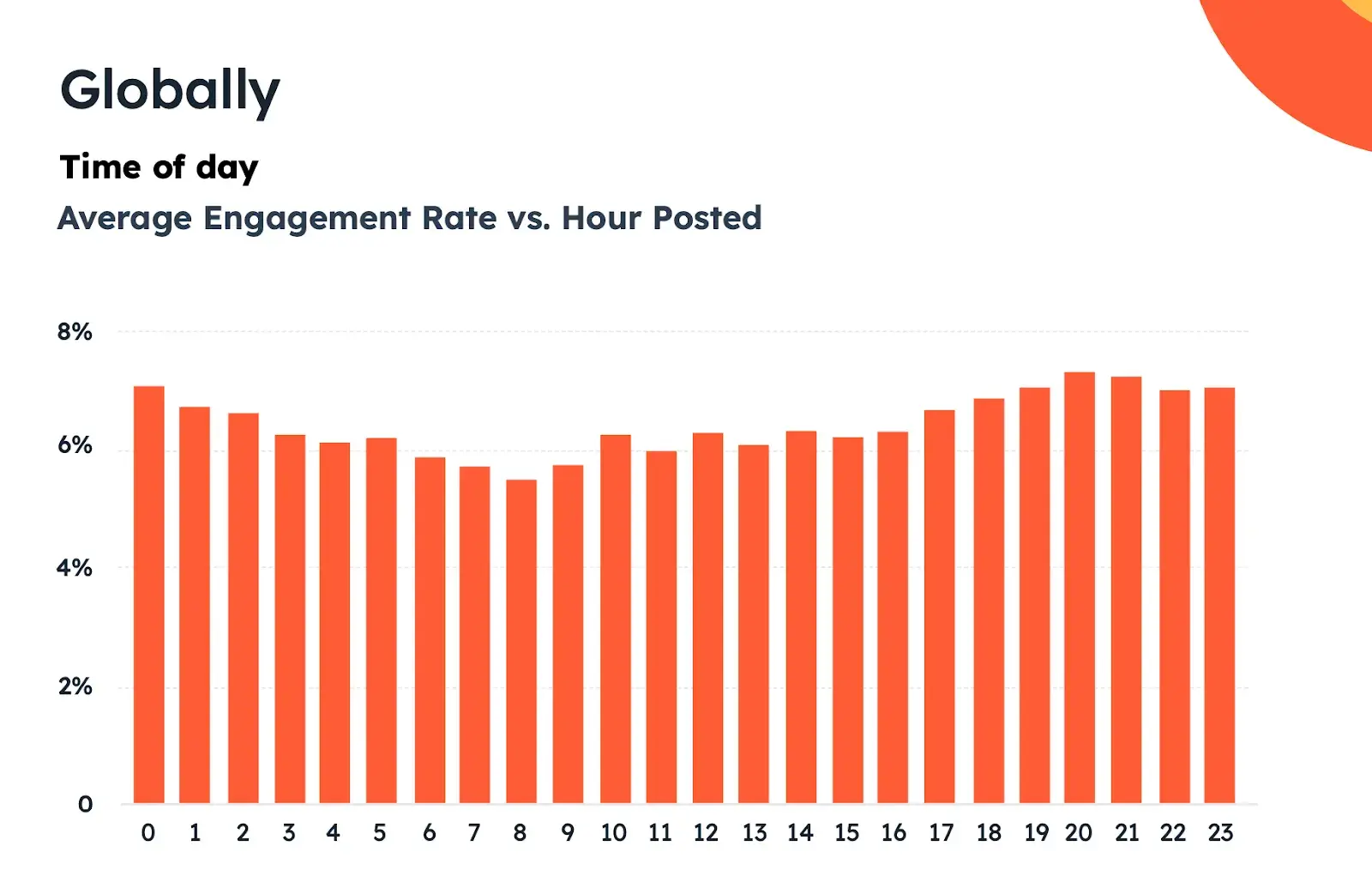
Optimizing your schedule for your specific audience might take time and experimentation, but recent HubSpot research found the best times to post on Instagram to be 12-3 PM or 6-9 PM.
Friday is the best day for engagement, followed closely by Saturday and Sunday. The evening window from 6:00 PM – 8:59 PM usually has high engagement levels.
Experiment with these guidelines to see what works for your audience and persona. Your target persona can drastically impact your posting timing and frequency, especially if they are in a different time zone.
Download this free template for buyer personas if you already have a few.
Pro tip: Use a social media management tool to help maintain consistency.
Get Started with HubSpot’s Social Media Tool
You can always post manually, but scheduling your posts in advance can help plan ahead and save time. Here are more articles to help you choose the right tool and learn how to schedule Instagram posts:
- Best Social Media Management Tools
- Scheduling Instagram Posts: Absolutely Everything You Need to Know
- When Is the Best Time to Post on Instagram?
You can also use a social media content calendar to plan your Instagram posts. Here are some resources you can use to jumpstart your Instagram content creation process:
- What to Post on Instagram: Photo & Video Ideas to Spark Inspiration
- Best Instagram Captions: Good, Cool, Funny, & Cute
- How to Plan Your Instagram Posts [+ Free Instagram Planning Templates]
5. Diversify your content mediums.
Do you typically only post static image content? Or just Instagram Reels?
If you want more Instagram followers, try diversifying the mediums on which you create and share.
Different people enjoy consuming information in different ways, so if you’re only creating one type of content you may be getting ignored by many in your target audience.
Rather than post all-encompassing content that will satisfy all of your followers at once, conduct some research to separate them into smaller groups. Then, plan different posts to appeal to each subset of your audience.
One account I love that uses different content mediums is Airbnb. The page showcases a healthy mix of short-form videos, static photos, carousels to diversify its feed and highlight offers in different ways:
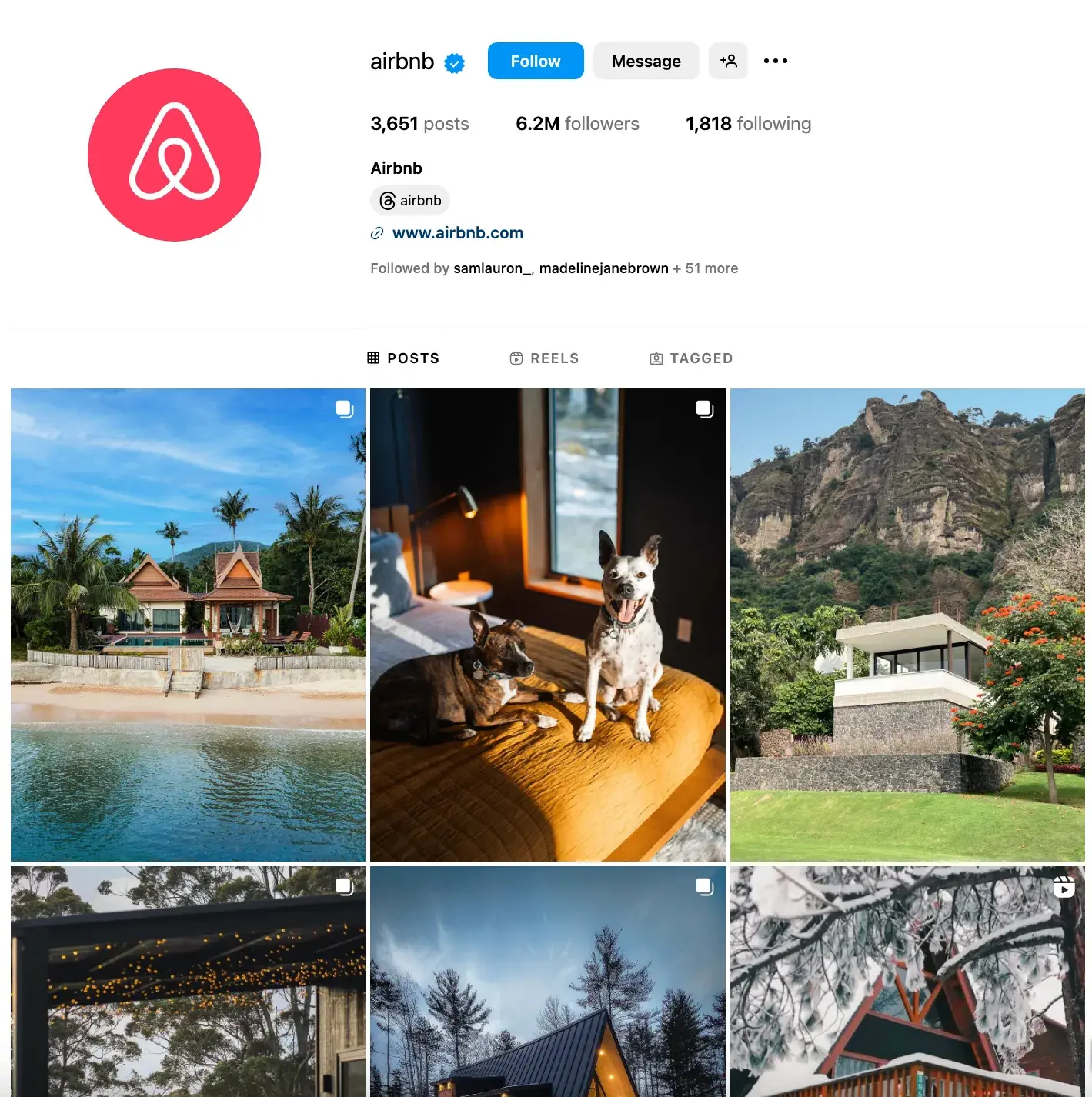
Pro tip: Monitor your brand’s Instagram Insights to identify what’s working.
What type of content is actually getting engagement? With an Instagram business profile, you get access to Instagram Insights, which show you what content is generating the most views, likes, and followers.
Look at these regularly to understand what content you should create to make progress against your follower growth goals.
Instagram Content Creation Tips for Getting More Followers
6. Lean into trends and current events.
Instagram is a trendy place.
Finding relevant ways to incorporate trends, memes, and current events into your content is a great way to stay top of mind and get in front of new followers there.
While Audible typically posts informative content about upcoming book releases or conversations with authors, the brand also mixes in relevant memes to its content strategy. Not only does this help them reach a wider audience, but it’s also a good way to grab the attention of your existing followers.
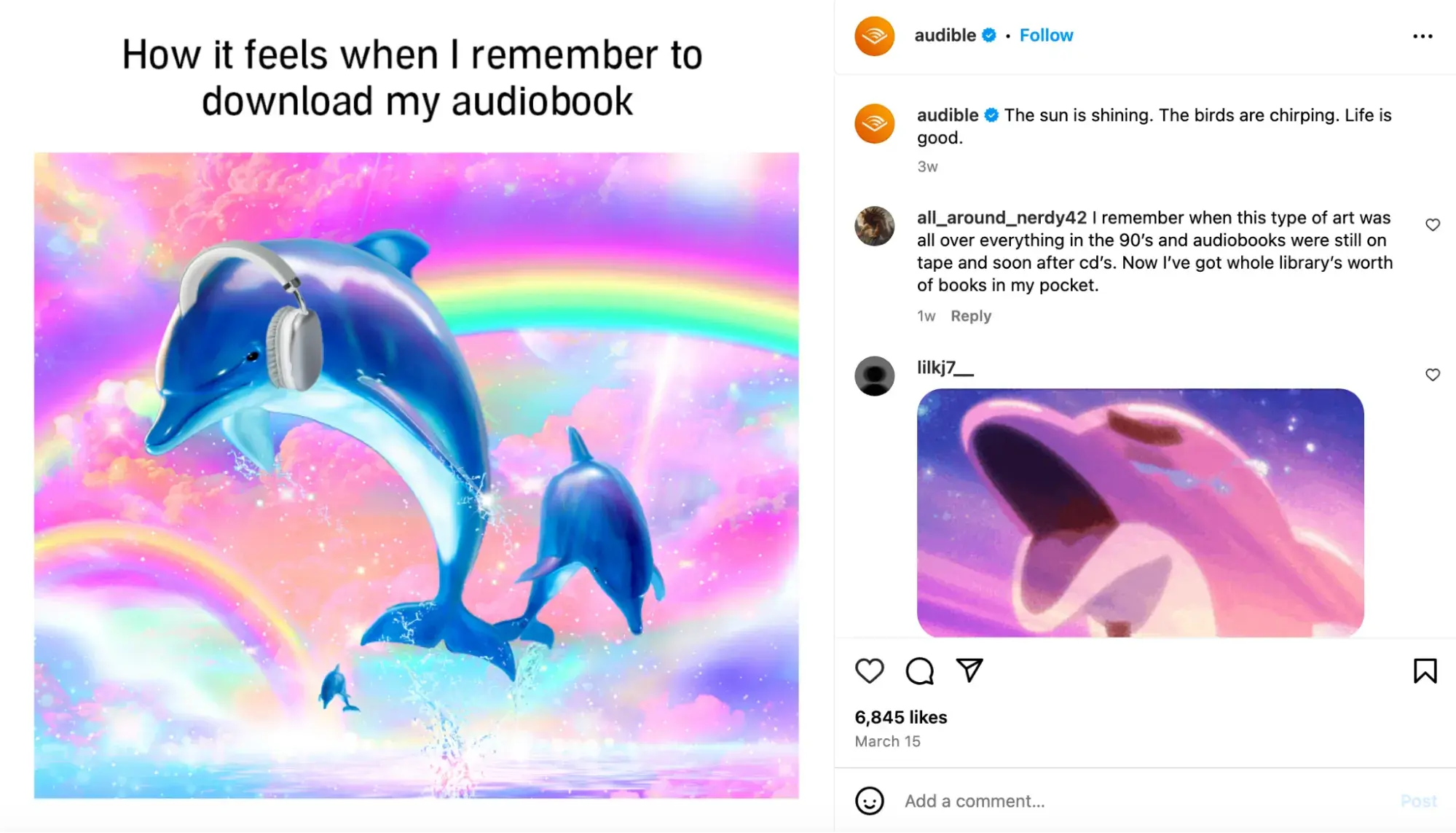
7. Create short-form videos.
In 2025, short-form video is taking over the Instagram feed.
According to HubSpot’s 2025 State of Marketing Report, marketers not only use short-form video the most of all content types, but it’s also the content format with the highest ROI.
The good news: You don’t have to be a video expert to make Reels. Short, simple videos do well when paired with a trending audio and clever caption. When I’m feeling stumped on short-form video ideas, I often turn to accounts like Duolingo. The brand is quick to jump on trends and make simple yet engaging videos like the one below:

Pro tip: If you’re still not confident in your video-taking skills, consider using AI tools. 56% of marketers say they use AI to create short-form videos.
8. Follow photography best practices.
On Instagram, post quality matters. A lot. Your X followers might forgive a few bad tweets, but a bad photo on Instagram is a big no-no.
Fortunately, you don’t have to be a professional to have a great Instagram feed. You simply need to get familiar with basic photography practices and photo editing apps.
Photography Best Practices
If your budget allows, investing in professional photography will elevate your profile. However, as a mobile app, people understand that much of your content may have been created on a mobile device.
In fact, lower production value can make your content look more human and relatable. That said, a smartphone will do, but follow these tips to give your photos a more finished look:
- Follow the rule of thirds.
- When all else fails, center your subject.
- Look for symmetry.
- Capture small details.
- Have light (preferably natural lighting) facing your subject.
Editing Photos Before You Post
Instagram has some basic editing capabilities, but oftentimes, they aren’t adequate at making visuals stand out. Most of your photos should go through at least one or two photo editing apps on your phone before you open them on Instagram. Some options include:
9. Start a conversation with your captions and comments.
Captions are an essential part of your post. They give your content context, can humanize your brand, and offer additional value to your audience that makes them want to read, engage, and follow.
Using your captions to spark conversations can boost engagement, triggering the Instagram algorithm to show your content to more potential followers so give them the time and attention they deserve.
Here are a few things you might see in a winning Instagram caption:
- Personality
- Emojis
- Hashtags
- Questions
Personality
Many successful brands and influencers show personality or humor to connect with their audiences and attract followers.
Kelly Hendrickson, a Director of Social Media at G-P/Globalization Partners and HubSpot’s former Head of Brand Social, loves Netflix’s account for this.

“They have such a clear brand voice, and you laugh along with them. They’re in on the joke, just like one of your friends,” she says.
Netflix’s voice is casual, trendy, and humorous while still staying on brand. The post above makes light of one of the platform’s most popular series, You. Posts like this feel like something that would be part of my group chat — which shows how well Netflix uses its brand voice to fit in with its followers.
Pro tip: Still figuring out your brand voice? Adding just a few relevant emojis can add even more personality to your posts and make your brand appear more relatable. Visually, they can also make your posts more noticeable on Instagram feeds and make your captions more digestible.
Questions
The best way to get a response from people? Ask a question.
Beverage brand Poppi asked its followers to guess its new flavor. This is an engaging way to get people excited, grab the attention of new followers, and build anticipation. I’d definitely hit the follow button after seeing this post to stay updated when they finally release the new flavor.

Another way to trigger engagement from your followers is to add a playful call-to-action.
For example, you might write, “Double-tap if you find this funny,” or “Share your story in the comments.”
Writing something like “Tag a friend who does X” or “Share this with a friend who needs X,” helps your follower goal by getting your content in front of new people.
Need help writing your captions on Instagram? HubSpot’s Free AI Content Writer can help.
Comment and engage with others’ content.
Half the battle of gaining Instagram followers is getting seen. One way to increase visibility, even if your content isn’t hitting Explore pages or Suggested Posts, is to comment and engage on the posts of others.
Hit like. Share and tag other accounts in your Stories. Make comments on the posts of people you’d like to follow you (i.e., Influencers or potential customers) or content popular with those already following you.
Show your personality or start a conversation, and people will take notice (and be more likely to follow).
Engaging Instagram Followers
I’ve talked a lot about engaging content, but let’s talk about how you can directly boost engagement.
10. Encourage and post user-generated content.
If I see a regular person talking about a product on Instagram, I’m more likely to believe them than if the brand account itself said the same thing. This is true for most consumers.
As a brand, posting user-generated content (UGC) is an effective way to generate more trust with Instagram followers. UGC shows appreciation for existing customers and delivers social proof at the same time. In fact, 40% of customers say that UGC is important to them when making a purchasing decision.
For Caitie Sfingi, Co-Founder of Kinhive, a new matchmaking platform for female founders, UGC has helped her grow the brand’s Instagram presence.
“We’ve seen our biggest follower growth come from UGC-style video ads,” says Sfingi. “The problem with professionally-produced videos is that they LOOK like ads. Too much polish and people skip your video because they can immediately tell they‘re being sold to. UGC ads feel like they’re watching a friend pitch your product or service.”
Photo editing app VSCO regularly shares content created by users on its Instagram profile.
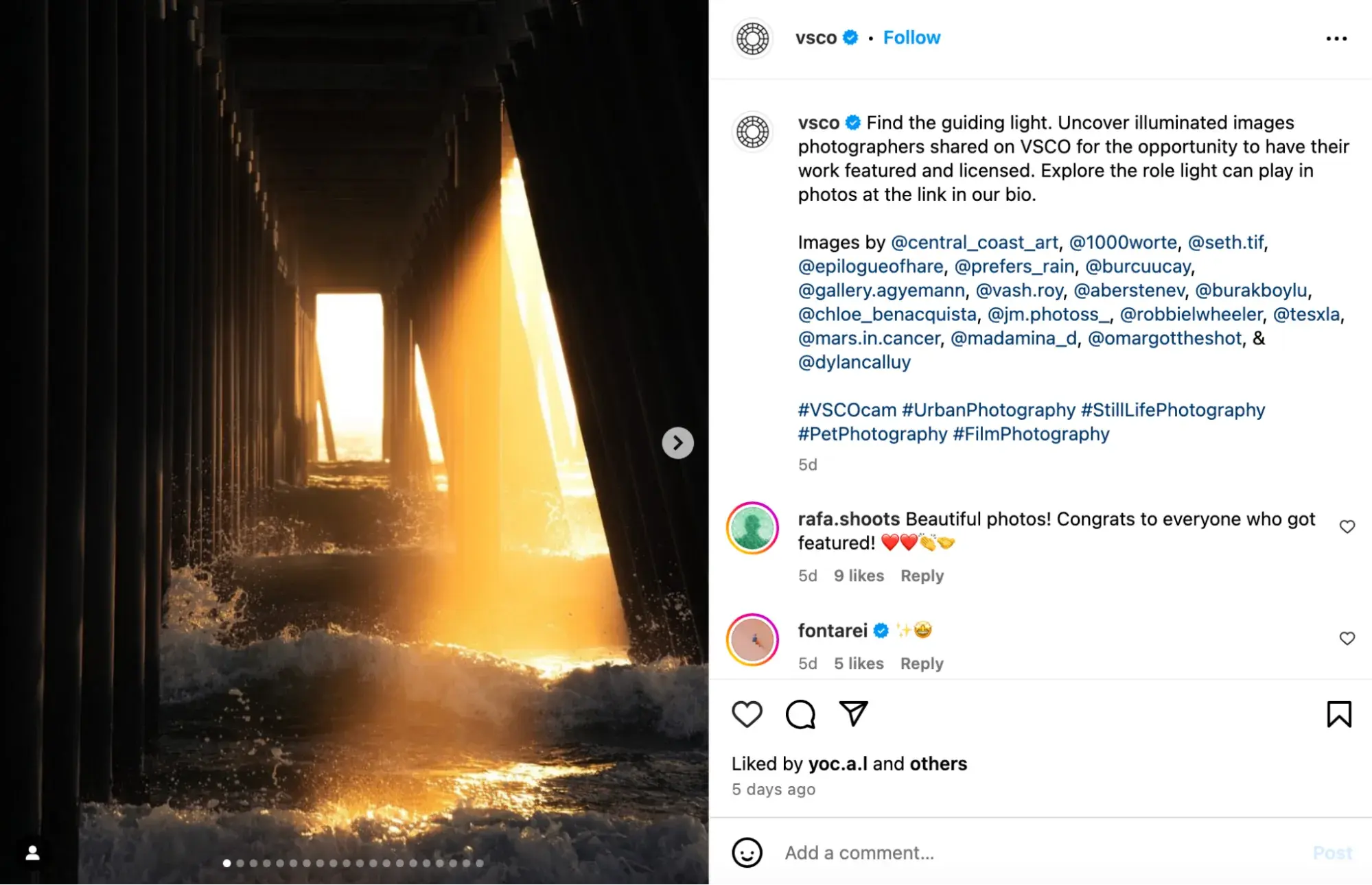
Pro tip: Give your followers an incentive to share. VSCO includes a CTA in its Instagram bio prompting users to share their images with the hashtag #VSCO. This gives users a chance to gain exposure by having their images shared with VSCO’s millions of followers. As a bonus, UGC also highlights the value of the app in action.

11. Use Stories Stickers.
We already know Instagram Stories get eyes with their prime real estate at the top of your page’s home screen, but the benefits don’t stop there.
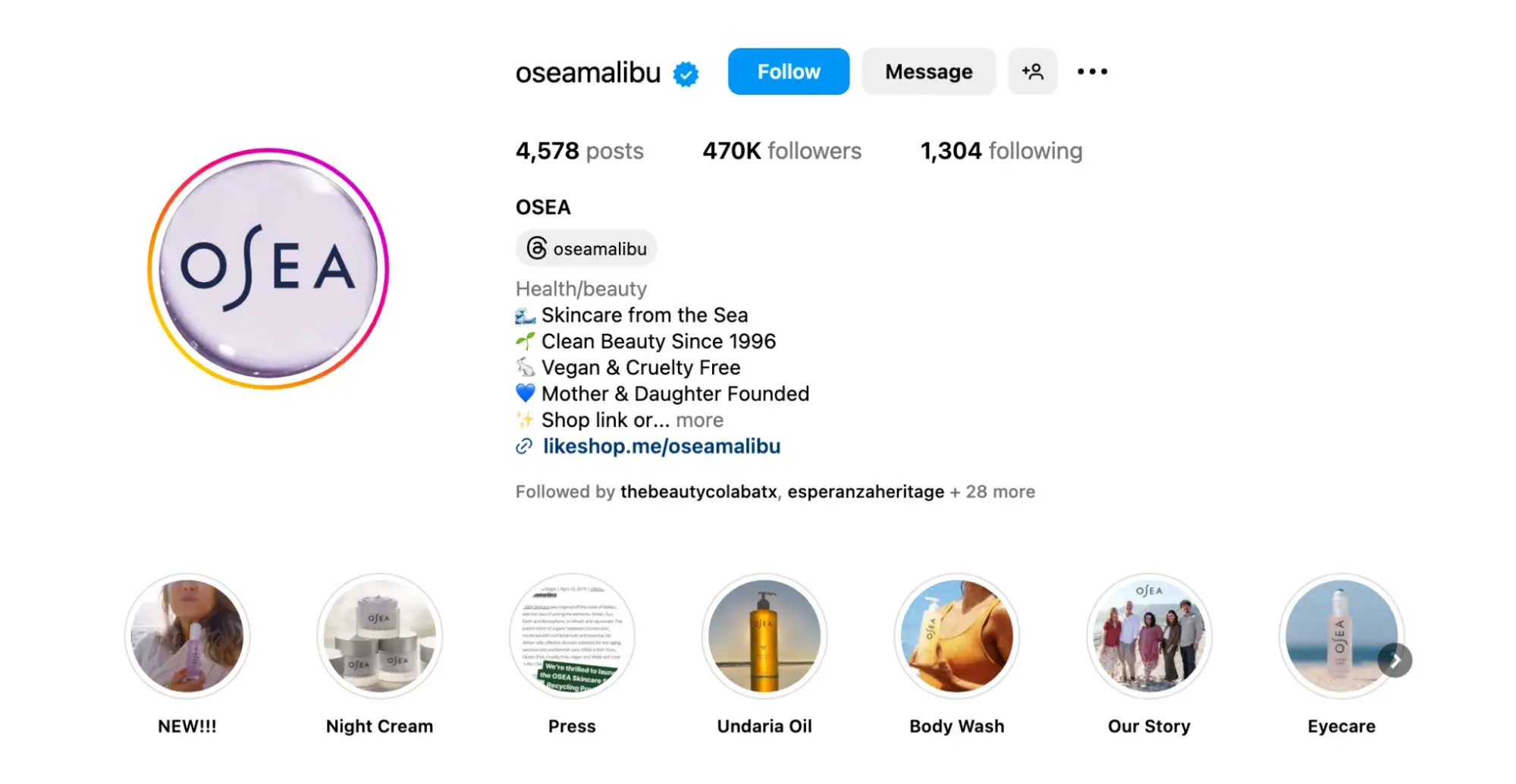
With the ephemeral nature of Stories, brands get to share more casual, timely content that can show personality. And Instagram Stickers add a whole new dimension to engagement.
Use Instagram Story stickers to create more dynamic content and interact with your audience and potential followers in an entertaining way.
Instagram Stories Stickers currently include:
- Links: Use these to link to content outside of Instagram (i.e., Your website, an event page, or a product page)
- “Add Yours”: Use these to create a prompt viewers can use to build their own stories. As a bonus, these are often used long after your 24-hour story expires.
- Hashtags: Use these to draw more visual attention to your branded hashtag or another campaign you’re involved in.
- GIFs: Add visual fun to your Stories.
- Music: Add trending audio or popular music to your Stories.
- Emoji Polls: Use polls to gauge your audience’s opinion on something.
- Questions: Field questions from your audience or use them to gather short feedback/answers to your own.
- Quizzes: These are a fun way to test your audience’s knowledge or tease upcoming content.
- Countdowns: Use these to promote upcoming events or announcements. Audiences can click a button to be reminded.
- Donation Links: Request donations for your cause or one you care about.
- Products: Make it easy for followers to shop directly by adding a product sticker to your Stories.
I like how Apartment Therapy engages its followers with questions in its Instagram Stories. This is a good way to grab followers’ attention and loop them into timely conversations around trends, product feedback, and more.
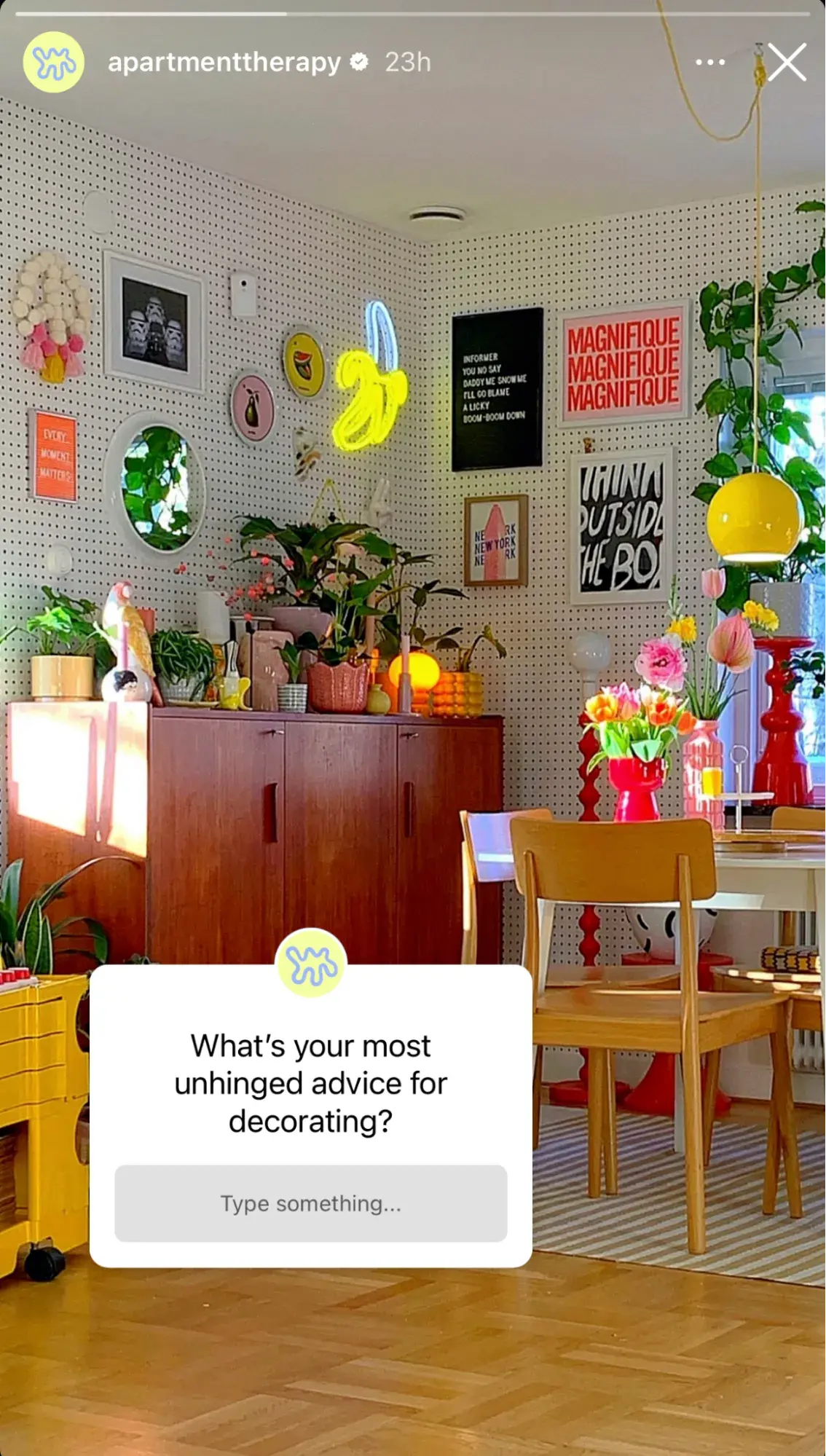
12. Go live on Instagram Live.
Instagram Live allows you to film and broadcast real-time video on your Instagram profile from a mobile device.
It also lets viewers engage with you in real time by leaving emoji reactions, asking questions in the chat, or even requesting to join you directly.
This kind of one-on-one, candid interaction and engagement builds a personal relationship with your audience. It also gives you the chance to show people who you are and why they should follow you.
If your live content is good, people will also want to share it, giving your Instagram presence even greater reach.
What should you do on Instagram Live? You can host a virtual press conference, make announcements, and host a live Q&A session. Live allows you to have up to four accounts on one broadcast so you can host an interview.
13. Collaborate with influencers and creators.
Want to get in front of your target audience? Partner with influencers and creators in your niche — the smaller, the better.
According to HubSpot’s 2025 Marketing Trends Report, nearly half of marketers agree that niche influencers and creators are more trusted by their followers.
William Gasner, CMO of Stack Influence, says creators and influencers not only drive sales and produce content, but they also dramatically increase social awareness.
“At Stack Influence, we’ve personally seen influencer campaigns quickly get brands tens of thousands of new followers in only a few days,” says Gasner.
As more marketers are seeing the power of nano influencers, Gasner also recommends working with micro influencers and creators when you’re just starting out.
“Nano and micro influencers will be more cost-effective and will collaborate for free products,” he says. “They will also generate higher engagement rates and they can be very niche targeted, as long as there’s alignment with your brand and products.”
Dive into which influencers, creators, or even other businesses your buyers follow. Are they relevant to your brand or offering?
For the canned water brand Maine Love, partnering with local influencers has made a major impact for the local business, according to Jeannie Assimos, Head of Content and Communications.
“They are all from Maine and represent the community and spirit of Maine, so the campaigns are resonating strongly with locals,” says Assimos. “I think it’s a win when you have someone representing a brand that fits the vibe and mission of the company.”

14. Run a contest or giveaway.
Another great way to expand your reach and gain followers is to run an Instagram contest or giveaway.
I mean, come on. Who doesn’t love winning free stuff?
Offering an entry to win a relevant prize in exchange for a follower and tagging a friend is common across Instagram these days. It’s also a highly effective way to get more followers.
Promotion Tips for Getting More Followers
15. Use relevant hashtags, geo-tags, etc.
Hashtags foster conversation. They unite posts on the same topics in one place so anyone from anywhere can find them and engage — even if they don’t know the creator.
Using relevant hashtags on Instagram is an easy but effective way to get in front of new followers.
Do some research to find the hashtags your audience is using. Start by navigating to the Explore tab and searching for a keyword related to your business or industry.
When you search for one hashtag, it shows you a list of related hashtags and the number of posts that already use them.
For example, when I search for #digitalmarketing on Instagram, relevant hashtags like #digitalmarketingagency, #digitalmarketingtips, and so on appear.
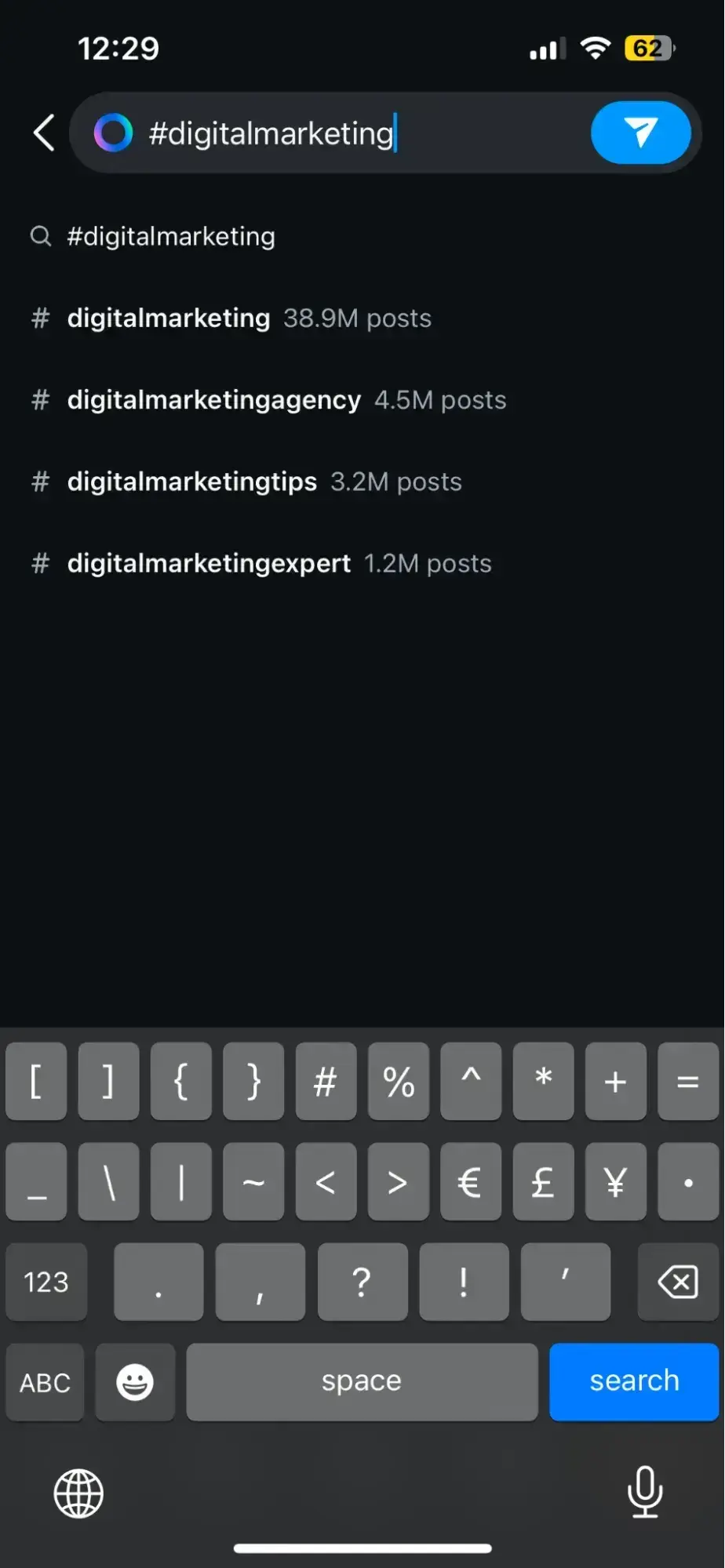
Once you build up a following, you can try creating your own hashtags — like your company name or a slogan that applies to your content. This is a great way to build up your brand on the platform and also foster user-generated content.
Similarly, tagging locations, brands, or personalities related to your content can grab their attention and get you in front of their audiences.
16. Try Instagram promotions and ads.
So far, the methods I’ve mentioned are about growing organically — but organic growth takes time.
If you’re looking for rapid growth, Instagram promotions and ads may be the answer.
Instagram ads (using the comprehensive Meta Business Suite) let you get granular about the audience you want to reach and pay to get your content in front of them. You can use ads to generate leads or boost a high-performing post to earn more views.
Here are a few articles to get you started:
- The Ultimate Guide to Instagram Stories Ads
- A Step-by-Step Guide to Advertising on Instagram
- The Guide to Instagram Ad Costs
- Instagram Ad Specs & Sizes: an Updated Guide
Pro †ip: If you run a contest, consider putting some ad dollars behind it to maximize the opportunity.
17. Share your profile link externally.
You’re doing the most to get noticed on Instagram, but don’t forget to promote your presence off the platform as well.
Have a website? Newsletter? YouTube channel? Make sure you include a link to your Instagram on your other platforms and properties. If your brand has brick-and-mortar locations, put your handle on signs or business cards with a QR code.
Embed posts in your blogs and mention it in your email newsletter.
In this example, Austin-based pet boarding company Bark and Zoom encouraged their email subscribers to follow them on Instagram with a simple incentive: the chance to win discounts and freebies.
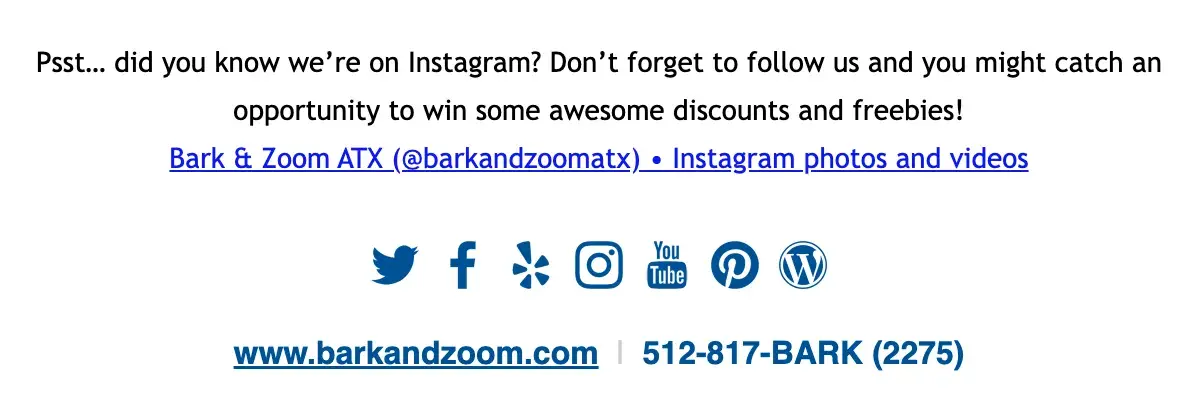
Embed your Instagram feed on your website and link to your profile on your other social channels. If people are already following you on another platform, it’s much more likely they’ll be open to following you on Instagram as well.
Pro tip: A link to your Instagram profile is built into HubSpot’s free Email Signature generator . Give it a try for your emails.
Attracting New Followers With Your Instagram Profile
An incomplete profile is a huge red flag to potential new followers on Instagram. Missing information can raise questions about why it’s missing which hurts your credibility (Remember what I said about fake followers?).
Here are a few best practices to make sure your profile strikes the right chord:
Choose a clear username.
Your Instagram username (or handle) should be recognizable and easily searchable — like your business name. In the example below, the UK business The Journal Shop uses the intuitive handle @thejournalshop.
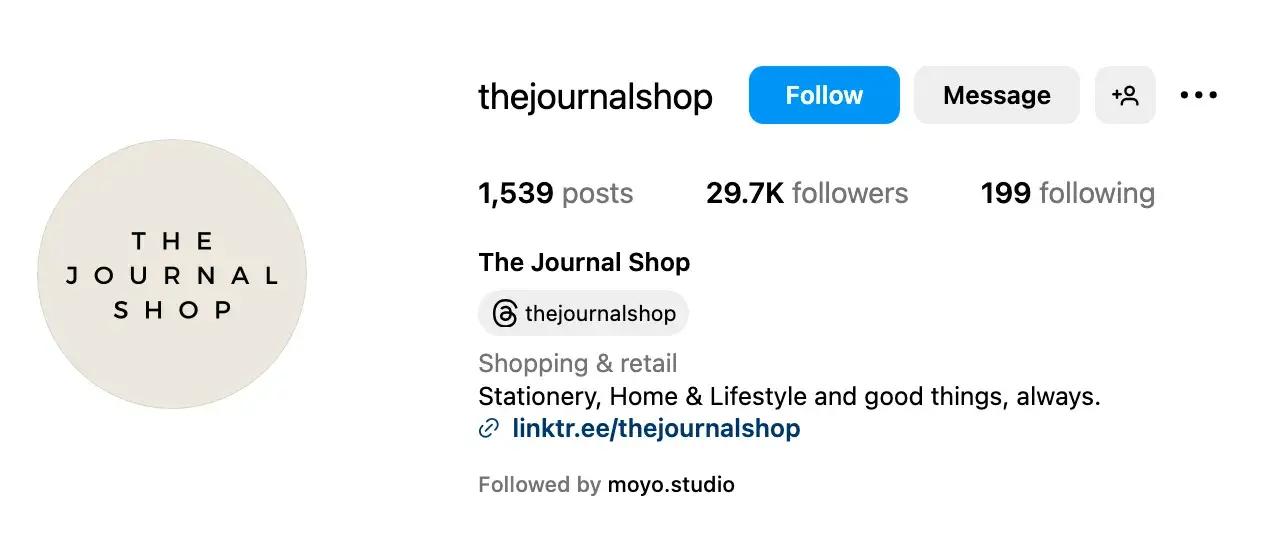
If your business name is already taken, experiment with related alternatives (i.e., something that includes your business name plus a branded item or a catchphrase).
For example, Peloton uses @onepeloton, while the Australian activewear line Lorna Jane uses @lornajaneactive.
While, ideally, you want to claim your name, variations like this still make your brand recognizable.
Have an on-brand profile picture.
This should be a clear, high-quality picture of your face if you’re a creator or logo if you’re a business. Again, you want people to easily recognize and identify you when they come across your posts.
Pro tip: Use the same profile picture across channels for instant recognition with your followers.
Add details next to your name.
Not everyone does this, but the name field on your Instagram profile is additional real estate you can use to introduce yourself on the platform. Use any extra space here to add details about your business or what you offer.
For example, HubSpot could put “HubSpot | AI-Powered Customer Platform.”
Style blogger Sarah Ramondt Lennon adds “Amazon Fashion” to hers.
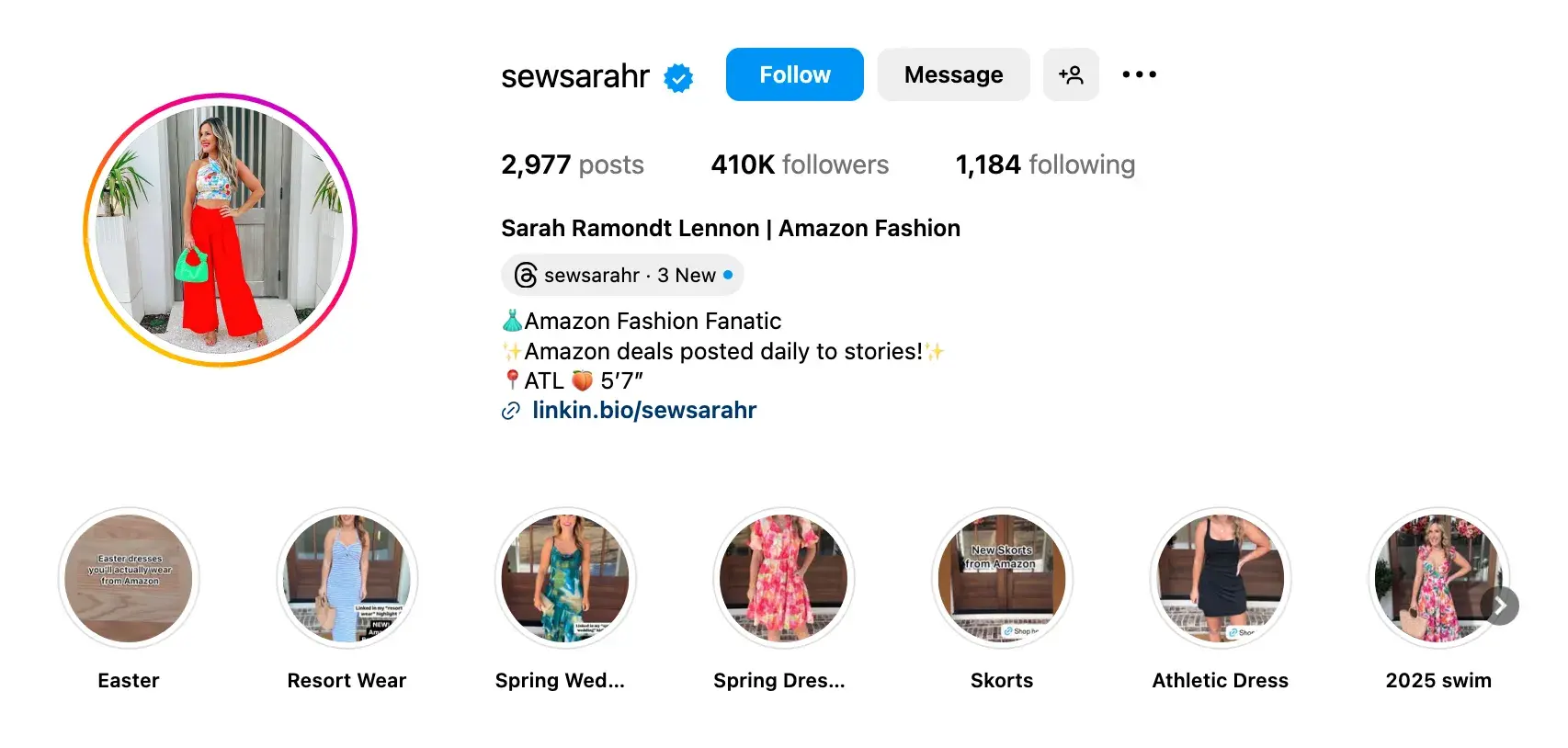
And financial advisor Andrew Lokenauth uses his to promote his newsletter and website.
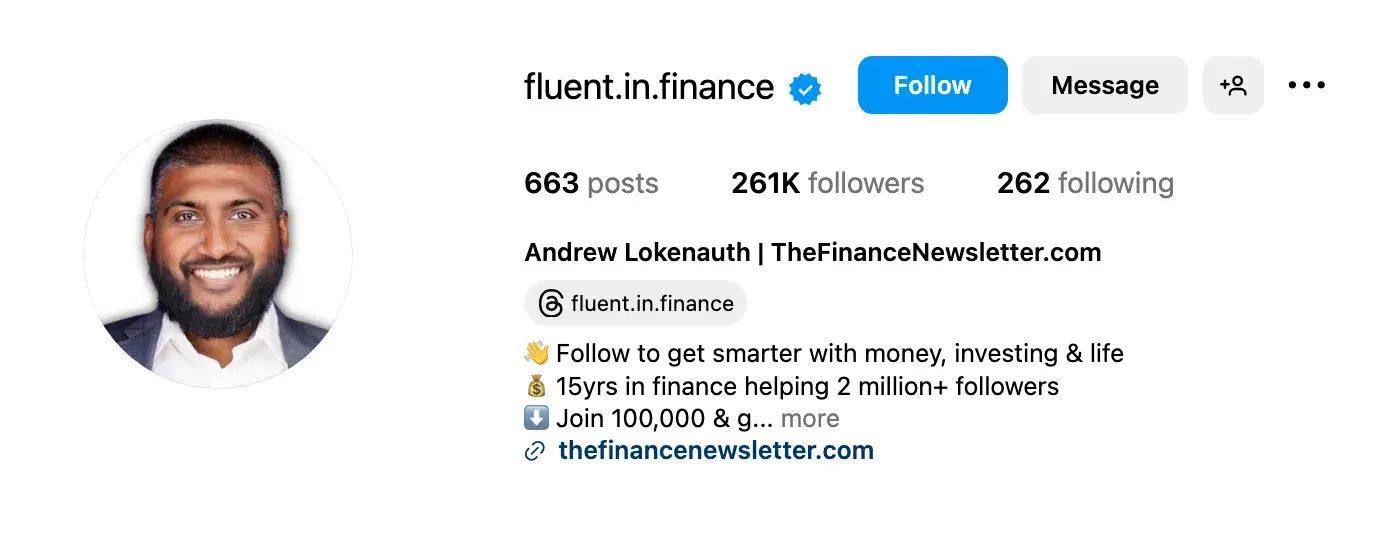
Adding these little extra details to your name field tells people what you’re about right when they land on your profile. If you want to get more followers on Instagram, then use this section to draw users in right away.
Share your value and personality in your bio.
Instagram only gives you 150 characters in your bio. Use them to tell people why they should follow you. Include who you are and what you do, but also a hint of personality.
Here are a few examples for inspiration:
- @cheekbonebeauty : “🧡 Indigenous Roots 🌱 Sustainable By Nature 🌎 B Corp Certified 🐰 Cruelty-Free 🐰 Cruelty-Free 🇨🇦 @sephoracanada 🇺🇸 @thirteenlune @jcpenney Founded by @cheekbonejenn”
- @oreo : “Playful moments from your favorite cookie.”
- @sahilbloom : “New York Times Bestselling Author of The 5 Types of Wealth. On a mission to redefine what it means to live a wealthy life.”
- @CalifiaFarms : “Because life’s too short for one type of milk. 🌱”
- @coragedolls : “Instilling cultural pride with products & stories that finally reflect her. #blackowned”
Add a LinkTree.
When you use the phrase, “check out my link in bio” make sure your link area is easy to navigate. You can add up to five links in your bio, but I recommend using LinkTree to bypass the limit.
You can use your LinkTree to guide people to your website and other platforms, content, offers — anything really.
Here’s a peek at mine:

Your bio link is your most direct play to get followers to take action, and it’s the only place you can have clickable links without paying. LinkTree helps you get the most out of it (and it’s free).
Establish your unique brand.
Have a brand color palette? How about a specific font or typeface?
Use these to develop a visual brand for all of the Instagram content you create.
Not only does it make your feed look more organized, cohesive, and professional, but it also gives visitors a way to recognize your content even out of context.
Beauty brand Live Tinted incorporates its brand colors (orange like HubSpot!) throughout its Instagram page and most of its content.
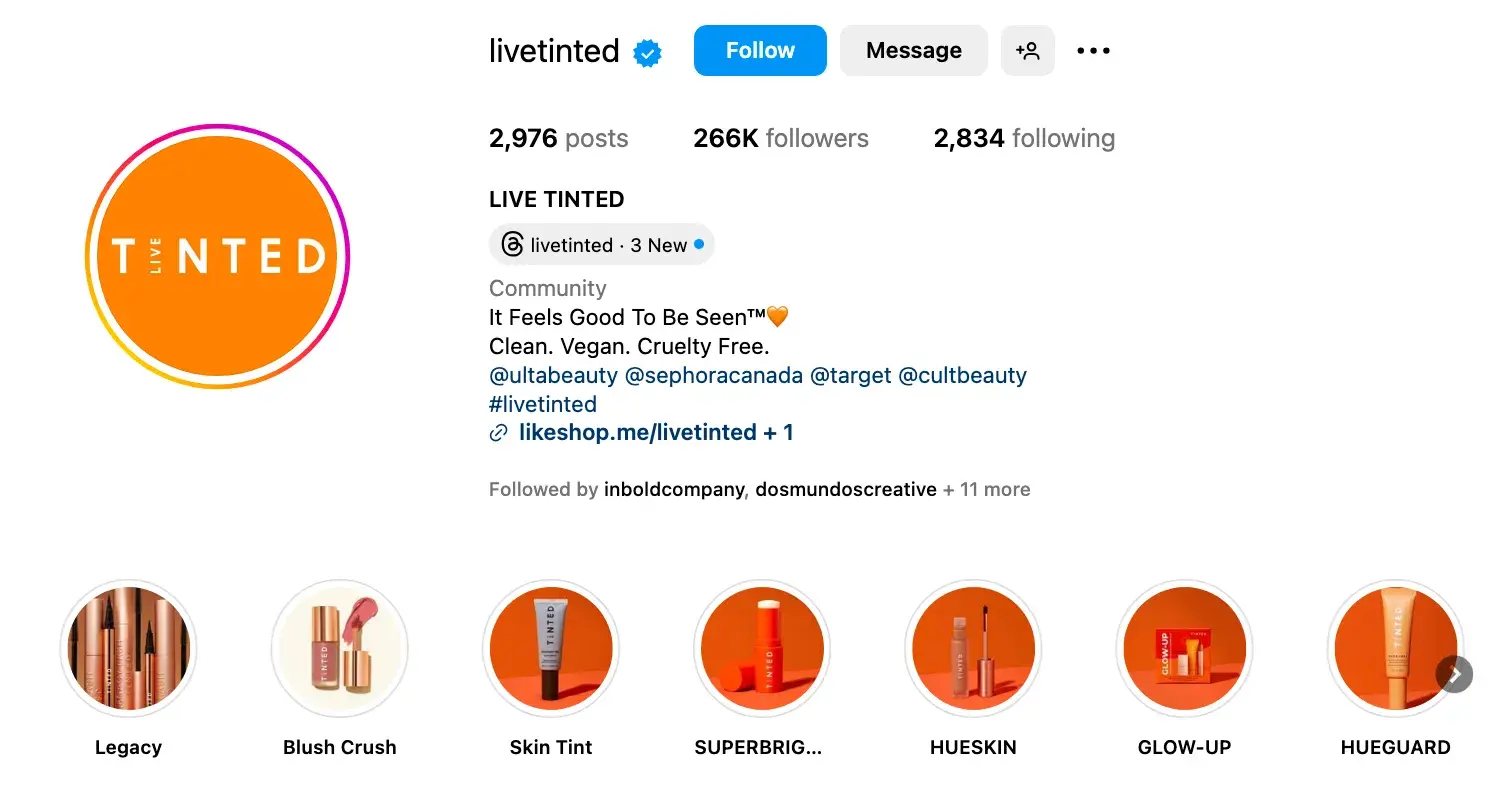
Note: Use our Instagram templates to create a consistent look and feel for your images.
You’ll also want to develop a consistent voice on Instagram; one that is cohesive with the rest of your brand and company culture.
The last thing you want to do is to be snappy and super casual on Instagram but formal and stoic everywhere else.
Once you’ve got your voice down, make sure it stays consistent and natural in your videos, captions, comments, and messages.
With your profile set up for success, I recommend having 15 or more existing posts before you actually start making a play for followers.
This way, when new people find you, they’ll see a full screen of content and get a better idea of what you offer.
If you haven’t already, download this social media content calendar template to help plan out your posts.
Here are some other resources that may help when filling it out:
- Free Instagram Business Templates
- What to Post on Instagram: Photo & Video Ideas to Spark Inspiration
- How to Plan Your Instagram Posts [+ Free Instagram Planning Templates]
Using AI to Get More Followers on Instagram
I know what you’re thinking, “Can AI just do this for me? AI does everything.”
To that, I say:
- Why would you want it to? So many of the spam accounts and fake followers I talked about earlier are bots. They don’t work long-term.
- I’m sorry to disappoint you, but no, it can’t.
Just like a hammer can’t build a house for you, artificial intelligence (AI) cannot just get you more followers on Instagram — at least not the real, organic followers you want. AI is simply a tool.
What AI can do is help you execute some of the strategies I shared more efficiently and effectively. For instance:
- Adobe Firefly or other AI image generators can help you create visuals to post.
- HubSpot’s Free AI Content Writer can help you write captions.
- AI video generators can help you create Reels.
According to HubSpot data, 43% of marketers are using generative AI to create content. This includes writing copy and creating images. 27% are also using AI to brainstorm content ideas.
There are also a number of automation tools that can help expedite your engagement as well.
ManyChat, for one, can be used to set up an automatic response to comments on your Instagram posts or to send a personal message when people use a specific word or phrase.
But even with these aids, it’s important to remember that increasing your Instagram following, like any social media success, comes back to human connection.
People turn to social media to stay connected with the people and brands they care about. They follow what they’re interested in, get value from, and want to support.
Building a real, emotional connection is the most effective and lasting way to build a following and that is something AI cannot currently provide.
Concerns about plagiarism, bias, and inconsistent quality also make a solid argument for treading lightly with AI when it comes to your Instagram strategy.
How Not to Increase Instagram Followers
AI aside, you may be tempted to take other shortcuts to get more followers on Instagram.
Trust me, these tactics often do more harm than good (read: decreased engagement, penalizations, or even bans.)
Let’s unpack a few ways not to increase your follower count.
Don’t buy Instagram followers.
Eager for opportunities, some users resort to buying followers on Instagram.
At its core, buying followers is unethical and in violation of Instagram’s community guidelines. This can damage your brand’s reputation by eroding trust.
Then, there are the tactical impacts of this approach.
Fake followers can‘t engage. As I mentioned earlier, these accounts won’t like, comment, share, or repost your content. This lack of engagement sends a signal to the platform that your content isn’t interesting or useful to your followers.
While inflating your follower count, fake followers will erode metrics like:
- Organic reach
- Likes
- Comments
An inflated follower count will also make it tougher for you to measure the actual effects of social campaigns and strategies. Instead, focus on growing organic followers who are excited about your brand and content.
Don’t overuse hashtags.
Using too many hashtags in your Instagram captions can have a negative impact on your follower count for a few reasons:
- It can dilute the message or storytelling behind your post by distracting viewers from the core content and making your captions appear less clear and cohesive.
- It can attract an audience that is not genuinely interested in your posts. This can lead to low engagement and a high bounce rate, because those followers are unlikely to interact with your content or become loyal followers.
- It can make your posts look spammy or desperate for engagement. This can deter users from viewing or following your account, as it appears less authentic or professional.
Instead of casting a wide net with numerous hashtags, I recommend focusing on using relevant and targeted hashtags that align with the content of your post.
This way, you are more likely to attract users who are genuinely interested in your niche and increase the chances of engagement and follower growth.
Don’t post low-quality or unoriginal content.
Your account is unlikely to attract new followers if you consistently share low-quality content or content that can be found elsewhere.
Users’ feeds are oversaturated with content, and posting sub-par or generic content does nothing to add value to those feeds.
By producing visually appealing, unique content that offers something valuable to your audience, you can enhance engagement, foster a positive perception of your brand, and truly earn more followers.
Earning Your Instagram Followers
If you want a large, engaged, lucrative Instagram following, you need to earn it.
Ultimately, it’s important to focus less on the number of followers you have and more on the quality of content you create.
In my experience, when you put effort and time into creating engaging, informative, or inspirational content without worrying about “quick fixes” for boosts in followers, your followers will come naturally and happily.
Editor’s note: This post was originally published in February 2016 and has been updated for comprehensiveness.
![]()
How Privy’s former CMO learned to love low-budget, scrappy marketing
If you’re a startup founder or marketer trying to build momentum with little to no budget, good news: Being scrappy is the best place to start. Some of the most effective marketing I’ve ever done — from the early days of my career to my […]
MarketingIf you’re a startup founder or marketer trying to build momentum with little to no budget, good news: Being scrappy is the best place to start. Some of the most effective marketing I’ve ever done — from the early days of my career to my time at Drift — came from moments when there was no budget at all.
When you don’t have big dollars to hide behind, you’re forced to get creative, move fast, and figure out what actually gets attention. You learn by doing, not by building 40-slide decks to ask for $50,000.
In this piece, I’ll walk you through real examples of scrappy marketing tactics that worked, and how you can steal them for your own playbook.
My Own Experience With Low-Budget Marketing
My first job out of college was at a PR agency. This was back in 2009, and the “playbook” was pretty traditional. I built a list of reporters, cold pitched them, hoped for a hit. But social media was just starting to change the game. I realized I could skip the outdated tactics by connecting with reporters directly on Twitter.
I‘d follow their work, comment thoughtfully on their posts, and DM them pitches that showed I actually understood their beat. This wasn’t rocket science. But at the time, no one else was doing it. And, it worked. I started getting quick wins, and internally, people were wondering what my “secret” was. The truth? I was just scrappy and curious.
I also used to ghostwrite for one of the executives at the same company. I would spend all day finding blogs and drafting comments on blog posts, back when blog comments were a community builder.
That would lead to coverage. Thoughtful comments would turn into future opportunities because you’d be seen as an expert. The reporters would say, “Wow, this is a really good comment on this article. Hey, let’s feature this person in the next article.”
Early in my career, I read and devoured everything about social media marketing, digital marketing, and online marketing. I loved the world of posting on Reddit and answering questions on Quora.
Later at HubSpot, I helped launch the company’s first podcast, The Growth Show. I’d find relevant subreddits and creatively promote the podcast. We got a lot of links and a lot of love. I just kind of fell into this scrappy level of marketing.
At Drift, I applied that same mindset at scale. We didn’t buy billboards across San Francisco, but we did buy one billboard outside a key customer’s office for $1,200. We put a screenshot of her tweet on it, and she ended up taking a photo in front of it. That tweet did more for us than any display ad ever could.
Or take the time we went to SaaStr. We didn’t have a booth. Our CEO had a speaking slot, and I flew out with my podcast gear in my backpack. I recorded interviews, wrote articles, and created a ton of content — all for the price of a plane ticket.
So, how can you make a big impact with a small budget? Here are my biggest learnings.
4 Tips for Marketing Without a Budget
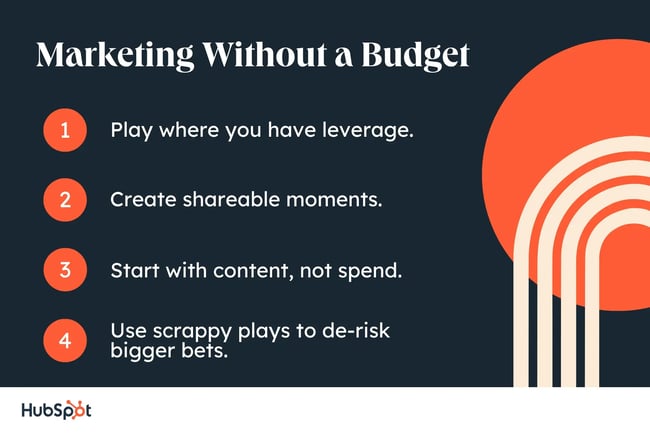
1. Play where you have leverage.
The fastest, most cost-effective place to start is social media. It’s where people hang out, whether they’re buying software or shoes.
When I say social, I don’t just mean paid ads or promo posts. I mean actually showing up where your audience spends time. That might mean posting on LinkedIn, replying to threads on Reddit, or sharing insights in niche Slack groups.
2. Create shareable moments.
The best scrappy plays are often the most memorable. At Drift, we sent handwritten notes and shirts to new customers. Why? Because they took pictures and shared them. It created organic reach and goodwill.
When I launched my book, I paid $5K to plaster posters around Boston like a musician would promote a show. People saw them, took pics, and spread the word.
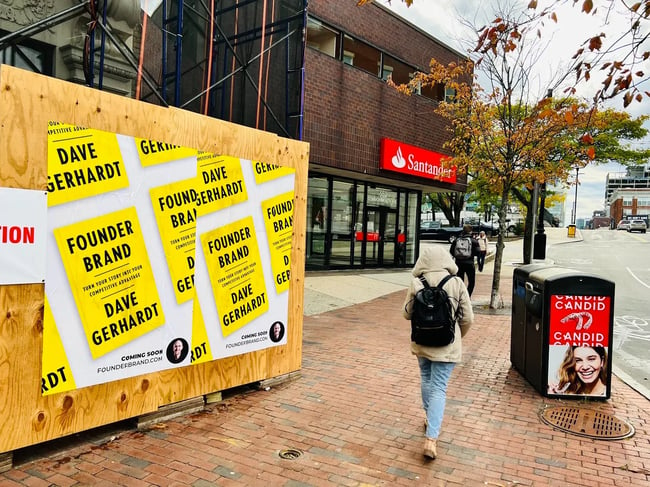
3. Start with content, not spend.
Most marketers ask, “How much can we spend on this campaign?” But instead, they should ask, ”What’s the most helpful or interesting thing we can make?”
No matter what you make, content that connects is actually high quality, unique, and interesting. I find a plain-text newsletter with real insights much more engaging than a beautifully designed send with custom graphics. A podcast with low-fidelity audio can be more valuable than one made in a state-of-the-art studio.
Focus on getting information into the world that adds value for your audience. You can iterate, then put money behind plays that work.
4. Use scrappy plays to de-risk bigger bets.
Scrappy experiments are low-risk ways to test ideas. Before you invest in a large sponsorship or campaign, test the message organically. Does it get traction on social? Does it resonate with customers? If so, then double down with spend.
Don’t think of being scrappy as an alternative to having a budget; instead, you can use it as a testing ground for great ideas you can double down on.
Scrappy marketing is a mindset.
There’s nothing wrong with spending your marketing budget — after you’ve earned the right to. Budget should amplify what’s already working, not compensate for a weak idea.
Your spend should follow signal. If something scrappy works, put money behind it. Maybe that means sponsoring the event where you had organic momentum. Maybe it means turning your plain-text newsletter into a beautifully produced podcast.
What I don’t believe in is starting with spend. I’d rather make $5K go 10x further with a smart idea than burn it on a booth no one remembers.
Remember, scrappy marketing isn’t just for early-stage startups or underfunded teams. It’s a mindset. It’s about staying close to the customer. Moving fast. Testing before scaling. Creating great content and building trust in places that matter.
That’s the game I’ve always played. And, I’d bet on it every time.
![]()
17 marketing job descriptions for hiring managers to attract ideal candidates
Looking to grow your marketing team? It all starts with marketing job descriptions written to attract your best potential. Wording, structure, even emojis — everything counts. I’ve encountered countless job descriptions during my time as a marketer and have learned a thing or two along […]
MarketingLooking to grow your marketing team? It all starts with marketing job descriptions written to attract your best potential.
Wording, structure, even emojis — everything counts. I’ve encountered countless job descriptions during my time as a marketer and have learned a thing or two along the way.
Not surprisingly, 52% of job seekers say the overall quality of a job description is an influencing factor when they decide to apply for a job. So I like to think of job descriptions as being a powerful tool for advertising your company.
If you want to learn how to craft an irresistible one, start with this guide that includes 17 real-life examples and learn how brands market their open positions.
Table of Contents
As you embark on writing job descriptions for open roles on your team, make sure you include the following pieces of information.
Marketing Job Requirements and Qualifications
Before you draft a clunky job post, remember: less is more. The right candidates are out there — don’t scare them off with an impossible checklist.
- Start with the must-haves like core skills, the level of seniority, education, and areas of previous experience a candidate would need to have to be successful in the role.
- Include soft skills like strategic and agile thinking, communication, and organizational skills.
- Specify the role details, like whether it is remote or hybrid, and how many days would be required in the office.
- Ask for realistic requirements for your candidate pool, given your compensation budget.
- Stay open to non-linear paths. The best marketers don’t always come from a traditional background, especially since few have a marketing major.
Note: The requirements and qualifications section can be intimidating for some job applicants, and if it’s too extensive, you could scare off candidates who may be a good fit for the role, even if they have a different level or type of experience.
I love how HubSpot increases the pool of applicants by adding a genuine nudge to apply.

Marketing Job Responsibilities
This section should clearly outline what tasks and duties the person in this role will be responsible for. When a candidate reads the job responsibilities section, they should be able to clearly understand what the role entails and how the role fits into the broader organization.
Pro tip: Avoid overly narrow criteria that can limit diversity and miss candidates with unconventional but valuable experience. Here’s how Lemlist approaches a listing of job responsibilities for a product marketing role:
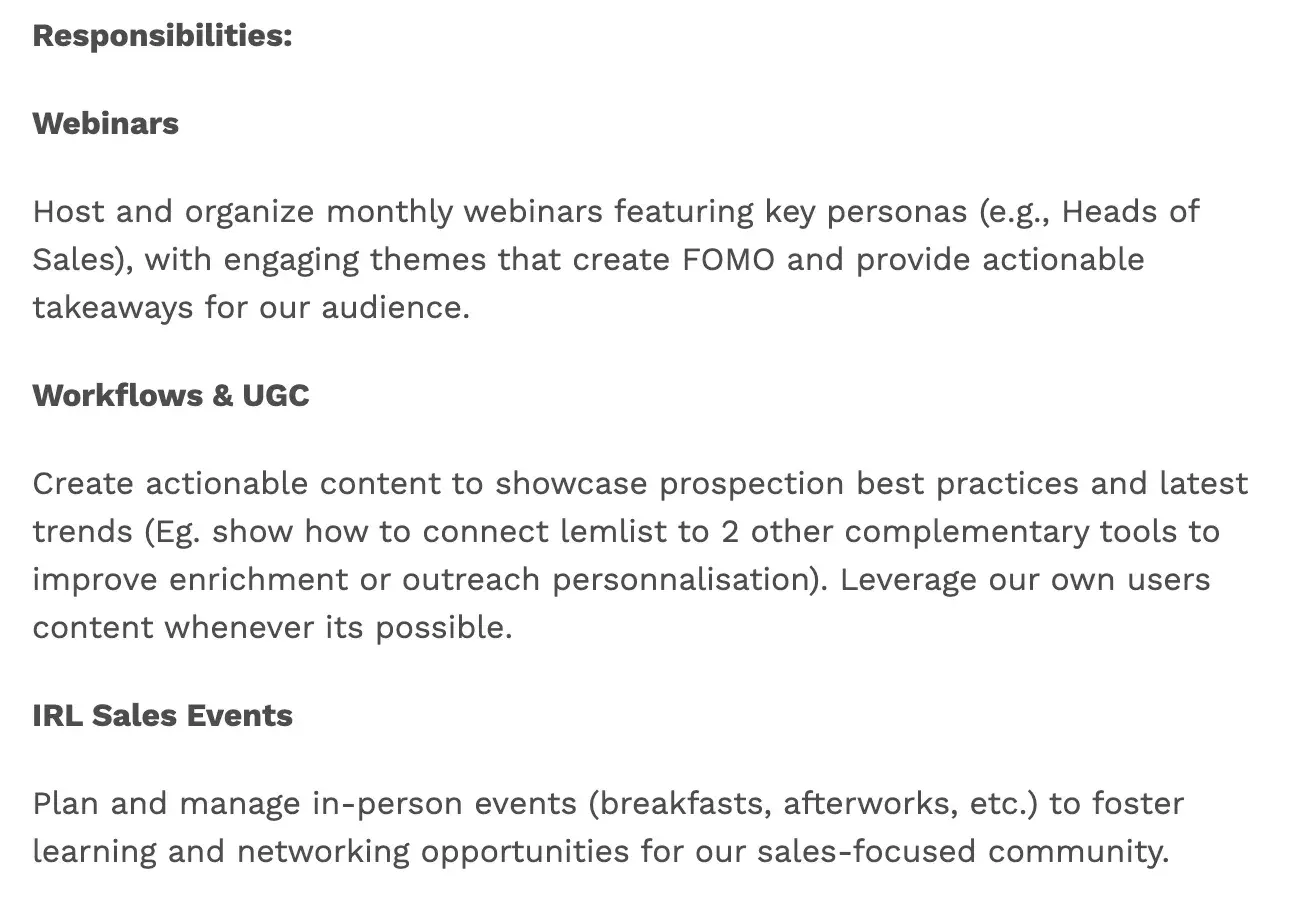
The company bolds the jobs to be done and gives a succinct description.
Marketing Job Skills
Similar to job requirements and qualifications, this section should state what technical and/or soft skills are needed for a candidate to perform in the role.
For example, if you’re looking to hire a content marketer, you may list “strong writing skills” as a mandatory skill. Or, if you’re hiring a marketing analyst, you may list “data analysis” as a skill needed to be successful in the role.
See an example:
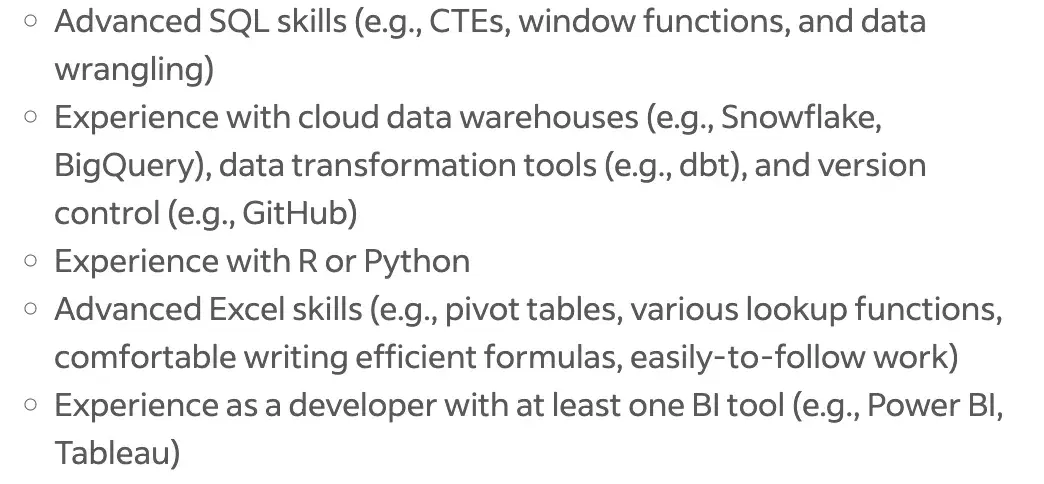
Now, let’s discuss the ways a job description will need to be customized for a particular role.
Types of Marketing Jobs
The job description you craft will need to be highly tailored to the role you’re hiring for. After all, if you’re hiring for a technical SEO role, you don’t want to create a description that will attract newbies. Here are some of the most common types of marketing jobs available for modern marketers:
- Digital Marketing
- Content Marketing
- Product Marketing
- Brand Marketing
- Event Marketing
- Marketing Analysis
- SEO
- Public Relations
- Fractional Marketing
- AI Marketing
Ready to write a job description that attracts stellar candidates? Check out this list of sample descriptions for common marketing roles.
1. Marketing Assistant Job Description
The marketing assistant role is key to helping a marketing organization run smoothly and effectively. Individuals applying for this role should have demonstrated the ability to handle a variety of administrative tasks efficiently and independently. They must be fast learners and agile.
Job Description
Our team is hiring a marketing assistant to keep our organization running smoothly. The ideal candidate will have experience managing multiple projects for key stakeholders and maintaining excellent communication.
Responsibilities
- Support the marketing leadership team through the organization and administrative support for various projects.
- Maintain strong communication between marketing executives and internal and external stakeholders.
- Coordinate employee meetings and communications for the marketing department.
- Maintain executive schedules and oversee project load.
- Plan, prepare, and deliver presentations on behalf of the marketing team.
- Conduct research for key marketing campaigns.
Requirements
- High school diploma or equivalent experience. BA/BS is a plus, but is not required.
- Experience managing multiple projects and adhering to deadlines.
- Clear copywriting and editing skills.
- Strong organizational, communication, and customer service skills.
- Proficiency in Microsoft Office or Google Workspace.
What Hiring Managers Look for in a Marketing Assistant
An effective marketing assistant should be organized, communicative, and able to prioritize while working on various projects. Candidates who can demonstrate these abilities through work experience could be a good fit for a marketing assistant role.
Real-World Example
This job opening from 24 Seven Talent is a great example. Not only did they list expected skills, but they also disclosed a salary and benefits package.
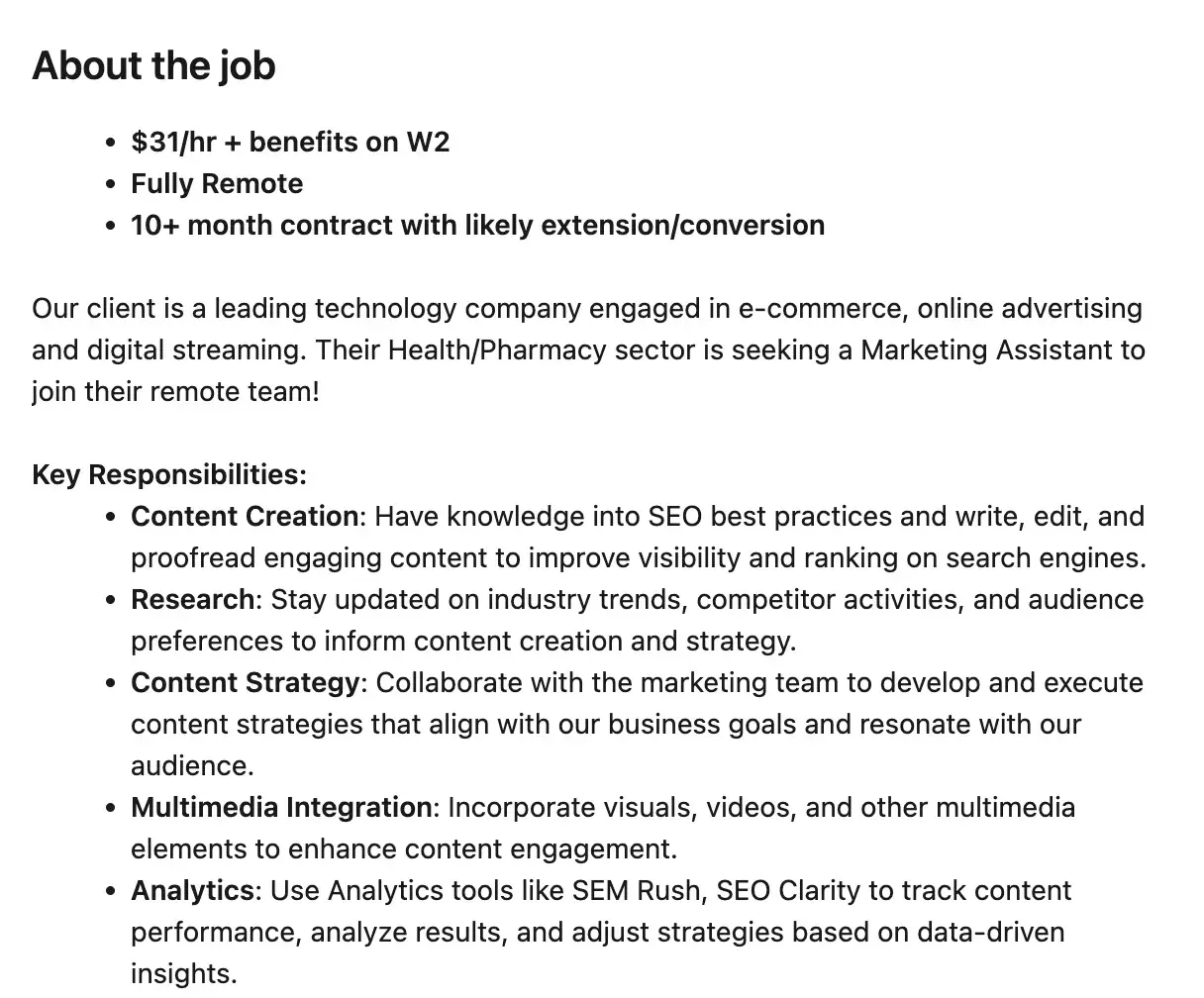
2. Marketing Coordinator Job Description
Do you have someone on your team making sure marketing activities are organized and cohesive? If not, consider hiring a marketing coordinator. In this role, an individual is responsible for managing various projects within the marketing organization to ensure they are on time and within their budget.
Job Description
Our team has a suite of exciting projects underway and we are looking for the right candidate to help us execute them in the marketing coordinator role. With various campaigns and initiatives on the horizon, we’re hiring a skilled marketing coordinator to design and oversee marketing campaigns across platforms to reach company goals and increase brand awareness.
Responsibilities
- Work directly with project managers, designers, social media, and content teams to design and implement key marketing campaigns.
- Perform competitive research to understand what’s happening in the market, and incorporate your findings into each campaign for better results.
- Facilitate cross-functional communication among project stakeholders.
- Conduct analysis to determine the effectiveness of each marketing campaign, and report key findings to stakeholders.
Requirements
- BA/BS or equivalent working experience.
- Working knowledge of customer relationship management (CRM) and content management systems (CMS) like Content Hub.
- Demonstrated project management experience.
- Research and analytical skills.
- An understanding of digital marketing tools and tactics.
What Hiring Managers Look for in a Marketing Coordinator
A qualified candidate for a marketing coordinator position should have experience supporting marketing campaigns and conducting research to understand the company’s customer base and ability to reach campaign objectives.
3. Social Media/Community Manager Job Description
Social media has become an integral part of business. A social media coordinator is the top priority hire for 2025 in marketing teams, according to HubSpot’s 2025 State of Marketing.
So if you aren‘t yet using social media marketing to your advantage, it’s time to start. And to do so, you need a social media manager who not only knows social media platforms like they know the alphabet, but who also knows how to develop strategies specific to various social networks, track the right metrics, and integrate the best tools and practices on those platforms.
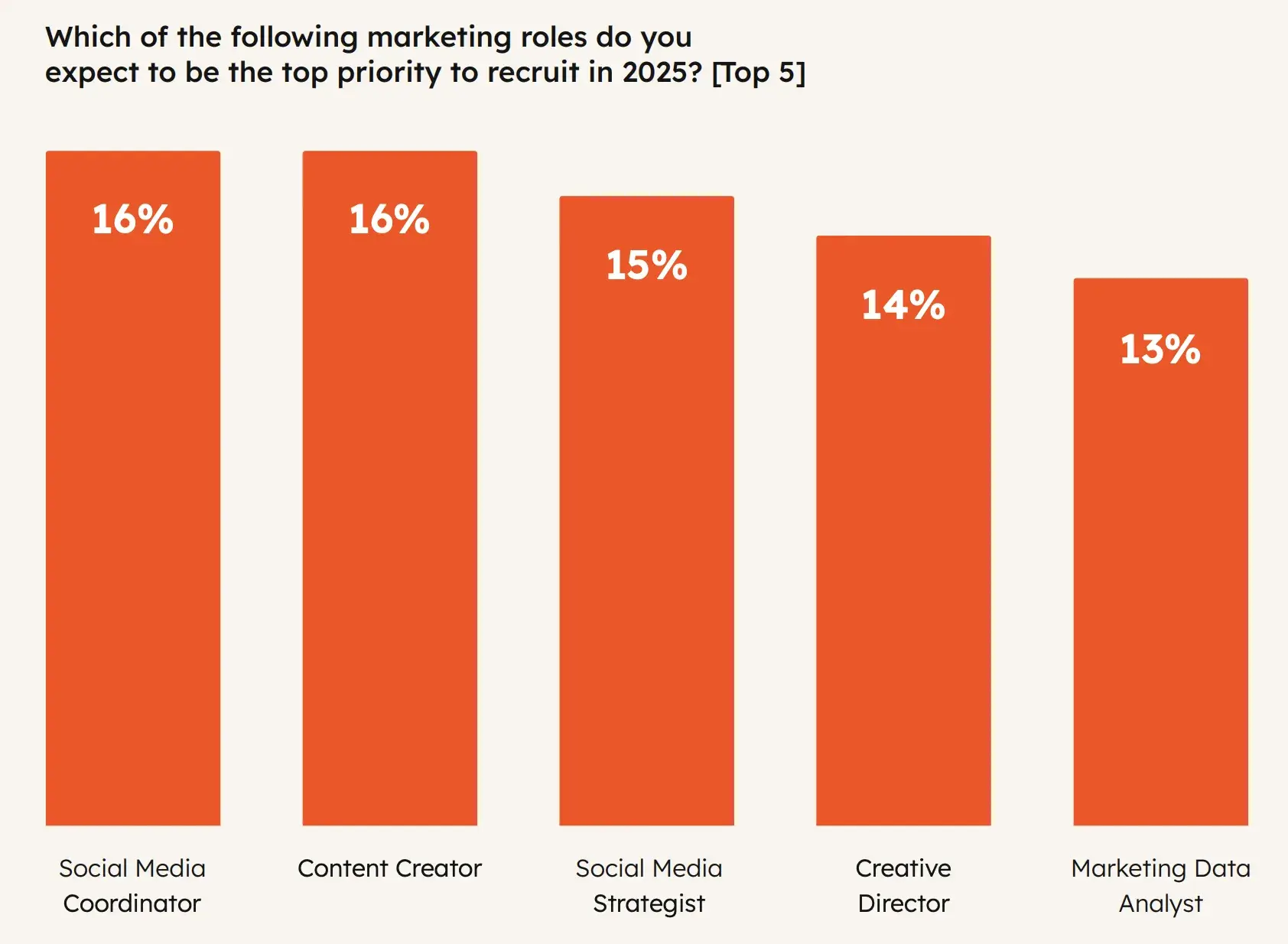
Job Description
Do you tweet, share, and post to social media in your sleep? Do you know what it takes to grow an online community? We’re looking for a social media manager to manage our social media accounts by implementing strategies and tactics that grow our followers, engage and retain them, and help convert them into leads, customers, and active fans and promoters of our company.
You should have command of best practices and trends in social media marketing, enjoy being creative, and understand how to both build and convert a digital audience.
Responsibilities
- Build and manage the company’s social media profiles and presence, including Facebook, X, LinkedIn, TikTok, and additional channels that may be deemed relevant.
- Create shareable content appropriate for specific networks to spread both our brand and our content.
- Monitor and engage in relevant social discussions about our company, competitors, and/or industry, both from existing leads and customers as well as from brand new audiences.
- Run regular social promotions and campaigns and track their success (e.g., X chats, LinkedIn discussions, etc.).
- Work alongside other marketers and content marketers to help distribute content that educates and entertains our audience and supports marketing goals.
- Drive consistent, relevant traffic and leads from our social network presence.
- Explore new ways to engage and identify new social networks to reach our target buyers.
- Track, measure, and analyze all initiatives to report on social media ROI.
Requirements
- BA/BS degree or equivalent work experience.
- Active and well-rounded personal presence in social media, with a command of each network and its best practices.
- Excellent communicator and creative thinker, with an ability to use both data and intuition to inform decisions.
- Proficiency in using social media software (e.g., HubSpot’s Social Inbox ) to monitor social media conversations. You will be our ear to the ground to route the appropriate marketer, sales rep, and/or support rep to social conversations.
- Bonus experience and skills include Adobe Creative Suite, demand generation, inbound marketing, and blogging.
What Hiring Managers Look for in a Social Media/Community Manager
A genuine interest in the latest social media trends and the ability to implement and carry out relevant social media campaigns.
Skill up your social media managers with HubSpot Academy’s Social Media Courses. Plug them into the onboarding program to ensure your brand follows the latest trends and best practices.
Choose from YouTube Marketing, Facebook Ads, End-to-end Instagram Strategy, and more.
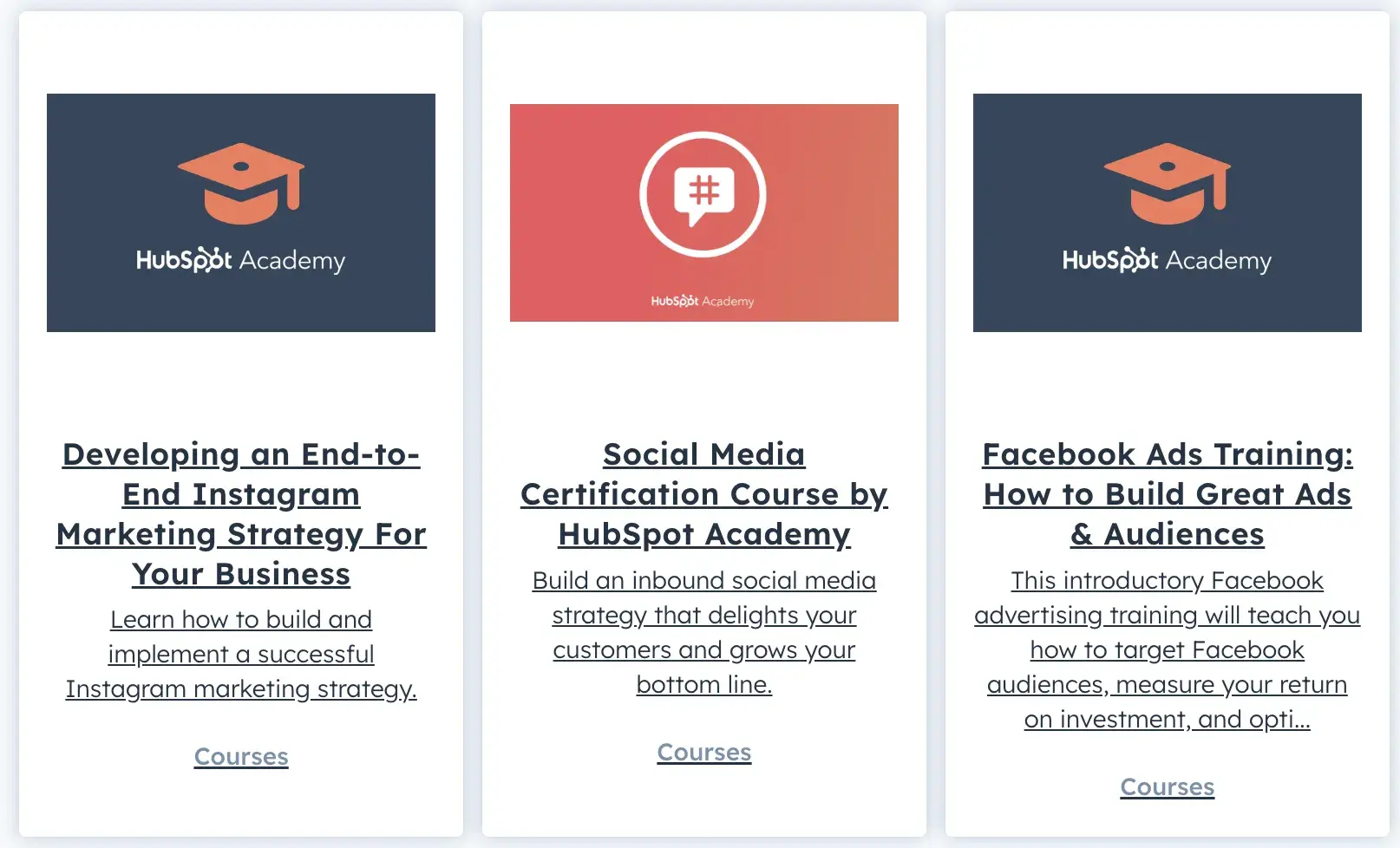
4. Blog Manager Job Description
Did you know that SEO blogging was the top B2B marketing channel, resulting in ROI, according to HubSpot’s State of Marketing Report 2025? Likewise, content marketing ranked in the top three for B2C.
If you aren’t taking business blogging seriously enough, now would be the time. Hiring a dedicated blogger or blog manager is crucial to creating remarkable content.
Our research shows that blog posts and interviews still take 3rd and 4th place across content formats for 2025.

You need someone who is not only a great writer and editor, but who can also keep your brand voice consistent across daily published content and understand how to use your blog to generate qualified traffic and leads for your business.
Job Description
We are seeking a savvy wordsmith to join our blogging team. Candidates must have a knack and love for writing, a comprehensive understanding of the industry, and experience in blogging to achieve business goals. The blogger will be expected to sustain and develop the company’s voice across all blog content.
Responsibilities
- Writing various types of articles on a wide range of topics for our blog.
- Providing feedback to other contributors and editing other writers’ content.
- Optimizing content for search engines and lead generation.
- Contributing to long-form content projects such as ebooks.
- Conducting analytical projects to improve blog strategies/tactics.
- Growing blog subscribers, converting visitors into leads, and expanding our blog’s overall reach.
Requirements
- A passion and strong understanding of the industry and our business’s mission.
- Exceptional writing and editing skills, as well as the ability to adopt the style, tone, and voice of our business’s various types of content.
- An analytical mind and interest in using data to optimize/scale blog marketing strategies and tactics.
- Excellent organizational skills to work independently and manage projects with many moving parts.
- 2-3 years of marketing and content creation experience.
- Familiarity with SEO, website testing, and analytics tools, including SEMrush, Ahrefs, SurferSEO, Google Analytics, Google Search Console, and VWO.
- A working knowledge of HTML/CSS/JavaScript and experience with CMS platforms such as WordPress.
What Hiring Managers Look for in a Blog Manager
An ideal blog manager will understand your buyer personas so well that published content addresses their needs, wants, and problems. Plus, blog managers must be well-versed in analytics and CMS platforms like HubSpot CMS or WordPress. Ideally, they know how to work with WordPress plugins and AI agents that facilitate blog posting.
5. Inbound Marketing Manager Job Description
This role is crucial for small businesses that want to scale up and for startups since inbound marketing plays a huge role in attracting leads at lower costs than other channels.
If this is the case, you’ll likely be looking to hire an all-in-one inbound marketer — someone who can build and grow your inbound marketing strategy from the ground up.
Job Description
We are looking for an amazing, data-driven inbound marketer to own the majority of our company’s marketing funnel. You will be in charge of attracting site traffic, converting that traffic into new leads for the business, and nurturing those leads to close into customers, the latter of which sales leadership will help you accomplish.
Responsibilities
- Build and manage a rich content/editorial calendar that attracts a qualified audience to our owned properties (including blog posts, whitepapers, ebooks, reports, webinars, infographics, etc.).
- Grow new leads, including marketing-qualified leads, by converting site traffic through calls-to-action, landing pages, and lead generation content (including offers).
- Optimize our marketing automation and lead nurturing processes through email, content, and social channels.
- Establish closed-loop analytics with sales to understand how our inbound marketing activity turns into customers, and continually refine our process to convert customers.
Requirements
- BA/BS degree or equivalent work experience.
- 3+ years of experience in SEO, paid search, or digital marketing, with team leadership experience.
- Strong skills in Google Ads, LinkedIn Ads, Facebook Ads, and SEO tools (Google Analytics, SEMrush, Ahrefs, Clearscope, etc.).
- Excellent communicator and creative thinker, with an ability to use data to inform all decisions.
- Proficiency in AI-powered tools, marketing automation, and blogging software in order to generate traffic, convert visitors into leads, and nurture them (using dynamic workflows) into converted customers.
- Bonus skills: HTML/CSS, Adobe Creative Suite.
What Hiring Managers Look for in an Inbound Marketing Manager
Look for someone who is very self-motivated and versatile … and gets stuff done.
Want to grow in-house expertise? Get your marketing specialists to scrutinize HubSpot’s Inbound Marketing Framework. Learn from pioneers and run result-oriented campaigns.
6. Content Marketing Manager Job Description
Marketing offers and downloadable content are the backbone of inbound marketing, serving as the fuel for all your inbound marketing strategies, including email, social media, search, lead generation, etc. Without marketing offers, your website visitors would have no reason to convert on your website and provide you with the contact information you need to segment, nurture, and close them into customers.
Marketing offers can include everything from educational ebooks to webinars, to free trials … the list goes on. Designing and creating this type of content is time-consuming and specialized. Time to call in a new member of your dream team to support your content marketing efforts.
Job Description
We are looking for a prolific and talented content creator to write and produce various types of downloadable content and blog regularly, to expand our company’s digital footprint, awareness, subscribers, and leads. This role requires a high level of creativity, attention to detail, and project management skills.
Responsibilities
- Create 1–2 free resources each month to drive leads, subscribers, awareness, and/or other important metrics (examples include ebooks, whitepapers, infographics, guides, templates, etc.).
- Blog on an ongoing basis to support and promote your offers and to attract site visitors through search, social media, and email subscribers.
- Grow our subscriber base by providing them with regular, helpful content that’s aligned with their needs and interests.
- Collaborate with designers, product marketers, sales professionals, and external influencers, and industry experts to produce relevant content that meets the needs of both key stakeholders and our audience.
- Convince others that your creative ideas are worth investing time and effort in. This role is at the core of the marketing team, and others will rely on your work every single day.
Requirements
- BA/BS degree or equivalent working experience.
- Past experience producing content for the web specifically, as well as channel-specific knowledge (blog, SlideShare, Facebook, X, etc.).
- Past experience building audiences either online or offline.
- A dual-minded approach: You’re highly creative and an excellent writer but can also be process-driven, think scale, and rely on data to make decisions.
- Proficiency with Adobe Creative Suite (particularly Photoshop and InDesign).
What Hiring Managers Look for in a Content Marketing Manager
Ideal candidates for the content marketing manager role should have experience creating and implementing effective content strategies. Seek their portfolio of content and measurable, ROI-connected results to talk about during the interview. How did the content perform and support overall business objectives?
Keep in mind that the average salaries for this role are about $127,000 – $210,000 for experienced candidates and include a chunk of nice benefits. Think of your offering if you’re aiming to attract middle- and senior-level talent.
Real-World Example:
Here’s what Vanta offers for a mid-senior position:
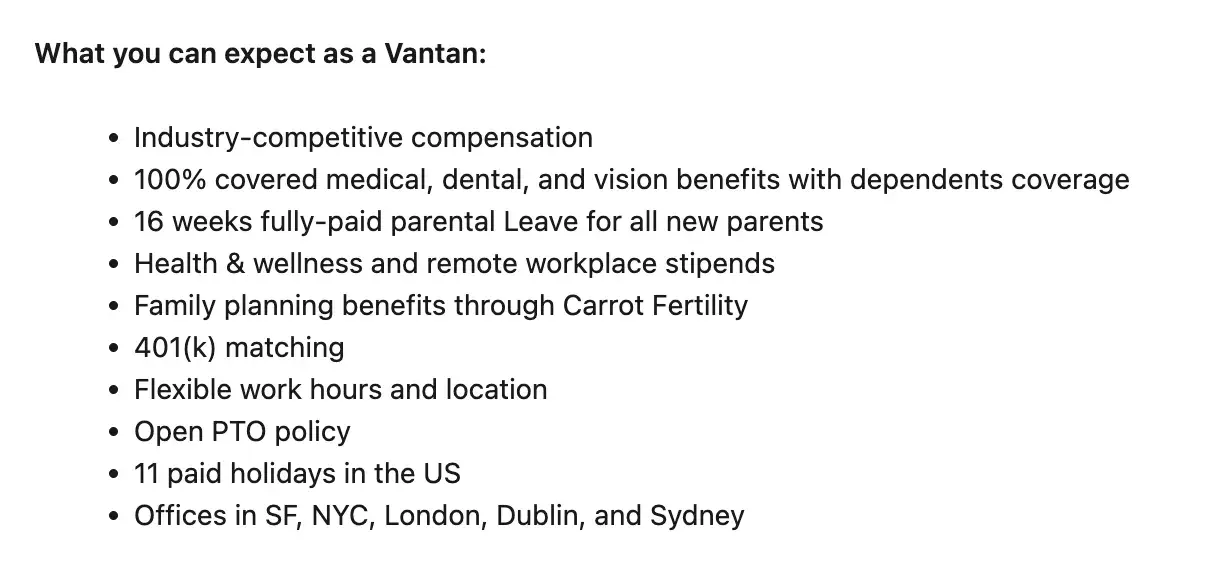
7. SEO Manager Job Description
A great SEO specialist is not only about keyword research. They must understand the complexity and integrity of all marketing activities and be able to integrate growth SEO practices to move the needle.
Look for their proven results and tech knowledge. For example, ask if they have developed end-to-end project plans (including kickoff, ticketing, workback scheduling, meetings, GTM plans, and regular reporting) to help the team deliver against a roadmap.
Job Description
We are hiring a talented SEO manager to join the marketing team. You will be responsible for identifying and executing opportunities to improve our company’s and our content’s search rank for key terms at the top, middle, and bottom (branded) of our marketing funnel.
Responsibilities
- Manage both on-page SEO and off-page SEO for the company.
- Perform technical audits + handle SEO backlogs for respective teams.
- Collaborate with content marketing and blog contributors to create high-quality content around important, relevant terms.
- Manage and improve organic search engine performance and goal-setting based on click-through rates, traffic, and conversions.
- Stay up-to-date with the latest trends and changes in SEO and major search engines.
Requirements
- BA/BS or equivalent working experience.
- Thorough knowledge of search ranking and optimization factors and key algorithm updates.
- Proficiency in web analytics software and keyword tools like Ahrefs, Stat, Screaming Frog, Netpeak Spider, Google Search Console, and Bing Webmaster Tools.
- Experience with data-driven SEO analysis and optimization.
- Excellent written and oral communication skills.
- Familiarity with HTML, CSS, JavaScript, and other front-end web programming languages.
What Hiring Managers Look for in an SEO Manager
Your future SEO manager should be obsessed with checking and tweaking your keyword strategy. Moreover, they should be able to develop a solid on-page SEO strategy from scratch if need be. They should also be able to execute strategies and tactics to improve your off-page SEO, such as building white-hat inbound links.
A valuable SEO pro will keep up-to-date with SEO blogs and best practices, through resources like Moz, Ahrefs, and Google Webmaster Tools. On top of that, modern SEOs must know how to work with AI tools and optimize for generative AI.
P.S. If you want to stay competitive in the AI search era, try out HubSpot’s AI SEO Masterclass.
8. Email Marketing Manager Job Description
When it comes to email marketing, there are a lot of moving parts. On top of making sure your emails are CAN-SPAM compliant, you also have to optimize for mobile devices, nail timing, and frequency, organize your segmentation and personalization strategy, and craft great email copy (just to name a few).
With so many email obstacles, you really need a professional on the job to make sure your emails are being delivered, opened, and clicked on. Or you need someone to figure out why they aren’t being delivered, opened, and clicked on. An all-star email marketer will get jazzed up about optimizing and building a top-notch email marketing program.
Job Description
Do you have a knack for getting the right emails into the right inboxes at the right times? Do you live to see those open and click-through rates climb higher and higher? We‘re seeking an expert email marketer to join our team. You’ll be expected to develop and track email campaigns to ultimately increase our business’s email marketing success.
Responsibilities
- Grow our email list organically, not through bought or rented lists.
- Manage various email campaigns, including the template designs, calls-to-action, and content used in our email sends.
- Segment lists based on behaviors like past email engagement and website interactions (content downloads, site page visits, etc.).
- Measure results and optimize the lead nurturing workflows for these segments to convert leads into customers.
- Work to minimize list decay and unsubscribes while increasing the productivity of our email sends.
- Develop documentation and road maps for processes, A/B tests, and promotions that succeed through email.
Requirements
- BA/BS or equivalent working experience.
- Past experience with email marketing, lead nurturing, marketing automation, and web analytics.
- Excellent understanding of email marketing concepts and metrics such as Sender Score, deliverability, and sender reputation.
- Proficiency in email marketing and marketing automation technology.
- Highly analytical and able to derive meaning from data through A/B testing and email optimization.
- Excellent writer and communicator (in both written and verbal form).
What Hiring Managers Look for in an Email Marketing Manager
An email marketing manager should have a unique set of skills. They must be able to craft and edit enticing content while also understanding the data and analytics behind email performance. The ideal candidate will be constantly looking for ways to experiment with new email marketing strategies to find what works best for their audience.
Choose a winning email marketing tool suite, HubSpot Marketing Hub. Skyrocket your email marketing performance and drive revenue fast.
9. Product Marketing Manager Job Description
Whether you manufacture lawn mowers, sell software, or offer bowling lessons, your customers are customers because your product or service makes a difference in their lives. That’s pretty special. Product marketers play a crucial role in positioning products/services the right way to the right people because they have a deep understanding of your target customers and how your products and services fulfill their needs.
Job Description
As a product marketing manager, you will be a leader on the team responsible for telling the world (and the company) the story of our product. You will be expected to be our chief advocate for a specific feature set and its benefits. Additionally, you will be charged with crafting the strategy around the messaging and marketing for new launches.
Responsibilities
- Together with the product team, educate both internal and external stakeholders about our product features and their benefits.
- Create product content (e.g., sales enablement documentation, case studies, product videos, website copy, blog posts, Quora/forum responses) to articulate the benefits of our products to the world.
- Assist members of our sales team on calls with prospects when appropriate to provide deeper dives into the product.
- Speak and present both internally and externally to promote the story of our product.
- Measure and optimize the buyer journey as it relates to product feature adoption and usage.
Requirements
- BA/BS degree or equivalent working experience.
- Past experience in digital marketing, product marketing, and/or product management.
- Excellent written and verbal communication skills — there is a heavy amount of writing and presenting/selling ideas in this role.
- Proficiency in content management systems. You will be expected to build product pages, optimize the conversion paths on those pages, and use dynamic calls-to-action to create and test buyer stage-specific calls-to-action.
- Prefer working in a collaborative, cross-team capacity. This role requires you to work across functions and departments to bring the product to life. You are at the center of our entire organization, constantly interacting with teammates and prospects.
What Hiring Managers Look for in a Product Marketing Manager
Since product marketing managers work with cross-functional stakeholders, they must be collaborative. Candidates seeking a product marketing manager role should be prepared to share examples of times they have successfully worked on project teams across an organization.
Real-World Example
At HubSpot, we’re looking for candidates who excel in GTM execution and implement AI into their workflow for efficiency.
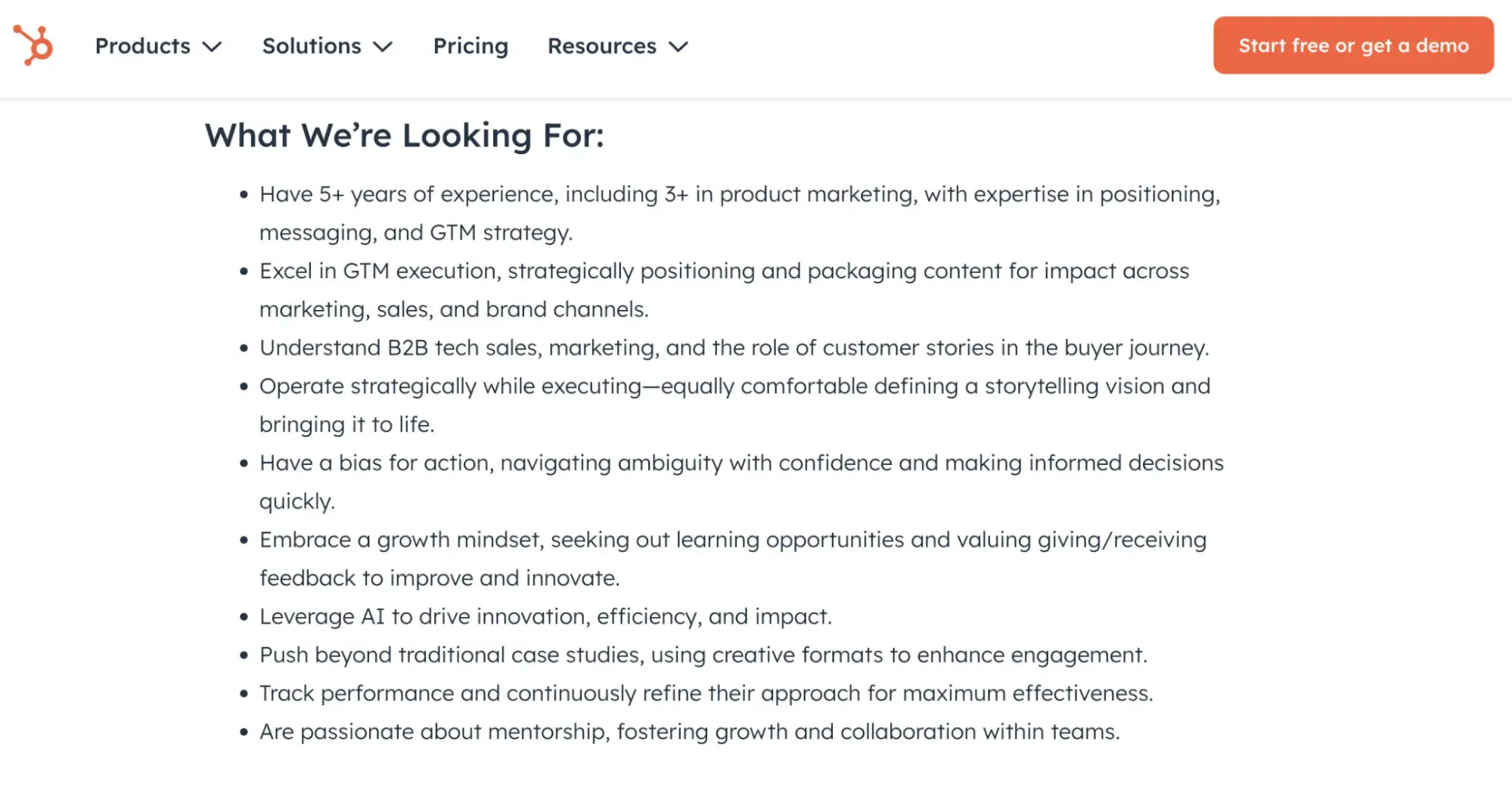
10. Paid Marketing Manager Job Description
While you may be building up your inbound marketing team, paid marketing strategies, in moderation, can help you grow and scale your organic inbound marketing efforts. And a paid marketing professional is exactly what you need to cover all your bases, since paid marketing tactics like pay-per-click (PPC) advertising and retargeting can involve a lot of day-to-day maintenance.
Job Description
We are seeking a paid marketing manager to help acquire new leads and customers through online pay-per-click and cost-per-acquisition campaigns. You will be in charge of all external, online acquisition marketing, managing the strategy, execution, and optimization across channels.
Responsibilities
- Manage the strategy and setup of all paid campaigns.
- Measure and optimize our paid marketing using vendor-specific dashboards, Google Analytics, and marketing analytics reports.
- Research and test partnerships with new vendors to expand our reach and/or lower our cost-per-acquisition.
- Collaborate with marketing teammates to maintain a consistent brand voice and message across all paid programs.
- Craft landing pages and lead generation forms for our content to distribute through relevant paid programs.
- Stay up-to-date with digital marketing trends and potential new channels and strategies to keep us ahead, including updates to social media marketing, attribution, and programmatic media buying.
Requirements
- BA/BS or equivalent working experience.
- In-depth knowledge of the various paid marketing channels and technologies, including paid search (Google AdWords), retargeting, social network advertising (Facebook, X, LinkedIn, Pinterest, and more), and content distribution and placement networks like Outbrain and Taboola.
- Excellent communicator with the ability to sell and convince. You will manage all relationships with vendors and ensure we get the most efficient cost possible.
- Experience handling marketing budgets and forecasting/reporting results.
What Hiring Managers Look for in a Paid Marketing Manager
A thorough understanding of pay-per-click strategies and experience creating consistent brand messaging across multiple marketing channels.
11. AI Growth Marketing Manager Job Description
Even Meta is looking for AI-qualified marketing personnel. With the lightning speed of AI-powered tools developing, AI specialists will become a crucial part of every marketing team. To find the right tools, test them out, run experimental campaigns and A/B tests, and incorporate those into your current workflows.
With that, the candidate should demonstrate strong knowledge of the AI ecosystem, have built a few AI agents, and do simple coding (or make AI tools code instead).
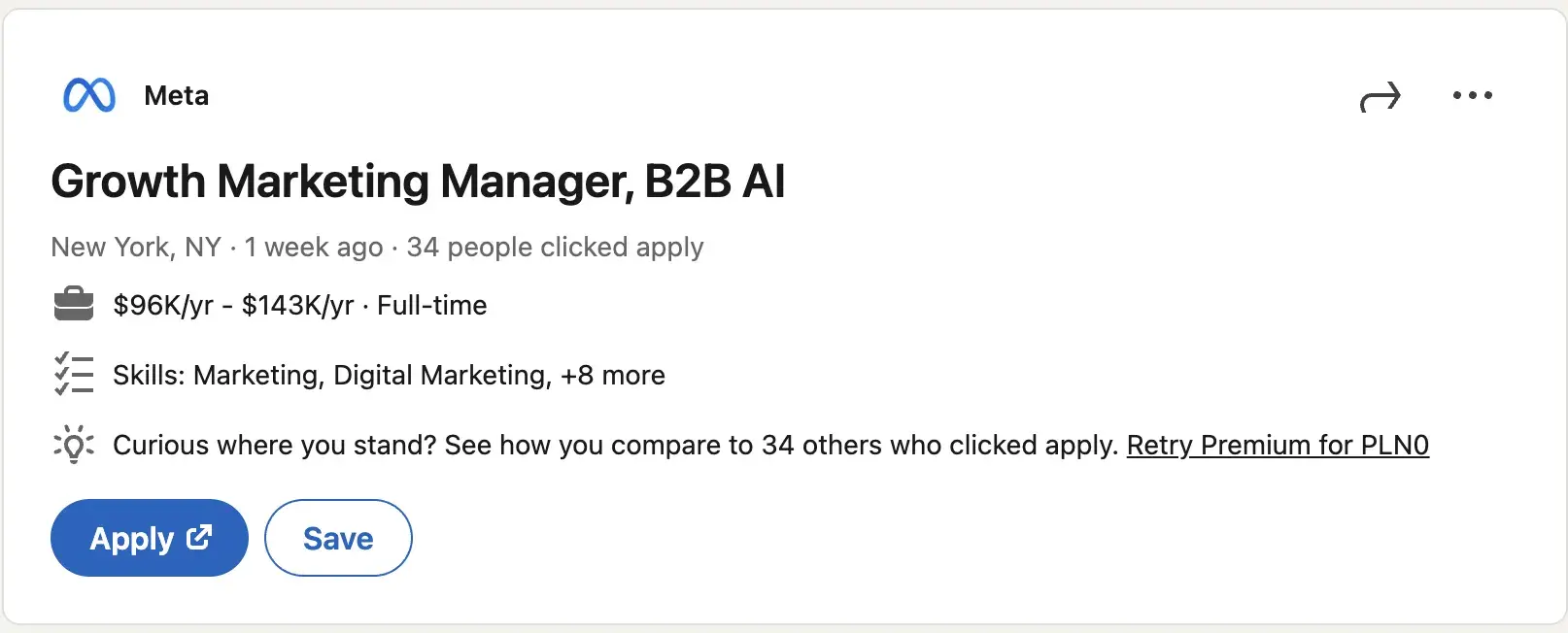
Job Description
Our company is growing rapidly, and we are looking for an AI-powered Growth Marketing Manager to take our lead generation to the next level. This individual will be in charge of creating the AI marketing strategy and implementing AI tools into GTM activities and beyond.
Responsibilities
- Collaborate with product marketing, sales, data science, and creative teams.
- Manage digital marketing channels (email, in-product, web, ads, etc) to execute high-performing GTM activations.
- Design and activate Agent-as-a-channel strategies, leveraging 1p and 3p agentic workflows.
- Regularly analyze campaign performance and identify areas for improvement.
- Drive qualified enterprise leads into the sales funnel.
- Create workflows of using AI across different marketing roles.
Requirements
- BA/BS degree or equivalent working experience; a Master’s degree is a plus, though not required.
- Expert-level industry knowledge and competitive analysis skills.
- Proven experience in digital marketing and/or demand generation.
- Experience with marketing automation platforms and tools.
- Experience with Agentic solutions and HubSpot AI solutions.
What Hiring Managers Look for in an AI Growth Marketer
When applying for the role, candidates have to bring strong experience in agentic solutions and a proven track record of GTM activities with their impact on revenue and ROI.
12. AI Writer Job Description
This role doesn’t mean you’re looking for a person whose goal is to churn out AI-generated posts. Rather, you’re looking for a highly qualified candidate in AI writing tools. You need that to speed up the content writing process, like blog ideation, brief development, copyediting, research, and voice-to-text.
So, the routine work of the writer is tied to AI writing tools, like this role of an AI-powered resume writer for Realign.
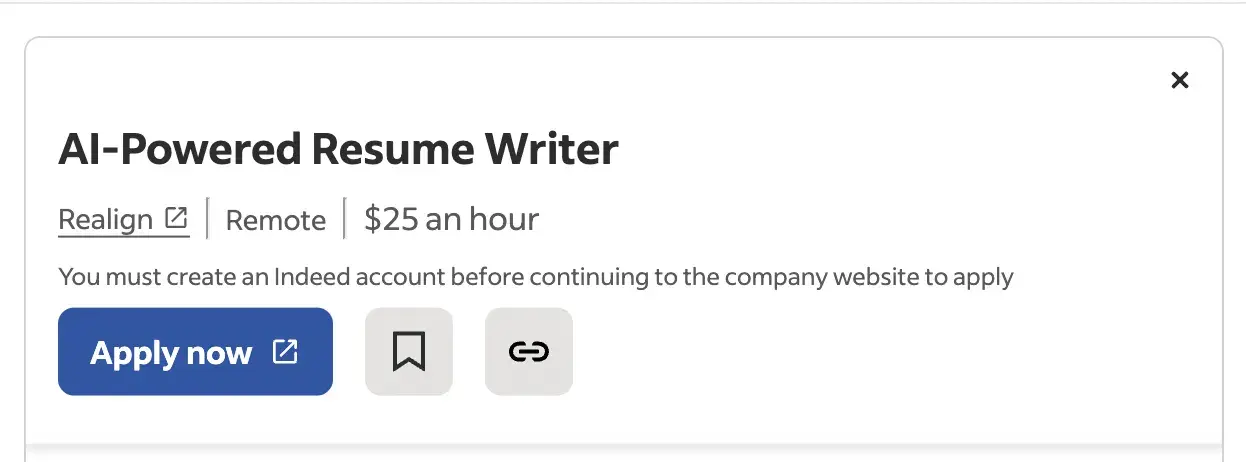
Job Description
We’re looking for an individual with a strong knowledge of AI writing tools to accelerate content development for the various needs of the marketing team.
Responsibilities
- Collaborate with marketing strategists to write AI-assisted content that supports campaigns across blog, email, social, and web.
- Prompt and fine-tune outputs from large language models to generate clear and brand-aligned copy.
- Edit and refine AI-generated drafts to ensure accuracy and consistency in tone and voice.
- Maintain and update prompt libraries and internal style guides for AI use.
- Work cross-functionally with designers, SEO specialists, and product marketers.
Requirements
- BA/BS degree is a plus, though not required.
- Expert-level AI industry knowledge.
- Proven experience in working with AI tools.
- Experience with ChatGPT, HubSpot Breeze, Jasper, Writesonic, Copy AI, Nyle AI, etc.
- Exceptional writing and editing skills, as well as the ability to adopt the style, tone, and voice of our business’s various types of content.
- 2-3 years of experience in content writing.
What Hiring Managers Look for in an AI Writer
First of all, you need a writer with a solid background and portfolio who is passionate about AI. They must also have hands-on experience with popular AI writing tools.
13. Public Relations/Media Relations Manager Job Description
That‘s right: One of the oldest marketing tactics, public relations, is still alive and kicking — even within inbound marketing. But to make sure you’re executing a modern public relations strategy that’s not stuck in the dark ages, you need a modern-day public relations manager.
Job Description
We are seeking a media relations manager to play an integral role in public/media relations, corporate communications, and content creation for our company.
Responsibilities
- Connect with influential media outlets and journalists to place stories about company news and other initiatives.
- Assist with event planning, including working with vendors, event coordinators, and design teams for on-site collateral.
- Create content regularly to grow the company’s footprint (press releases, corporate announcements, and creative content).
- Collaborate with prominent members of the company, including executives, to craft and pitch press releases and thought leadership columns.
- Establish a sustainable, strategic approach to PR based on adding value to media outlets and event managers, not just asking for it.
Requirements
- BA/BS degree or equivalent working experience.
- Past experience in public relations, corporate communications, content marketing, or relationship management.
- Skilled in creating, editing, and promoting written and visual content.
- The ability to work and thrive in a fast-paced, rapidly changing work environment.
- The ideal candidate will have experience pitching, crafting, and placing content externally through guest blogging or op-ed development and experience with event management and sponsorships.
What Hiring Managers Look for in a Public Relations/Media Relations Manager
To be considered for a public or media relations role, candidates must have expertise in developing strategic PR campaigns. Having a strong network of media connections is also a plus.
14. Marketing Operations Manager Job Description
You know how every group of friends has that one person who serves as the glue that holds everyone together? Every marketing team needs glue, too. Reflective, analytical, strong, strategic Gorilla Glue.
Marketing operations professionals are charged with monitoring, measuring, and analyzing the effectiveness of marketing initiatives as they relate to the overall company’s goals. Marketing operations staff work closely with sales teams and sometimes have a sales operations counterpart.
Together, they manage the relationship between marketing and sales to ensure that both sides are optimized to deliver (marketing‘s role) and work (sales’ role) the highest quality leads, something we at HubSpot have grown fond of calling “smarketing.” Marketing operations staff make predictions about the quality of the sales and marketing pipeline and spot efficiencies that will make the company work better as a whole.
Job Description
As a marketing operations manager, you will work to create scalable processes that ensure best practices in lead generation and database management. You will also conduct complex data analyses that will be used to inform strategic decisions by stakeholders from across the company. You will be working in a fast-paced environment, managing multiple projects at once.
Responsibilities
- Manage technical aspects of key marketing systems (marketing automation, CRM) used to generate, distribute, and report on leads.
- Establish and maintain scalable processes that ensure best practices in campaign and lead management.
- Create and maintain metrics reports on marketing and sales activities, effectiveness, and business impact.
- Analyze marketing and sales data to develop insights and make recommendations on areas for optimization.
- Monitor and maintain data quality within the marketing database.
- Evaluate new technologies and add-on applications to improve and optimize marketing team performance.
Requirements
- BA/BS or equivalent working experience.
- Strong analytical skills (including mastery of Microsoft Excel) and experience with reporting and data analysis.
- Proficiency in marketing automation systems (like HubSpot) and integrating those systems with other technologies.
- Ability to manage multiple projects at the same time in a fast-paced environment.
- Technically capable, excellent communicator, and a desire to improve processes.
What Hiring Managers Look for in a Marketing Operations Manager
Strong analytical skills and confidence working with large sets of data are a plus. When applying for a marketing operations role, be sure to call out experience creating and optimizing systems and processes for improved business outcomes.
15. Director of Marketing Job Description
Effective marketing teams need insightful leadership. As your marketing team grows and your business scales, consider hiring a director of marketing to oversee all marketing plans and promotional activities.
Marketing director candidates should have a combination of hands-on marketing and people management skills, as they will need to develop and motivate a team to create and implement successful campaigns.
Job Description
Our team is hiring a skilled marketing director to drive the creation of promotional strategies and manage the team that will execute. The director of marketing will be tasked with understanding our audience and offerings to deliver effective marketing solutions and ultimately grow our business. This individual will lead a team of talented marketers to raise brand awareness and generate quality leads.
Responsibilities
- Work with marketing teams and stakeholders to oversee the development of strategic marketing plans.
- Lead the execution of agreed-upon marketing plans and campaigns from concept to final analysis.
- Manage a team of senior marketing managers to ensure all campaign and employee development activities are on track.
- Conduct regular meetings with company leadership to report status on all marketing-related activities and how they perform in relation to overall company goals.
Requirements
- BA/BS degree or equivalent working experience. A Master’s degree is a plus, though not required.
- Strong background in senior marketing and campaign-driven roles.
- Refined communication, management, leadership, and analytical skills.
- Proficiency using marketing and content management systems.
- Experience working cross-functionally with content, event, and social media marketing teams.
- 6-8 years of experience in B2B/B2C marketing with a strong focus on lead generation, campaign strategy, and digital marketing.
What Hiring Managers Look for in a Director of Marketing
The ideal candidate for a marketing director role should have a variety of marketing roles under their belt, with experience leading capable marketing teams and delivering results-driven campaigns.
16. VP of Marketing Job Description
This is a senior executive role for an experienced marketing professional. The vice president of marketing should have an extensive background in marketing and demonstrated ability to set long-term strategic goals for their team.
Job Description
We are seeking a talented, experienced vice president of marketing to lead our marketing organization. In this role, you will oversee all marketing activities to ensure the growth and long-term success of the organization.
Responsibilities
- Manage the development of a strategic, multi-prong marketing plan to support company-wide initiatives.
- Work with fellow company leaders to determine long- and short-term goals and key metrics.
- Determine the headcount and staffing needs of the marketing team.
- Oversee all marketing projects and activities to ensure they stay on track and on budget.
- Create and maintain the company’s marketing budget, allocating resources to each project and department as appropriate.
Requirements
- BA/BS degree or equivalent working experience. A Master’s degree is a plus, though not required.
- Prior experience as a VP of marketing or a senior executive role.
- Effective leadership, communication, analytical, and decision-making skills.
- Hands-on experience creating, implementing, and analyzing marketing campaigns.
What Hiring Managers Look for in a VP of Marketing
Those who are successful in a VP of marketing role are typically career marketers who have a variety of experience in the field and who have spent time driving results in a marketing director role.
17. Chief Marketing Officer (CMO) Job Description
The chief marketing officer is the most senior role within a marketing organization. To be considered for a CMO role, the ideal candidate should have demonstrated experience leading marketing campaigns that directly support a company’s business objectives.
Job Description
Our company is growing rapidly, and we are looking for the right chief marketing officer (CMO) to join our dynamic leadership team. This individual will be in charge of creating the marketing strategy for the company and building a robust, capable team of marketing professionals.
Responsibilities
- Management of all marketing operations within the company.
- Design, plan, and implement all marketing campaigns across the company.
- Hire and develop a team of marketers to execute the marketing strategy.
- Work closely with other members of the executive team to ensure the marketing function is contributing to company goals.
- Represent the company during public-facing events and initiatives.
Requirements
- BA/BS degree or equivalent working experience. A Master’s degree is a plus, though not required.
- Expert-level industry knowledge and competitive analysis skills.
- In-depth understanding and working knowledge of key marketing systems and platforms.
- Demonstrated experience leading and implementing effective marketing campaigns.
What Hiring Managers Look for in a Chief Marketing Officer
When applying for the role of chief marketing officer, candidates should have proven experience driving revenue through marketing-related activities.
Marketing Job Description FAQs
Here are some commonly asked questions you may get from applicants during the hiring process. Try incorporating these explanations into your job descriptions to minimize confusion for those applying for roles.
What’s the difference between sales and marketing?
Sales and marketing are two different functions that work in tandem with one another. Put simply, marketing is responsible for raising awareness for a brand and generating viable leads who may be interested in their company’s products and services, and sales is responsible for converting the leads to paying customers.
Once marketing has generated leads, the leads are then connected with the sales team. The sales team then nurtures potential customers until they are ready to make a purchase.
What’s the difference between advertising and marketing?
Advertising is a facet of marketing and advertising roles often sit within marketing organizations. However, it is worth noting that there are differences between advertising and core marketing roles.
The primary goal of advertising is to increase brand awareness, promoting a company’s offerings through various channels for exposure. On the other hand, core marketing roles focus on the unique needs of the ideal customer for their product and carry out tactics to position their product as the solution to the customer’s problem.
What makes a great marketer?
Since marketing and marketing channels are constantly evolving, great marketers are those who love to learn and experiment. What worked for one campaign may not work for the next campaign, and great marketers are constantly looking for data and information to support the best possible outcomes for their efforts.
Who does a marketer report to?
Depending on the size of the organization, a marketing professional will often report to a marketing manager or marketing director.
Building Your Marketing Dream Team
If you’re looking to hire a stellar marketer on your team, having high-quality job descriptions is a non-negotiable part of the hiring process, and our templates are designed to streamline your efforts.
Ensure you list all crucial technical skills candidates have to possess to filter out the rest. But stay flexible with “nice-to-haves” not to scare off your perfect candidates.
Editor’s Note: This post was originally published in January 2014 and has been updated for accuracy and comprehensiveness.
![]()
Here are the most popular AI video tools that are actually worth your time
My son and I were recently watching some AI-generated videos when he suddenly stopped and asked, “Wait… none of these are real?” That pause perfectly sums up where we stand with AI video tools right now. We‘ve reached the point where even a casual viewer […]
MarketingMy son and I were recently watching some AI-generated videos when he suddenly stopped and asked, “Wait… none of these are real?” That pause perfectly sums up where we stand with AI video tools right now. We‘ve reached the point where even a casual viewer has to take a step back and consider if what they’re seeing is real or AI.
But, not all tools propel viewers past the uncanny valley. Having spent years in Silicon Valley watching AI startups rise and fall, I‘ve learned that the tech that looks impressive in demos doesn’t always translate to real-world utility.
For this post, I’m cutting through the noise and focusing on AI video tools that are popular and live up to the hype. I’ll dive into visual quality, surprising functionality, and the heated debates these tools sparked. So, here are the nine tools that rise above the rest.
The 9 Most Popular AI Video Tools Right Now — Ranked
1. Veo
Veo, Google’s AI video model, is the most impressive AI video I’ve seen so far in terms of pure output quality. The visuals are crisp, the motion is smooth, and it offers four video options per prompt. You just need to pick your favorite. I’ve found one of the four is good enough to use straight out of the gate almost every time.
The tech is miles ahead, even if the product still feels early. Currently, Veo lacks essential features, such as a comprehensive asset library and editing tools, and your creations are lost if you don’t download them. But, those are solvable problems.
My take: The big question is whether Google will actually turn Veo into something people use. They’ve launched amazing tech before that’s never reached widespread adoption. Beyond that, the latest version is priced at $250 per month, which can be a tough pill to swallow.
The model is absolutely S-tier, but without a solid product and rollout behind it, it could end up being one of those cool tools that most people never touch.
2. Hailuo AI
Hailuo might not have the same name recognition as Google or OpenAI, but it deserves a spot at the top. The results are consistent and surprisingly controllable. You can bring in images from tools like Midjourney or Flux, and Hailuo turns them into smooth, coherent motion.
When I sat down with Tim Simmons from Theoretically Media, he raved about how his audience was getting great results with Hailuo. Even without using a prompt, it understands what you’re trying to achieve. That kind of intuition in a model is rare.
My take: The control and prompt adherence here are next level. If you’re creating short films or AI-native content, this is a top contender. Tim put it best when he said his entire audience would “come after him with pitchforks” if he didn’t rank this tool at the top of his list. After testing it, I understand why.
3. Runway
Runway is the OG. It’s been around longer than most and still ships new features constantly. Gen-3 is fast, and the editing tools — Act-One, rotoscope, motion controls, subtitle generation — make it more than just a video generator. It’s a full creative suite.
That said, the visuals don’t always impress. I would say the quality is closer to B-tier, but the ecosystem makes up for it. I find the green screen and expand tools particularly useful. These are great for workflows where precision and flexibility are required.
My take: The visuals aren’t always top-tier, but Runway’s tools and speed make it the most complete creative suite I’ve tested.
4. Kling
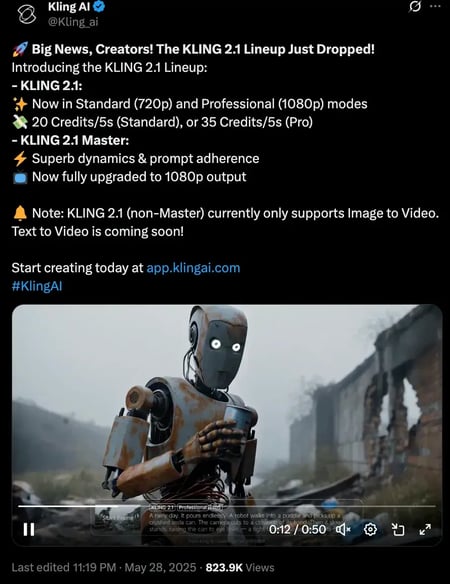
Kling clips nail physics, motion, and photorealism, making video that feels real. The tool is especially impressive when you’re working with dynamic shots like sweeping pans or zooms, where the sense of depth and movement really comes through.
Kling doesn’t lock you into native image tools. You can bring in assets from other platforms and then use Kling’s motion brushing and generation features to bring them to life. Kling 2.1 was also one of the most talked-about upgrades in late 2024. Pro mode bumped video resolution to 1080p, and prompt adherence improved dramatically.
My take: Kling offers greater control and flexibility than competitors. However, until the output is more consistently high-quality across a broader range of prompts, this is high on my favorites list but not at the top.
5. LTX Studio
Tim fought hard for LTX to be in S-tier — not because it’s the best right now, but because it’s the only open-source tool on this list. That makes it uniquely poised for rapid improvement, thanks to contributions from the global dev community.
He also called out how fast it is and compared it to Leonardo.Ai’s Flow State mode, where you can interactively steer outputs. But even Tim admitted the generative quality doesn’t yet compare to tools like Veo or Hailuo. Matt Wolfe, my co-host on The Next Wave, agreed. LTX is promising but not quite there.
My take: LTX is a strong AI video contender with tons of potential, especially for developers and tinkerers. If you’re excited about open-source AI tools, check it out.
6. Sora
This one sparked a lot of discussion. Initially, I had access to Sora Turbo. The Turbo model generated 20-second clips using frame interpolation, which sped up the motion but made it feel slightly off at times.
When my co-host Matt tested Sora Turbo, he found that outputs weren’t especially impressive. In his side-by-side tests with Veo, results came out in Veo’s favor. Beyond that, several key capabilities, like generating people, were locked behind the $200 per month plan. That makes the tool feel somewhat limited unless you are paying for the top tier.
That said, there are some genuinely impressive features, like Remix, Blend, and the ability to cut between clips. While the outputs felt underwhelming, those tools showed real potential and hinted at where Sora could go next.
My take: The visuals weren’t the main event here. It’s the tooling that stood out. Remix and Blend, in particular, seem to be ahead of the curve. If OpenAI leans into those strengths, Sora could become a serious contender.
7. Luma
Luma’s Dream Machine impressed us with its unique features and solid output. One standout? The ability to input a start and end frame and have the tool animate between them. Tim used it to prototype a Game of Thrones–style intro, complete with sweeping drone-style flythroughs. During a conversation on The Next Wave, Matt noted that starting with an image instead of just a prompt tends to get better results.
Luma’s image generation improvements and its more interactive UI are also worth noting. These changes allow you to “chat” with your image in a way reminiscent of early DALL·E 3 hype.
My take: Matt’s demo, featuring image-to-video transitions and flythroughs, was impressive. Luma is a tool that I’ll be watching closely.
8. Pika
Pika has carved out a unique niche with its special effects features, such as the ability to make things explode, get crushed by hydraulic presses, or transform objects into cake. While they were the first to nail cartoon faces really well visually, most of the other models that have come out since are more impressive overall.
But Pika‘s strength isn’t in competing on pure visual quality. Tim pointed out they’re doubling down on these playful, social-first tools rather than trying to match the cinematic output of Veo or Runway.
My take: I see Pika becoming a viral app. It’s useful for memes and quick social content, which gives it real value in its specific lane. Maybe it’s not what Hollywood uses, but for teens looking to create fun, viral transformations, it could be huge.
9. Invideo AI
Invideo AI isn’t really trying to compete with cinematic AI models like Veo or Hailuo. Its strength is in speed and utility. You give it a prompt, and it assembles a slick, ad-style video using stock footage and templates in minutes.
If you’re making explainer content or quick social clips, InVideo is useful. You’re not relying on full-on generation Instead, you’re combining assets to get something done fast.
My take: Invideo feels more like Canva for video than an AI playground. But for marketers who want to move quickly and stay on brand, that’s a win.
What’s Next for AI Video
After testing these tools side by side, one thing‘s clear: We’re in the early days of a massive shift. No single platform is dominating yet, which reminds me of the early social media wars or the browser battles of the 2000s.
Tools like Veo and Hailuo are setting the bar for raw quality. Runway and LTX are winning in terms of features and community. Pika and Invideo are smart to carve out specific niches rather than try to be everything to everyone.
Here’s what happens next: The quality gap will narrow fast, but the real winners will be the platforms that nail the user experience and find their specific audience. Expect better editing tools, smoother workflows, and entirely new use cases we haven’t imagined yet.
The tools are getting good enough that the story you tell matters more than the pixels you generate. And honestly? That’s where things get really interesting.
To see other top video contenders, check out the full episode of The Next Wave below. And if you’re looking to stay on-top of the AI space, check out Lore — a weekly newsletter that helps 40,000+ operators from OpenAI, NVIDIA, and Amazon master AI in five minutes or less.”
![]()
8 steps to build your account-based marketing strategy [+ recommended tools]
In the world of account-based marketing, you start the sales process by selling directly to your best-fit, highest-value accounts. That means wasted time trying to market to unqualified leads who aren’t the right fit for your business. You can move straight into the phases of […]
MarketingIn the world of account-based marketing, you start the sales process by selling directly to your best-fit, highest-value accounts.
That means wasted time trying to market to unqualified leads who aren’t the right fit for your business. You can move straight into the phases of engaging and delighting your target accounts. Talk about efficiency, right?
Account-based marketing allows you to weed out less valuable companies early on and makes sure that Marketing and Sales are in complete alignment. In return, your team can leap into the critical processes of engaging and delighting target accounts much faster.
I recently sat down with Tim Davidson and Dylan Wingrove, account-based marketers, to discuss everything relating to this strategy. Here’s everything you need to know about account-based marketing.
Table of Contents
- What is account-based marketing?
- Account-Based Marketing and Inbound Marketing
- Benefits of Account-Based Marketing
- Account-Based Marketing Framework
- Account-Based Marketing Strategy
- Account-Based Marketing Tactics
- Account-Based Marketing Tools
- Account-Based Marketing Examples
- B2B Account-Based Marketing
- LinkedIn Account-Based Marketing
When I asked Dylan Wingrove, Associate Director of Demand Generation at Pacvue, for his personal definition, he told me, “[ABM] is going after a set of defined strategic accounts that are large revenue opportunities for the business.”
In other words, ABM helps your business work and communicate with high-value accounts as if they’re individual markets.
Like traditional marketing, you’ll spend quite a bit of time personalizing your messaging to be as specific as possible. This means really leaning into individual pain points to directly speak to your leads’ needs.
For this post, I asked Davidson and Wingrove about the benefits of account-based marketing and how to create an ABM strategy. But first, I think it’s important that we spend a minute reviewing its relationship with another important strategy: inbound marketing.
Account-Based Marketing and Inbound Marketing
Batman and Robin. LeBron and D-Wade. Peanut butter and jelly. Arguably, some of the strongest partnerships ever to exist. These dynamic duos are forces to be reckoned with.
Similarly, when paired, account-based marketing and inbound marketing have the power to make waves (the good ones) for your business.
You might be wondering, “How exactly does this partnership work?”
Well, we just reviewed the definition of account-based marketing — as you learned, ABM is a highly targeted strategy.
Meanwhile, inbound marketing is more foundational — this methodology and growth strategy allows you to attract customers through the creation of valuable content, SEO, and a delightful customer experience.
Rather than interrupting your target audience and customers (as you would with outbound marketing), inbound marketing allows you to give your audience the information they want when they want it.
Inbound lays the foundation for a strong ABM strategy by allowing for highly targeted and efficient resource allocation of high-value accounts.
Do you need both inbound marketing and account-based marketing?
You’re probably wondering, “Do I need both inbound marketing and outbound marketing?”
I hear you. So, I asked Wingrove what he thought. He told me he would not recommend launching an ABM strategy as a standalone tactic. Instead, it works better in partnership with other marketing strategies.
Here are a few reasons to employ both ABM and inbound marketing strategies at your company:
- Inbound marketing helps you attract target accounts, and then ABM accelerates the flywheel so you can win and delight those accounts with a remarkable customer experience.
- Inbound marketing lays the foundation for a strong ABM strategy; ABM builds off of inbound by allowing for targeted and efficient resource allocation of high-value accounts.
- With this combined approach, you attract a broader group of prospects than you would while using just one method.
- Your content has a two-for-one value — you can create and use content that serves both an ABM and inbound strategy (such as adding a personalized case study for a target account that you also share on your website).
- Software — such as HubSpot’s account-based marketing tool — exists to make it easy to implement ABM and inbound strategies in a complementary way.
TL;DR: Combine ABM and inbound marketing to grow better.
As I learned by chatting with Davidson and Wingrove, there are many benefits associated with account-based marketing. I’ve made a list of the most important benefits based on what the experts told me.
1. Keeps marketing and sales aligned.
Davidson and Wingrove both made it very clear that account-based marketing aligns the sales and marketing team in a way that might not be possible otherwise.
Wingrove said it reduces the friction between teams, too. He said, “There‘s no fighting over inbound versus outbound. And everyone’s kind of working off of the same set of strategic accounts that we’re going after.”
I think we can all agree that cross-team collaboration and improved communication across any organization are beneficial to growth.
In account-based marketing, this transparency and alignment will confirm that your marketing and sales teams:
- Are focused on the same goals.
- Stick to the mutually agreed-upon budget.
- Understand the specific roles of each internal stakeholder.
This alignment helps make sure all communications, interactions, and content are consistent for the accounts you work with.
Meaning, no matter how long an account works with your company, your team members can pick up where others left off at any point without question — this creates a seamless and delightful customer experience.
🧡 The easiest way to support internal account-based marketing alignment is with the help of software, like HubSpot, which makes connecting your marketing and sales teams exceptionally easy.
2. Maximizes your business’s relevance among high-value accounts.
Account-based marketing requires you to personalize everything for each account you invest your resources in. You’ll create magic with:
- Personalized content
- Product information
- Clear communications
- Highly tailored campaigns
For Davidson, that means using all the tools available from personalized ads to dynamic landing pages. Through this personalization and customization, your relevance among these accounts is maximized.
That’s because your content and interactions are tailored in a way that shows them how your specific products, services, and other offerings are what they need to solve their challenges.
ABM allows you to angle your business in a way that makes it the most relevant and ideal choice for your target accounts. Or, as Wingrove told me, it keeps your business top-of-mind. So, when a prospect looks for a solution, you’re there.
3. Delivers consistent customer experiences.
For your ABM strategy to be remarkable, I cannot stress this enough: you must create a long-term sense of delight among your accounts. Each account should feel as though they’re your business’s market of one.
Tackle this by offering consistent and unique customer experiences.
Wingrove told me this approach has been integral to closing sales. He said custom offers give prospects a reason to take meetings or engage in conversation. But it takes an all-hands-on-deck approach. “Sales and marketing need to work really closely together to figure out what is important to that customer to offer them,” he said.
You’ll need to confirm that all team members know where an account is in the buyer’s journey — then, deliver personalized and prompt communication, campaigns, product information, and pricing details.
4. Measure your return on investment.
With account-based marketing, you can easily measure return on investment (ROI) for each account you invest your resources and time in.
This is beneficial because you can confirm whether certain accounts you invested in were ideal for your business.
Then, you can nurture and delight those accounts long-term to keep them, as well as recognize and target similar accounts in the future. If your ROI proves the ABM tactics you used worked, use that data to propel your strategy forward.
5. Streamlines the sales cycle.
Depending on your business, industry, and resources, the sales cycle typically looks something like this:
1) Prospect → 2) Connect → 3) Research → 4) Present → 5) Close → 6) Delight
With account-based marketing, this cycle is streamlined — by focusing your efforts on specific high-value target accounts, you save time and resources.
This means you’ll have more time to focus on the stages of the cycle that positively impact your bottom line:
1) Identify Target Accounts → 2) Present to Target Accounts → 3) Close Target Accounts → 4) Delight Accounts
ABM streamlines your sales cycle by helping you stay efficient.
Rather than experimenting with different tactics to prospect and qualify a large pool of leads, ABM confirms the accounts you target are the right ones for your business and vice versa.
The sales cycle is also streamlined by your marketing and sales alignment, as well as the consistent and personalized customer experiences you offer. And, according to Wingrove, it can also shorten your sales cycle.
I don’t know about you, but that a shorter cycle is a definite win.
6. Expands your business through account relationships.
I think the phrase “quality over quantity” safely applies to account-based marketing. The process requires you to invest significant time and resources in engaging and delighting a group of carefully chosen, high-value accounts.
This is instead of trying to close deals with less-qualified leads who may not be the best fit for your company in the long run.
By taking the time to build these trusting relationships with accounts, you’ll expand business by keeping those valuable customers longer.
Considering it costs more to obtain customers than to retain them, this will positively impact your bottom line.
Additionally, as a result of personalized, thoughtful, and consistent customer experiences, accounts will become loyal to your business over time — and loyal customers become your best marketers, promoters, and brand advocates.
In other words, your accounts will help you expand your business among their networks (for example, partners or customers) through:
- Referrals
- Word-of-mouth marketing
- Testimonials
To get started, let’s cover the framework for account-based marketing.
Account-Based Marketing Framework
ABM works differently from a traditional sales funnel. Though ABM can be put in place across different industries and types of businesses, a general framework needs to be followed to guarantee its effectiveness.
Here are the key parts of an account-based marketing framework.
Marketing-Sales Alignment
Aligning your sales and marketing team is critical for the success of your ABM strategies. When I talked with Davidson and Wingrove, both stressed that in a comprehensive approach to ABM, marketing and sales must be on the same page.
Davidson said, “Ideally, everything you’re doing from the sales and marketing sides, you’re doing together.”
When trying ABM, sales and marketing organizations will need to agree on:
- Resource allocation for each target account
- Roles and responsibilities to create a seamless transition for the customer between marketing and sales activities
- How to measure the success of ABM efforts
Account Qualification
How does your company decide what a high-value account is? This is something you’ll need to sit down and discuss during a planning meeting with both sales and marketing.
Creating an ideal customer profile for the accounts your company wants to target is key to answering this question and creating an ABM framework.
As you figure out what qualifies a potential account, consider these factors:
- Financials — With your company’s sales goals in mind, consider how much revenue can be generated from an account.
- Scalability — Based on what you know about the potential account’s business performance, is there potential to grow the account in the future? Consider extra offerings your company could provide to retain and grow the account.
- Competitive Landscape — Who are your competitors selling to? Understanding who is in the market for products and offerings like yours can help you figure out future account opportunities.
Go-to-Market Approach
Once marketing and sales are aligned on approach and which accounts to target, it’s time to map out a go-to-market plan.
Understand exactly how a new customer would move through the sales process using an ABM approach.
While preparing to go to market, you may find areas of friction that need to be addressed or areas of poor communication that can be strengthened.
Because a personalized experience is so important in account-based marketing, your team will want to be on the lookout for extra ways to add value and deliver a premium experience to these accounts.
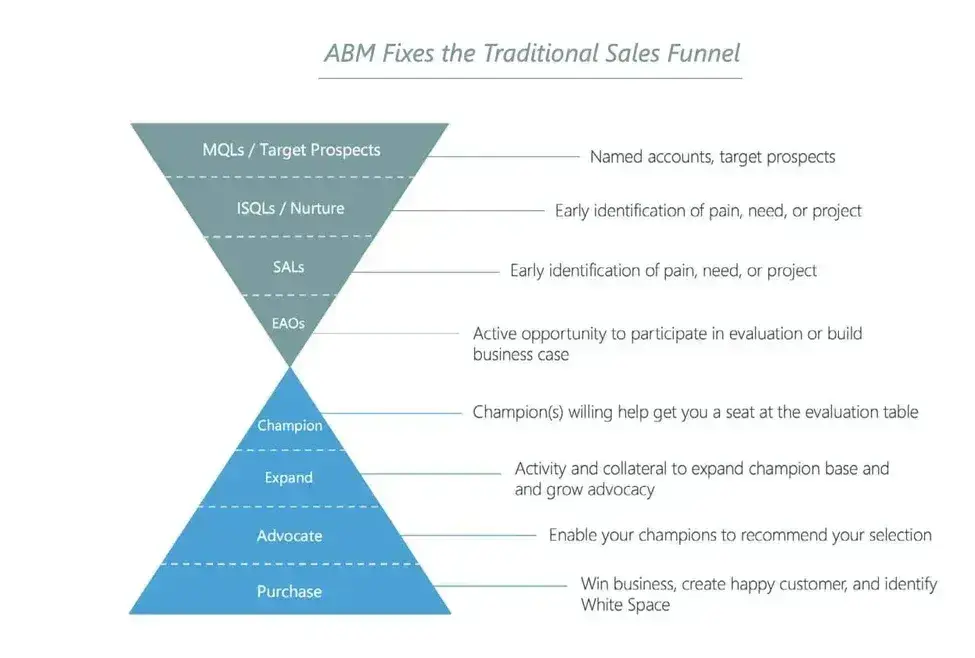
Account-Based Marketing Strategy
You’ll need a sound strategy to get the most out of an account-based marketing approach. I think it’s important to mention that you don’t need to go full force with your ABM strategy from the start.
Wingrove suggested that a small, slower pace might be best for getting your ABM program off the ground. Consider following these steps to create an effective account-based marketing strategy.
1. Use a strategic account planning template.
To unify your account-based marketing team, use a strategic account planning template. I like this free template because it will help you outline your initiatives for each unique account, such as the following sections:
- Business overview.
- Key business initiatives.
- Customer relationship landscape.
- Customer products and revenue.
- Account competitor analysis.
- Buying process and selling points.
- Relationship goals and strategy.
- Sales opportunities, targets, and risks.
- Action plan.
Download the Free Account-Based Marketing Plan Template
2. Secure organizational ABM alignment.
Executive Alignment
One of the most important account-based marketing tactics is pretty straightforward — getting alignment.
Instead, it means getting all internal stakeholders on board with your account-based marketing strategy.
Wingrove and Davidson both mentioned that if your stakeholders, like your executives, are accustomed to seeing large numbers of leads on various reports, a more tailored list might be shocking.
Davidson explains it like this: “Often what happens is if you go the ABM route and you‘re doing maybe the demand generation route before that, you’re getting in front of fewer accounts, less number of people. So, your leads and your volume are going to go down. If you don‘t have those conversations with your executive team, your numbers will look bad to start. And that’s going to be a bad conversation.”
Having these conversations beforehand will make it easier for your business to create consistent experiences for accounts. It will also ensure your strategy is as efficient and streamlined as possible.
And it removes any potential disappointments and surprises.
Marketing and Sales Alignment
I know I’ve mentioned this many times already, but marketing-sales alignment is crucial. To create a custom buying experience, a customer must have a seamless transition from becoming a lead through the final sale.
For example, your VPs of Marketing and Sales should secure organizational alignment. This will help spread awareness for:
- Marketing and sales team members who are directly involved in the strategy.
- Account-buying committee members and any other account stakeholders.
- Your business’s point-of-difference for each target account.
- ABM budget and resources.
- ABM goals and KPIs.
Both teams must commit to clear communication and find a middle ground. This will help you make sure that the marketing team is acquiring qualified leads for the sales team.
Besides marketing and sales, don’t forget to choose other internal key players — such as customer success reps — who should be aware of and aligned with your ABM strategy.
3. Build your ABM team.
If you’re just starting with ABM, Wingrove and Davidson both told me the best way to do it is to create a small task force with one marketer and one salesperson. They can work together to find potential issues and generate ideas before focusing on executing your ABM strategy.
As your efforts scale, this marketer could support more salespeople. On average, one marketer can typically stay aligned with up to 10 salespeople, and each salesperson can manage up to 10 accounts.
A minimum of one marketer and one sales rep should be completely dedicated to the accounts you work with at all times.
These people will create and publish content for accounts. They’ll also work to manage and close business deals with each account’s buying committee.
4. Research and pick your ideal set of target accounts.
Once you‘ve selected your team and aligned on the approach, it’s time for your company to target the correct accounts and personas.
I asked Davidson how he does this. He said he starts by looking at the data in his CRM or another data provider. Then, you’ll better understand which accounts to target and can create customer personas…
When creating customer personas for an account-based marketing approach, marketers should consider:
- The mission, vision, and business objectives of their ideal customer.
- If any high-value accounts are already engaging with your company’s Inbound approach.
- The current stage of business maturity, company size, and growth trajectory.
- Revenue model and spending patterns.
- The tools and platforms that their ideal customer is using.
Next, review your findings and pick your ideal set of high-value target accounts to invest your time and resources in.
There are countless ways to choose key accounts. Here are some recommendations on how to get started:
- Set search alerts for your ideal customer profile on LinkedIn.
- Create a workflow that filters incoming qualified leads based on specific criteria (such as company size or industry) and tags them as an ideal customer type in your CRM .
- Ask, “If we could replicate one deal from last year, what would it be?” Then, use the characteristics of that deal (such as industry, company size, value) to help you find other good-fit customers.
- Pick target accounts based on a particular industry or geographical location.
- Review major companies and leads who are using and engaging with your inbound content but don’t have a deal attached (yet!).
- Find the lighthouse accounts you could use for reference.
- In this stage of the process, what’s most important is that marketing and sales agree on which accounts to target.
According to HubSpot Academy professor Kyle Jepson, “If your marketer is targeting one list of companies, and your salespeople are working a different list, you’re going to end up with an account-based mess.”
Check out this post to learn more about choosing the right AMB accounts.
5. Finalize account plans.
After deciding which accounts to target, it’s time to build account plans. In this step, your marketing and sales teams will work together to map out:
- Potential leads they’ll need to attract to reach their target accounts
- What content do they need to produce to engage with this audience
Account-based marketing is a team effort.
Each account plan should be able to answer two important questions:
- Who makes the buying decision for this sale?
- What content do you need for each member of this buying committee?
So, make sure marketing and sales ask the following questions while they work on account plans:
- Who will we need to know at each account? Who are the buying committee members, decision-makers, influencers, blockers, end-users, and account stakeholders?
- What content will we need to attract and engage account-buying committee members (and any other stakeholders)?
- Which channels will we use to share content with the right people at each account?
- How will we (marketers and sales reps) offer the right type of support throughout each stage of the strategy and sales process?
- How will sales help at the outset and how will marketing support in the later stages?
Note: Store your account plans as pinned notes in your HubSpot CRM, Google Docs, Asana Boards, pinned messages in Slack, and more to allow for easy access and collaboration.
Here are a few other tips and best practices you can use to make your ABM plans successful:
- Connect your different sales and marketing applications to make sure all your ABM apps are aligned.
- Make sure marketing and sales align on your product or service’s value proposition for every account.
- Use a marketing plan template to make sure your plan includes the details your plan needs to be effective.
- Customize each plan to the needs of that particular account.
- Create personalized content — or update existing content — so it’s tailored to each unique account.
- Customize your allocated resources and budget for each account.
6. Attract contacts associated with high-quality target accounts.
Next, you’ll want to attract the buying committee members and stakeholders of your target accounts.
You can attract contacts from your high-quality target accounts in a few ways. I feel it’s important to mention two key tactics now (but don’t worry, I’ll cover a few more later): leaning into your employees and using your resources.
Employee Networks
Depending on how long you’ve been in business and any previous ABM work you’ve done, you may or may not already have contacts for specific accounts.
If you don’t have contact, look to your team. Wingrove mentioned that your team members likely have an in, whether from professional connections on LinkedIn or former colleagues at new companies.
Wingrove said that when his company can increase the number of contacts, they close 20% more sales. So, don’t sleep on your team members’ networks!
Inbound Marketing and Personalization
Ideally, using the Inbound methodology will help you attract contacts associated with your target accounts by ensuring your company is visible and represented in these spaces.
The key to successfully attracting high-quality accounts is to personalize content to those accounts. This will help you elevate brand awareness and maximize relevance among audience members.
Trying to get your company‘s visibility through all available avenues can be tempting. But you’ll get the best results through the most relevant channels to your target accounts and contacts.
Here are some GDPR-compliant recommendations for attracting high-quality accounts:
- Ask current contacts, accounts, and customers for referrals.
- Engage accounts on social media. Figure out which platforms they’re on, join the groups they’re in, contribute to conversations they’re a part of, and share helpful and relevant content you’ve created.
- Send direct messages through social media, email, or post.
- LinkedIn is a popular platform for businesses. Communicate through LinkedIn InMail outreach without ever leaving HubSpot with the LinkedIn integration.
- Produce a podcast or video series and invite a leader from the account to be a special guest. (Davidson mentioned being a guest or a host is a great way to attract target accounts!)
- Sponsor a booth at a target account’s conference or event.
- Share industry content, such as blog articles or newsletters, across channels that are relevant to each account. Use your website, social media, and magazines — and make sure that your messaging is where your target customers are.
- Invite contacts to (physical or digital) events and ask attendees to invite their colleagues.
- Build custom landing pages tailored to the needs, questions, and concerns of accounts.
- Offer gifts for engagement and interaction (such as prizes, swag, and discount codes).
- Create targeted ad campaigns to target different factors such as location, skill, and job title.
7. Forge strong relationships with the account’s buying committee.
Once you’ve attracted high-value accounts, it’s time to forge strong relationships with their buying committees.
This is something your team will likely work on over an extended period of time. Keep in mind that it often takes months and even years to develop these bonds. Even though it takes time, it’s effective.
Use executive connections.
Wingrove told me, “We’ve found it effective to get our offer in front of the right people by using our exec team and exec sponsors on these large accounts.” To do that, he, again, turns to his team and asks, “Does someone have a connection or know someone through a board seat or something?”
Forging strong relationships with the account’s buying committee requires you to be a little creative. Your primary goal is to delight your accounts, and you can never stop the process of delight.
Get creative to forge strong relationships.
Here are some thoughts on how you can forge strong, long-lasting relationships with an account’s buying committee.
- Offer education around the value of your business and your product/ service.
- Create and share personalized content like case studies to show how you’ll exceed expectations and resolve challenges.
- Communicate one-on-one when possible to make buying committee members feel like they’re your only priority.
- Host events with and for account members (such as dinners, lunches, or social meetups) so they get to know your brand and team on a personal level.
- Stick to organized, well-timed meetings.
- Use email sequencing to enhance all communication, be professional, and stay consistent.
Use tools.
HubSpot’s ABM Software Target Accounts Home and Account Overview features will help you forge strong relationships.
Tools like Enlyft give you insight into details such as recent funding dates and the technologies prospects are using to help you better understand and solve the problems your prospects face.
Though this stage is typically led by sales, marketing should be ready to support. Be sure to develop valuable materials to reinforce messaging.
Learn how to showcase your company’s success using compelling case studies with a free case study creation kit.
8. Measure and analyze your ABM results (and iterate as needed).
Once you’ve put your account-based marketing strategy in place, it’s crucial to track the success of your tactics.
Here’s my best tip: Continuously review and analyze your ABM results to find any gaps or tactics that you want to update. This will allow you to make your strategy more effective for your business, marketing and sales teams, and accounts.
To measure the health of an ABM strategy, marketing and sales teams can use the following metrics:
- Find the buyers associated with target accounts and track interactions with these buyers.
- Data points related to the health of the deal—creation date, velocity, and close rate.
- Revenue attributed to target accounts.
- Account penetration (net new contacts added to an account).
- Account engagement.
- Net-new revenue.
For support with your analysis, enlist the help of HubSpot’s library of 12+ ABM reports and pre-built ABM reporting dashboard to gain valuable insight into how to modify your ABM strategy for greater success.
Refining your ABM strategy makes it easy for your marketing and sales teams to attract and retain high-value customers. You can also automate your ABM strategy to scale your winning results.
Account-Based Marketing Tactics
ABM tactics are the building blocks of your strategy. As I’ve previously mentioned, customization is key. So, review the following tactics and decide which approaches will work best for each of your target accounts.
Tailored Value Proposition
Top-of-funnel marketing strategies are broad and brand-focused. However, account-based marketing needs to offer a specific value proposition to each account.
This doesn’t mean you can’t create top-of-funnel content. Wingrove told me his team focuses on the whole funnel, but especially the top, as it helps keep their company at the top of mind when target accounts begin looking for solutions.
The trick: Craft a compelling value proposition that addresses each target account’s unique challenges and goals.
This message should clearly articulate the value your product or service brings to the organization and its impact on their specific pain points.
To create each value proposition, make sure you understand:
- Detailed pain points
- Target account’s needs
- Goals of each account.
Be sure to highlight how your product or service addresses those specific challenges. This can help you avoid generic messaging while staying consistent with your brand.
Try these value proposition templates to create useful and targeted value propositions for each of your target ABM accounts.
Download the Free Value Proposition Templates
Stakeholder Mapping and Engagement
Once you know the key stakeholders within each target account, map their roles, responsibilities, and influence.
This deep dive into your stakeholders can help you develop relevant communication strategies. This level of personalization can help you engage and build relationships with these decision-makers.
If you’re not sure how to figure out all stakeholders or map specific roles, start with communication tracking. Keeping track of every interaction can help you better understand stakeholder relationships.
Lead management and email tracking software can make it easier to connect these conversations.
Web Personalization
Connect with accounts online with customized website experiences.
For example, you can use a free landing page builder to create landing pages for each target account. Personalize landing pages for each account, adding relevant content, like case studies, and calls-to-action that engage decision-makers.
Or, if you don’t want to create individual landing pages, consider using dynamic landing pages. Dynamic landing pages automatically personalize content based on who is looking at it.
Wingrove and Davidson told me these kinds of landing pages are the secret weapon for creating a message that sticks.
To create quality landing pages, it‘s important to collect accurate data. That said, make sure the content isn’t so personal that it feels overwhelming. These tips on website personalization can help you find the right balance.
Account-Based Social Selling
One thing Davidson mentioned to me is the power of LinkedIn and social selling. Encourage your sales team to use social media platforms to engage and build relationships with target accounts.
Linked and similar platforms simplify sharing personalized content, adding to relevant discussions, and networking with key stakeholders.
Attention to detail is essential with this B2B account-based marketing tactic. First, you need to choose platforms where your target accounts are active and engaged. Next, you want outreach to feel authentic.
Pro tip: If you have a hard time reaching out on social media, these discovery call questions are great inspiration.
Download Sales Call Templates for Outreach
Paid Advertising
Advertising platforms can help you deliver personalized ads to key individuals in your target accounts. This can help increase brand awareness and engagement while staying top of mind.
For this tactic to be effective, be sure to tailor ad messaging to specific pain points and goals. In fact, Davidson suggested creating one-to-one ads.
One-to-one ads are paid advertisements that speak directly to a target, often calling them out by name. The trick here is that you need to be as specific as possible in your messaging, or you risk missing the mark entirely.
This guide to ABM advertising can help you refine your tactics, too.
Retargeting
Retargeting is useful for converting stakeholders who have already shown interest in your offer. Retargeting can help you optimize your ads with relevant content across channels.
This can help you further target account decision-makers to take desired actions, such as visiting a website again or downloading a resource. It also reinforces your value proposition and maintains brand visibility.
Events and Experiences
Host targeted events, webinars, or roundtable discussions just for your key accounts. Davidson is a fan of hosting small dinners for a more personal approach.
You can customize the content, agenda, and attendee list to address each account’s specific pain points and objectives.
For this tactic to be effective, your events need to add value. Offer:
- Unique experiences
- Networking opportunities
- Valuable content that aligns with the interests and needs of target accounts.
Post-event, be sure to follow up and continue relationship building.
Targeted Content
Targeted content is more than phone calls, personalized emails, and social media interactions.
Create an outreach cadence that combines multiple touchpoints and channels. Maintain a consistent presence to nurture relationships and keep your brand top-of-mind.
Create high-quality targeted content assets that speak directly to each account’s pain points, industry trends, and desired outcomes. Consider content like:
- Blog posts
- Industry reports
- Case studies
- Videos
Then, ensure that the right content reaches the stakeholders in your target accounts.
You’ll also better target your entire audience when you do this effectively. Wingrove said, “As a result of creating this custom content for ABM accounts, we could just templatize this and produce more content for that space. So, it‘s a dual strategy if we’re going after ABM, but it’s also serving our wider target audience.”
Download Content Marketing Planning Templates
Account-Based Marketing Tools
ABM automation tools allow your business to target key customers with a customized approach to seamlessly move them through the sales process. Account-based marketing training can also give your team an edge.
Before we dive too far into account-based marketing tools, I think it’s important to mention that ABM is not solely tech. Davidson told me that with his first B2B account-based marketing strategy, he thought “it was just tech.” And, this thinking cost him and his team.
Instead, tech is a tool — and it should be used as such. As you move target accounts through sales, the right tools help streamline ABM efforts.
When looking for account-based marketing software, make sure your platform makes selling easy. Look for:
- Identification. It should accurately find potential customers and accounts with templates and AI-powered features.
- Collaboration. Shared tools will help your company keep conversations between teams and potential customers going.
- Analytics. You’ll need access to relevant data to understand how well your approach is performing.
Here are a few tools I think are worth checking out:
HubSpot’s ABM Software
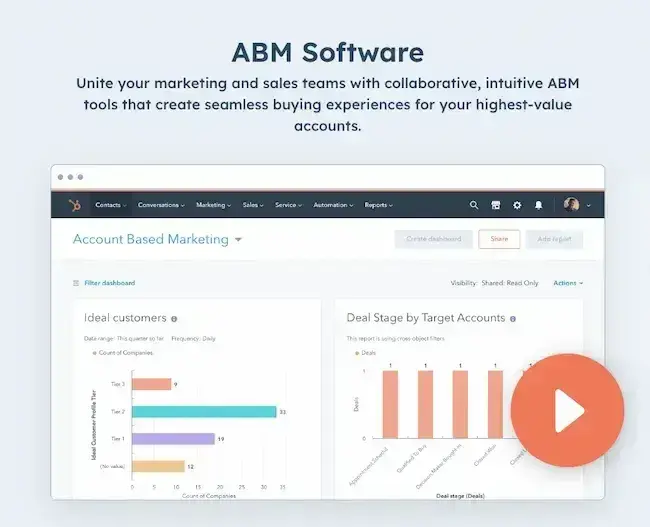
If you’re already using HubSpot for your CRM, trying out HubSpot’s ABM software only makes sense.
The thing I love about this software? I can easily set up workflows to help me identify high-value accounts, making it much easier to create my list of priority targets.
Plus, the tool is collaborative. If there’s one thing I’ve mentioned many times in this post, it’s that your sales and marketing teams need to align to make your ABM strategy sing. This tool helps you by giving everyone access to the same pertinent information to make better strategy decisions.
DemandBase

When I’m looking for a new tool, the user interface is one of the first things I evaluate. If a tool is too confusing to use, I’m out.
Thankfully, DemandBase is user-friendly and makes account-based marketing much more manageable. This tool allows for collaboration across the sales and marketing departments.
What I like about it (besides the user interface!) is that I can search for target accounts with recent intent signals. With this feature, my target account lists are up-to-date with the most recent information, helping me and my team craft better messaging and understand when we should reach out to targets.
RollWorks

If you’ve been in marketing for a while, you know your ICP is everything. What if you had an ABM tool that helped you identify accounts that match your ICP? It would be a game changer, right?
I have good news for you: RollWorks.
I like this tool for a couple of reasons. RollWorks is an ABM software that allows users to create their ideal customer profile to quickly identify target accounts that match it. This means you spend less time sorting through your data and more time connecting with the right targets.
I like this tool because it also allows users to run digital ad campaigns and automate certain sales functions, like outreach. Plus, it works across multiple platforms.
And the best news? It integrates with HubSpot. With the RollWorks and HubSpot integration, your ABM strategy is set up for success.
ABM automation tools allow your business to target key customers with a customized approach to seamlessly move them through the sales process. Account-based marketing training can also give your team an edge.
Check out this post if you want to learn more about ABM software.
Account-Based Marketing Examples
Now that you understand the fundamentals of an account-based marketing strategy, let’s walk through a few examples of how B2B account-based marketing has worked for real businesses.
1. Restaurant Furniture Plus
This wholesale restaurant furniture supplier relied on search traffic and paid Google ads to attract new customers.
But after identifying its ideal customer (scaling chain restaurants), the company employed an account-based marketing strategy to get in front of restaurant owners who were a good fit for its products.
This strategy has helped Restaurant Furniture Plus save money on paid advertising, and increase its base of recurring customers.
2. HealthLink Dimensions
Healthcare data company HealthLink Dimensions partnered with marketing agency Acclaro to create an account-based marketing strategy.
HeathLink Dimensions sought to expand its offerings to health insurance providers and ran into challenges getting new contacts in its funnel.
After working with Acclaro to use an ABM strategy, HealthLink Dimensions experienced a 234% increase in its new customer pipeline.
3. BlueYonder
BlueYonder is a supply chain management company that helps businesses optimize their supplier activities.
In 2019, the company began testing an ABM approach with a small group of accounts. This initial test leveraged advertising and personalized content for the initial group of accounts and resulted in $10 million generated in the pipeline.
B2B Account-Based Marketing
B2C companies typically focus their marketing efforts on touching a pain point or desire of the end-user, with hopes that the individual will decide to buy. B2B account-based marketing works a little differently.
When selling to other businesses, there is rarely one person making a purchasing decision. Depending on the size of the company you’re selling to, there may be an entire group of people who all give input on the final buying decision.
An ABM strategy can be particularly helpful for B2B companies that are looking to build long-term relationships with key accounts.
In fact, 81% of marketers who used ABM in 2024 reported an increased ROI compared to other forms of marketing.
LinkedIn Account-Based Marketing
84% of B2B marketers said they believe LinkedIn delivers the best value. This is why many companies use LinkedIn to connect. LinkedIn can be a beneficial platform for targeting accounts, especially for B2B companies.
LinkedIn has a feature called Company Targeting that allows you to use LinkedIn’s directory of over 13 million company pages for your ABM efforts.
With this tool, you can upload a list of companies you’d like to reach and create ad campaigns that can specifically target individuals at these companies.
Additionally, LinkedIn can help you create a more personalized experience for your target accounts through genuine relationship-building with your buying committee.
Using LinkedIn to find and engage with the right decision-makers at the companies you’d like to work with can be a helpful, thoughtful alternative to using third-party data to find potential contacts.
Here’s how Adobe used LinkedIn to support account-based marketing efforts.
Grow Better With Account-Based Marketing
Account-based marketing doesn’t have to be overwhelming. As Wingrove explained, it’s more about “where your company is in its phase of growth and how much money can you afford to go and spend and experiment on ABM.”
Although ABM can be pricey depending on the tools you use, Davidson mentioned that you don’t need to spend much of your budget on ABM. You can start with a simple spreadsheet and your CRM.
Don’t forget, you need buy-in from leadership, alignment from your sales team, and one willing sales rep to help you get started with this strategy.
By working through the tactics we’ve listed above and using software for your marketing and sales team to use together, you’ll find valuable accounts more efficiently, reduce any friction impacting your flywheel, and grow better.
Editor’s note: This post was originally published in March 2022 and has been updated for comprehensiveness.
![]()










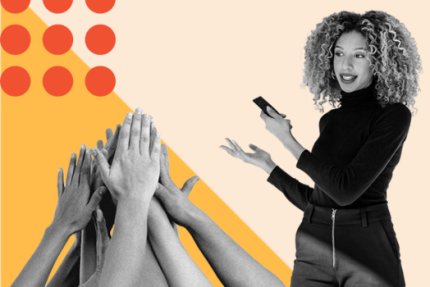
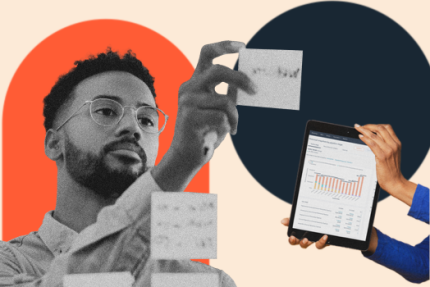


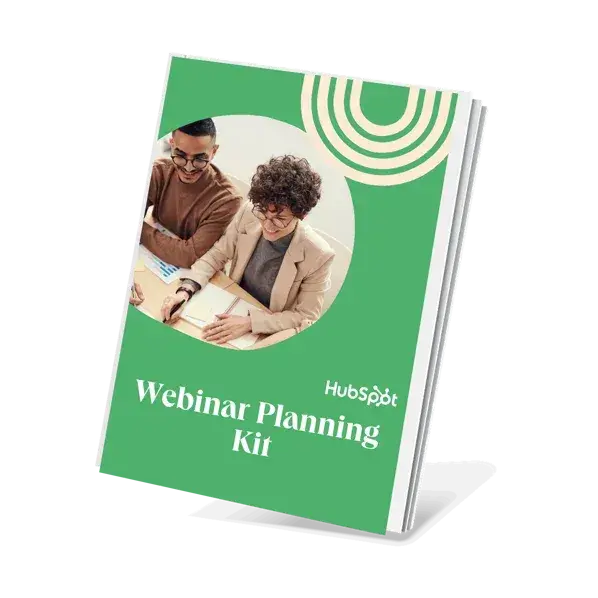
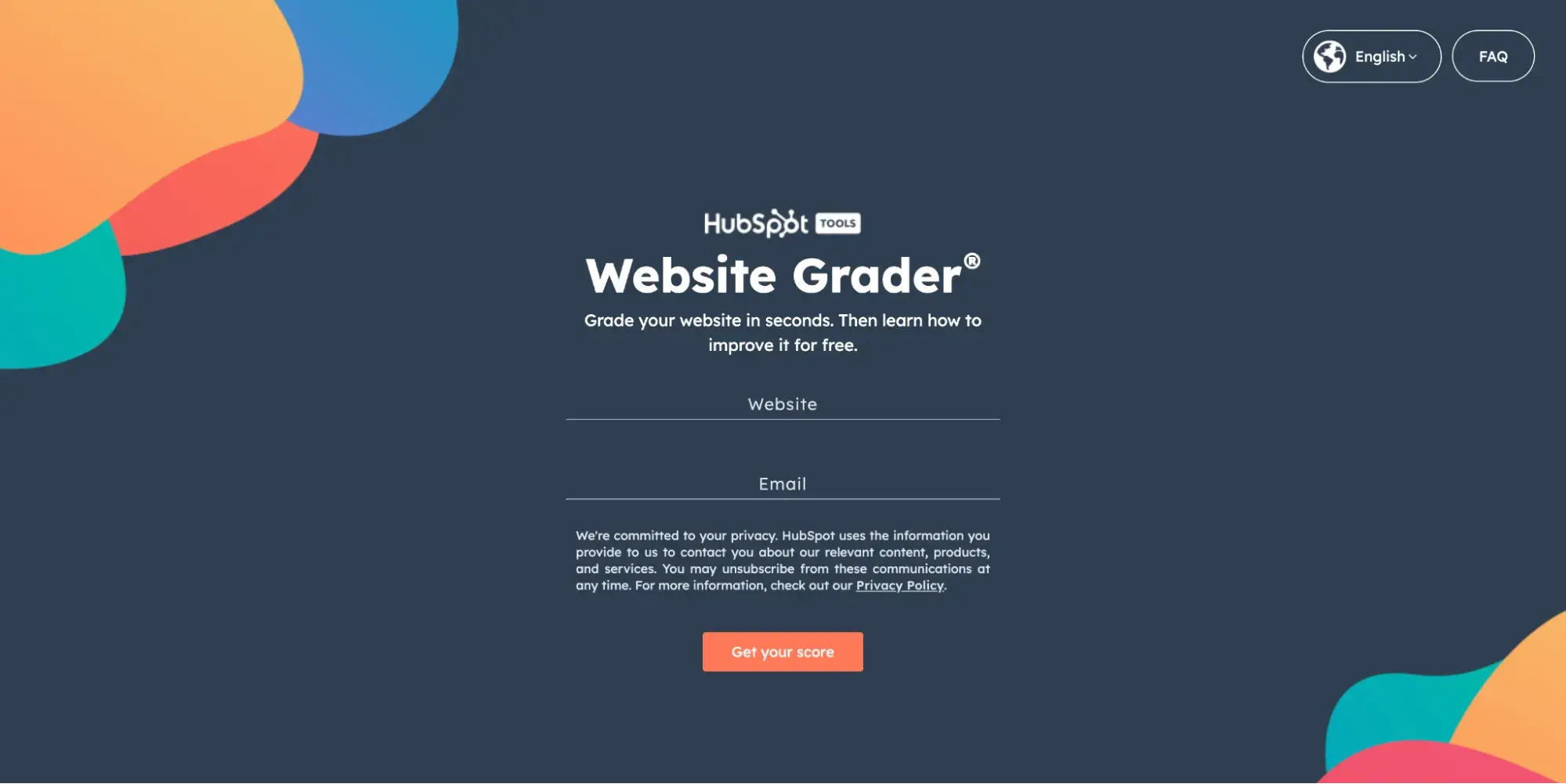
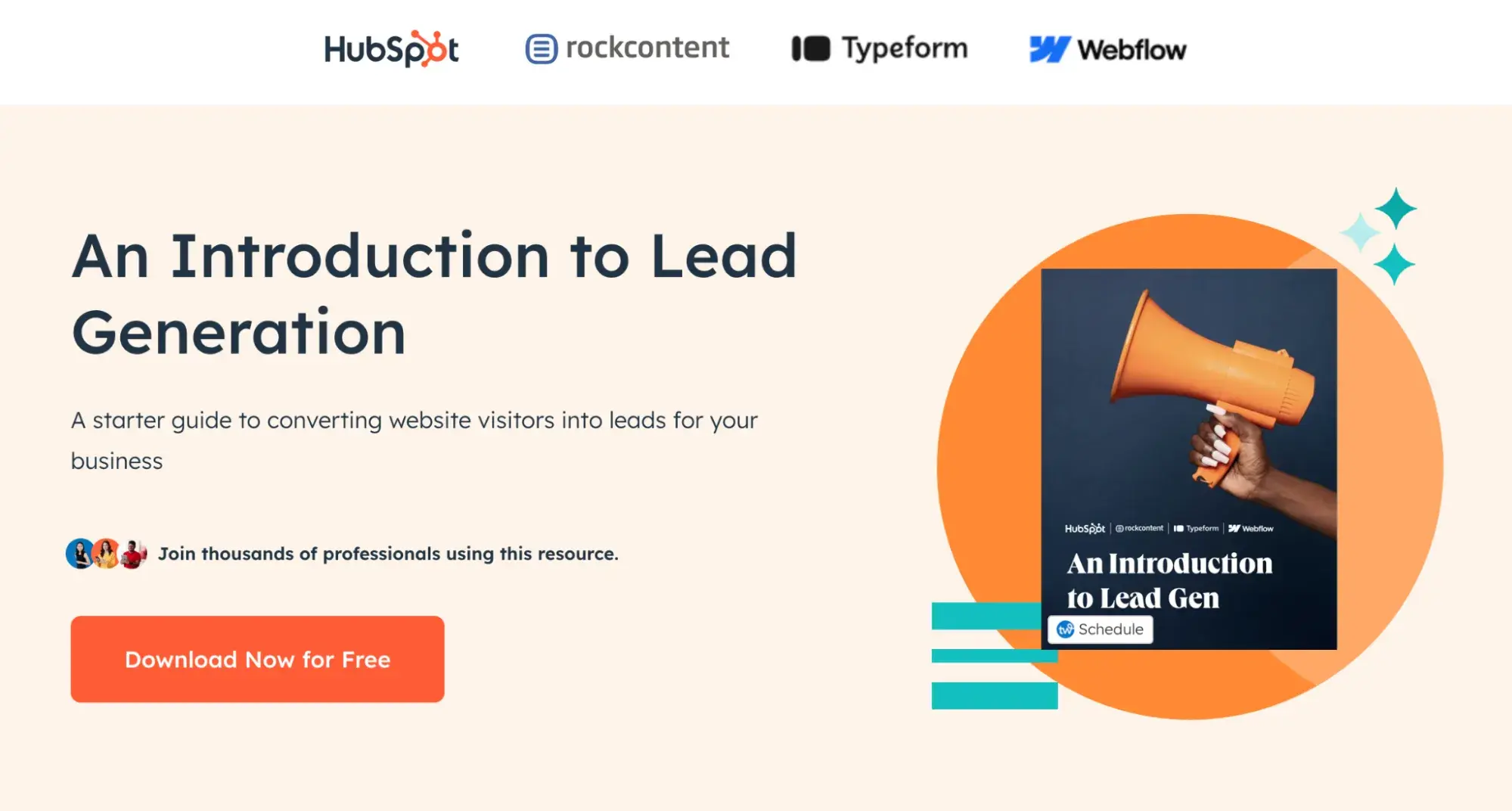
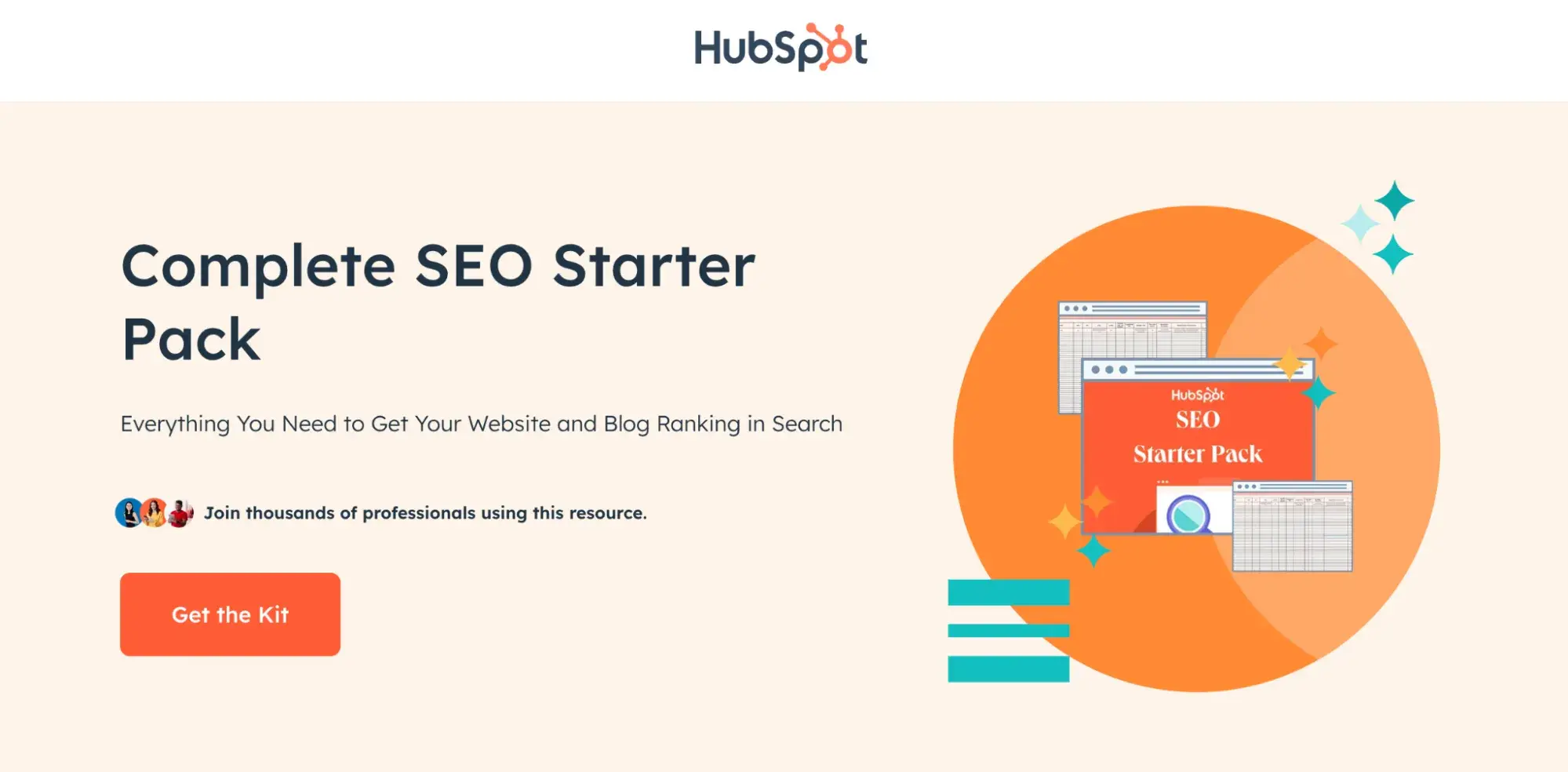
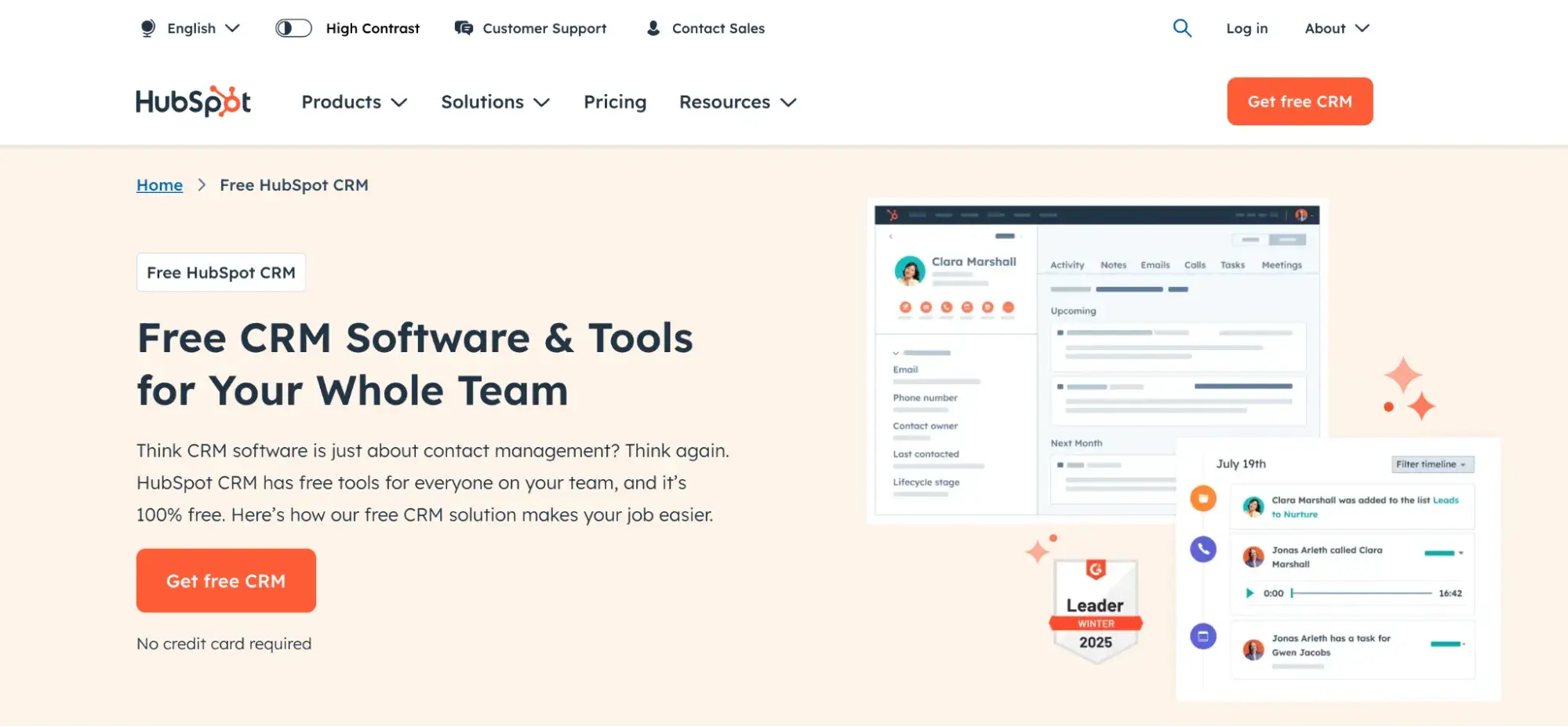



![New Data: Instagram Engagement Report [Free Download]](https://no-cache.hubspot.com/cta/default/53/9294dd33-9827-4b39-8fc2-b7fbece7fdb9.png)
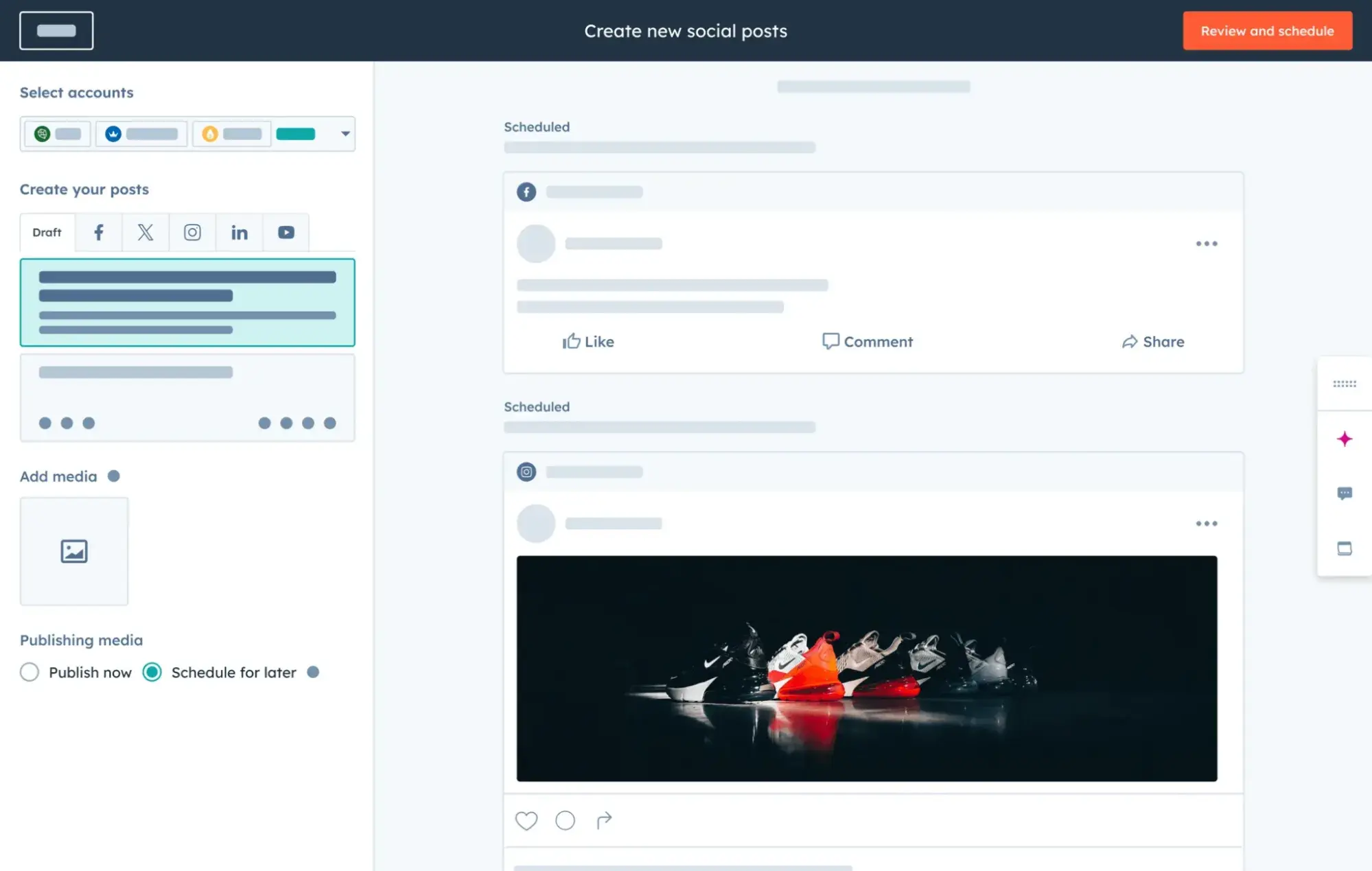

![Download Now: Job Description Templates [Free Prompts]](https://no-cache.hubspot.com/cta/default/53/1d91fe71-8e40-4c95-bb3f-bf8fe2bb08bc.png)


